If you delete or sell a coin, consider moving it to this account instead.
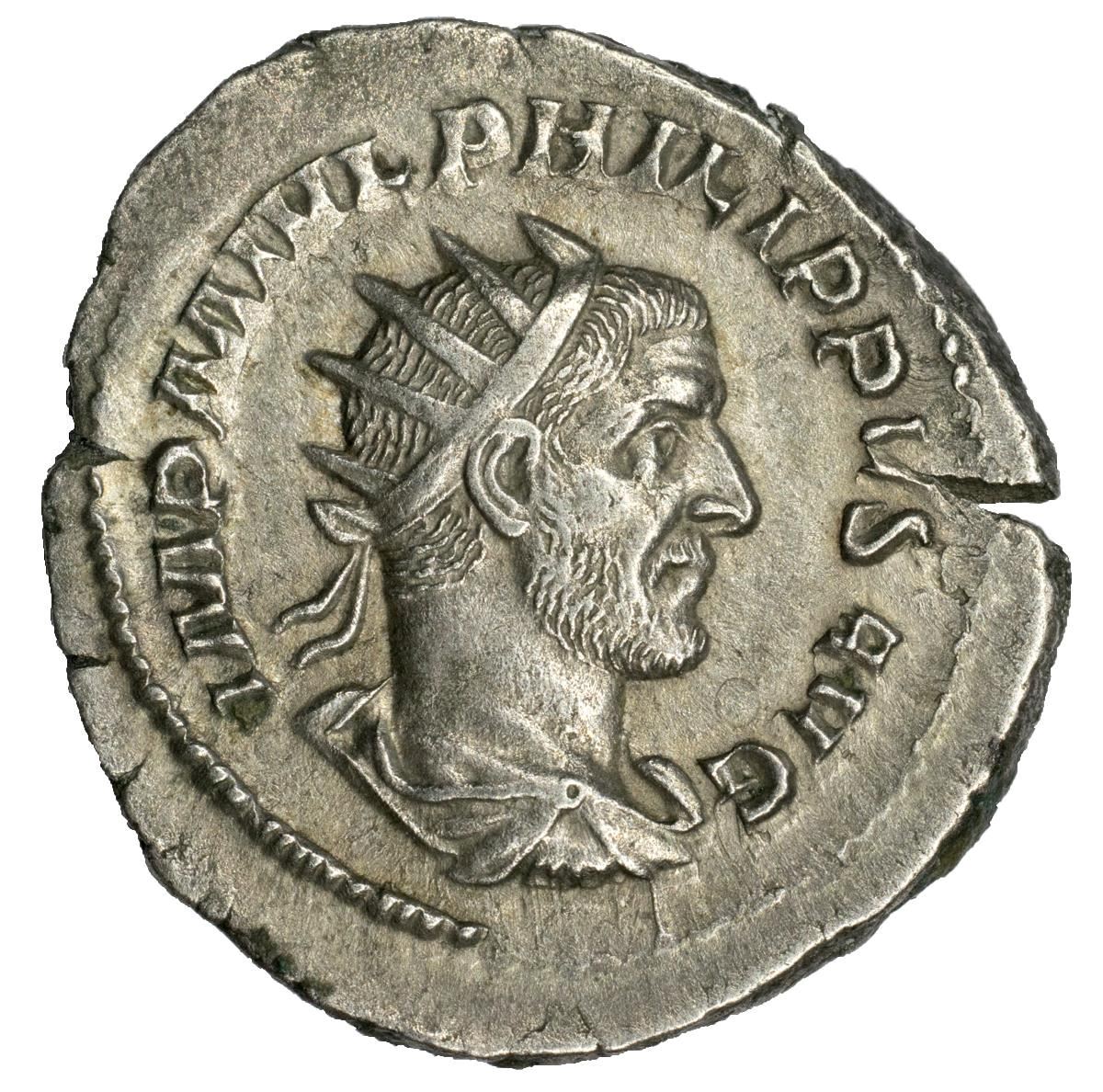
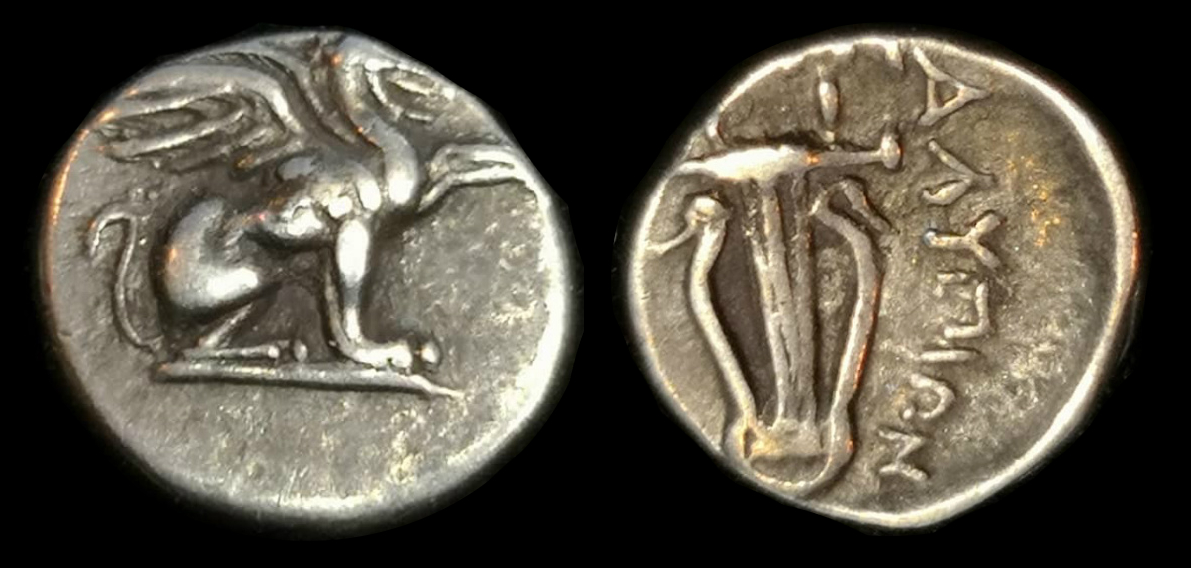
Reverse: Lyre
Die Orientation: -
Weight: 0.88 g
.jpg)
Reverse: prow left; ΣAΛ
Die Orientation: -
Weight: 2.4 g
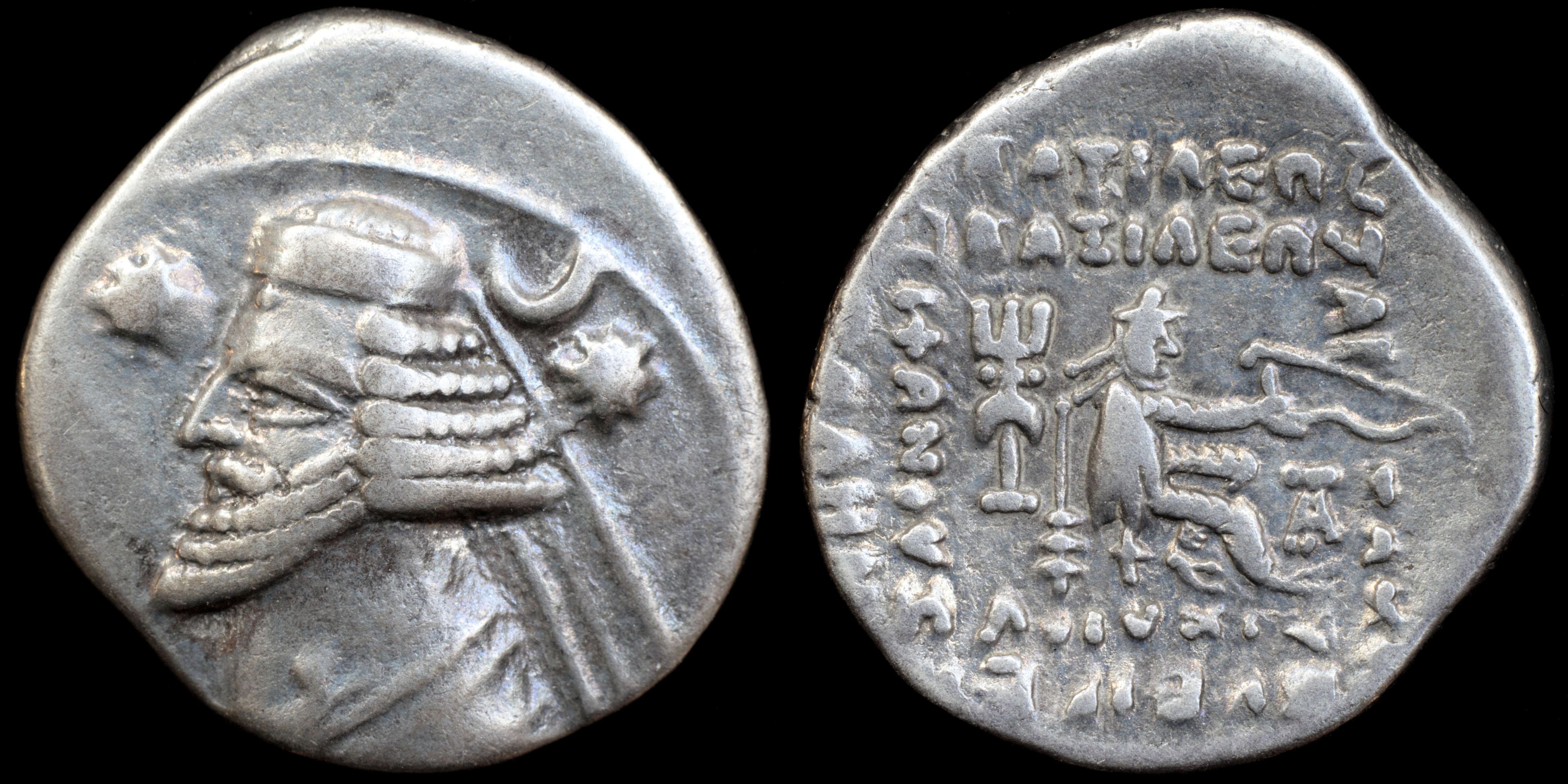
Reverse: archer seated on throne right, wearing balshyk and cloak, holding bow, anchor with trident-like end behind; BAΣIΛEΩΣ BAΣIΛEΩN APΣAKOY EYEPΓETOY ΔIKAIOY EΠIΦANOYΣ ΦIΛEΛΛHNOΣ, (TA)
Die Orientation: -
Weight: 4 g
.jpg)
Reverse: S·C inside laurel wreath of eight leaves
Die Orientation: 12 H
Weight: 14.77 g
I'm not sure what to make of the ^ under the bust, I see it on others sold of this #, but not all dies, signed die? workshop letter?
.jpg)
Reverse: ZEYΞIΣ ΦIΛAΛHΘHΣ ΛAOΔIKEΩN, Zeus Laodiceus standing facing left, holding eagle and scepter
Die Orientation: 12 H
Weight: 5.46 g
.jpg)
Reverse: M SALVIVS OTHO IIIVIR A A A F F, Inscription surrounding large SC
Die Orientation: 6 H
Weight: 9.57 g
RIC dates these coins to 7 BC, from metallurgical analysis, C. Pannekeet dates them to 5 BC in "The_moneyers_issues_under_Augustus.pdf"
Marcus Salvius Otho as Moneyer (Grandfather of the future Emperor of the same name. Reared in the household of Livia Augusta, he became a senator through her influence, and later held the position of Praetor.)
The obverse inscription translates to "Caesar Augustus, Chief Priest, Holding power of the Tribune of the Plebs"
The reverse inscription translates to "Marcus Salvius Otho, one of three magistrates responsible for the casting and striking of gold, silver, and bronze
SC stands for "senatus consultum", a decree of the senate.
.png)
Reverse: CN PISO CN F IIIVIR AAAFF, Inscription around large SC
Die Orientation: 4 H
Weight: 11.07 g
RIC dates to 15 BC and 14 BC comes from:
The_moneyer_issues_under_Augustus.pdf by C.G.J. Pannekeet
The obverse inscription translates to "Augustus, Holding power of the Tribune of the Plebs"
The reverse inscription translates to "Gnaeus Piso, son of Gnaeus, One of three magistrates responsible for the casting and striking of gold, silver, and bronze coinage.
SC stands for "senatus consultum", a decree of the senate.
.png)
Reverse: ASIA RECEPTA, Victory standing facing left, holding wreath and palm, on top of cista mystica, serpents at left and right
Die Orientation: 1 H
Weight: 1.66 g
RSC has this to say:
"The subjection of the Province of Asia occurred in B.C. 30."
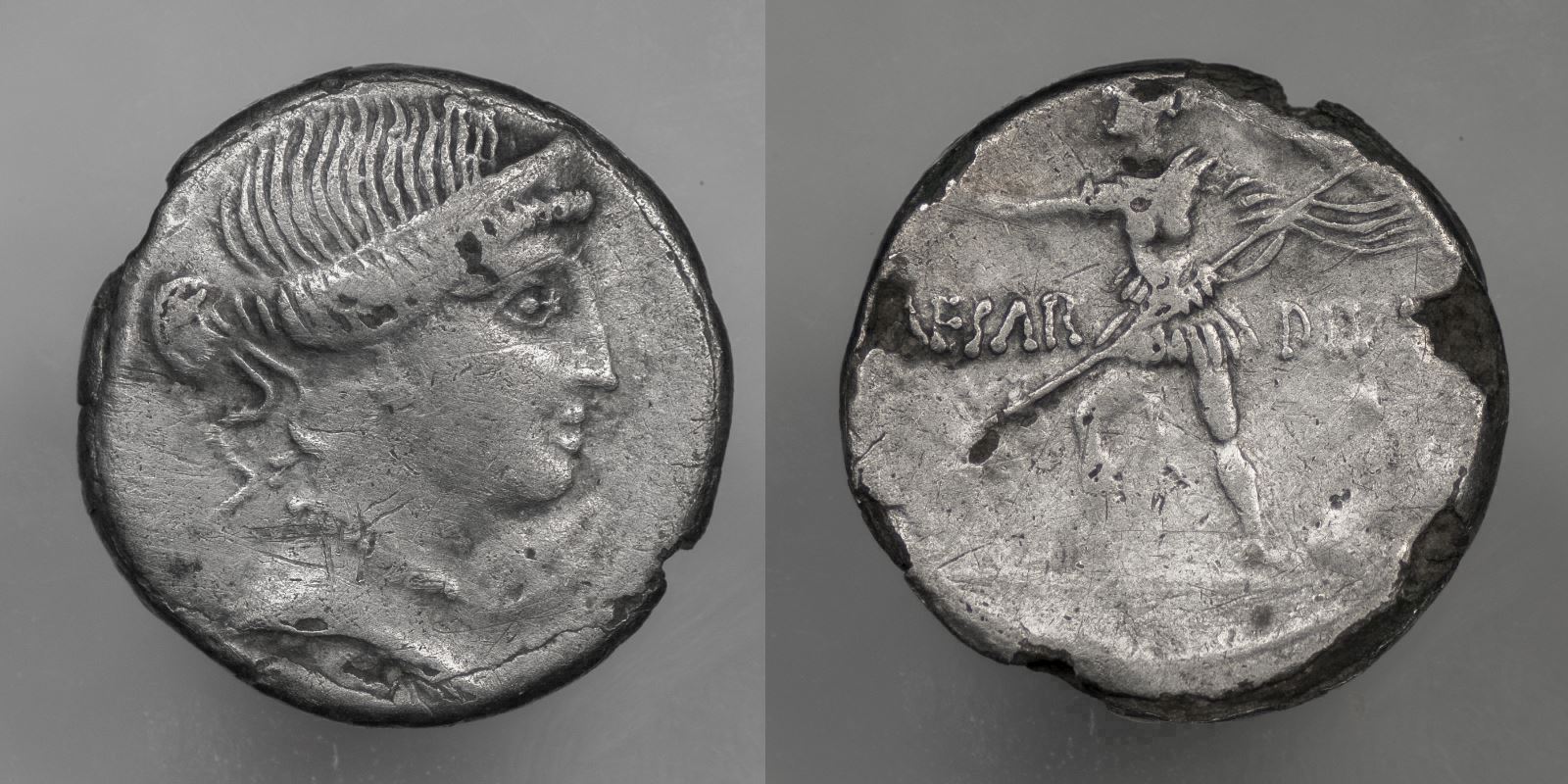
Reverse: CAESAR DIVI F, Octavian in military dress, cloak flying behind, advancing left, right arm extended, left hand holding transverse spear
Die Orientation: 6 H
Weight: 2.54 g
The below quote from forumancientcoins.com puts the coin in context:
"In July 32 B.C., Octavian illegally obtained Antony's will and exposed it to the Roman public: it promised substantial legacies to Antony's children by Cleopatra and left instructions for shipping his body to Alexandria for burial. Rome was outraged, and the Senate declared war against Cleopatra (an important distinction, because Octavian did not want the Roman people to consider it a civil war). Octavian's forces decisively defeated the forces of Antony and Cleopatra at the Battle of Actium in Greece in September 31 B.C. In 30 B.C., Octavian chased Antony and Cleopatra to Egypt where they committed suicide. Octavian became master of the Roman world."
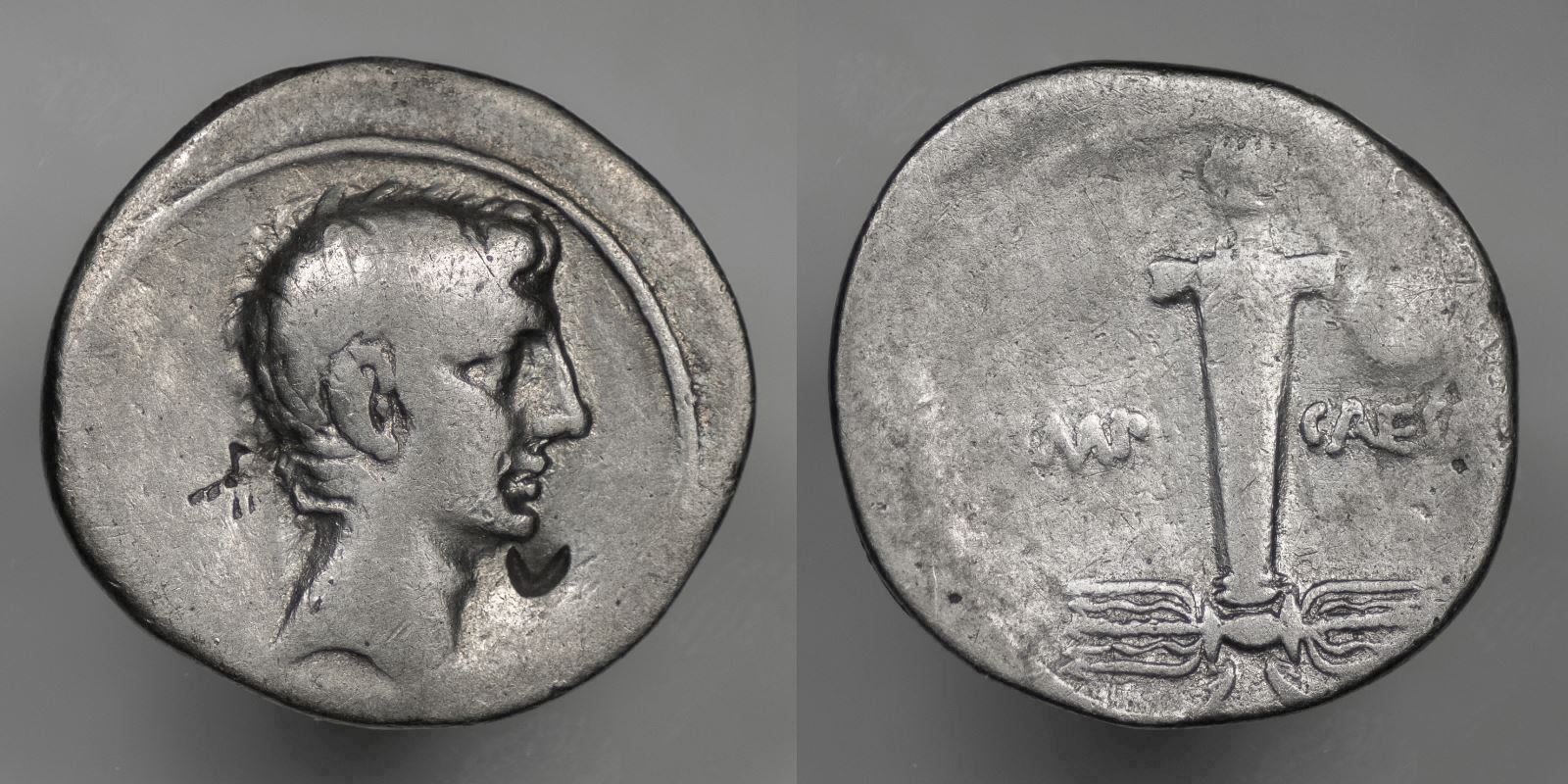
Reverse: IMP CAESAR, Facing head of Octavian on ithyphallic boundary stone of Jupiter Terminus, winged thunderbolt below
Die Orientation: 5 H
Weight: 3.53 g
Uncertain mint in Italy, maybe Rome or Brundisium per RIC.
The following quote from forumancientcoins.com puts this coin in context:
"this propaganda referred to Octavian's re-establishment of boundaries in the east after the battle of Actium and review of the client kingdoms established by Marc Antony (in particular return of Roman territory from Cleopatra and her children)"
.jpg)
Reverse: Apollo Citharoedus of Actium standing facing, head to left, holding plectrum in his right hand and lyre in his left; IMP X in fields; ACT in exergue
Die Orientation: 2 H
Weight: 3.31 g
The obverse translates to "Augustus, son of the Divine (referring to Julius Caesar)"
IMP X translates to "Commander-in-Chief for the 10th time", and ACT is short for Actium.
.jpg)
Reverse: IVLIA TRAD in two lines within oak wreath
Die Orientation: 2 H
Weight: 8.92 g
The obverse inscription translates to "[struck with] Permission of Caesar Augusuts"
The reverse inscription translates to "Julia Traducta"
.jpg)
Reverse: CAESAR AVGVSTA L CASSIO C VAL FEN, Vexillum on base; II VIR to left and right
Die Orientation: 4 H
Weight: 5.34 g
The obverse inscription translates to "Augustus, son of the Divine (referring to Julius Caesar)"
The reverse inscription translates to "Caesaraugusta, to Lucius Cassius and Gaius Valerius Fene(stella?) as two magistrates to govern the colony
.jpg)
Reverse: COL NEM, Crocodile chained to palm-shoot with tip right; above palm-tip left a wreath with long ties
Die Orientation: 12 H
Weight: 12.65 g
The reverse symbolizes the capture of Egypt after the Battle of Actium, and the soldiers that won that battle were granted land in Colonia Nemausus.
.jpg)
Reverse: ROM ET AVG, Front elevation of the Altar of Lyons, decorated with the corona civica between laurels, these being flanked by nude male figures to left and right, Victories on columns facing eachother
Die Orientation: 4 H
Weight: 9.56 g
Translations:
Obverse: Caesar, High Priest
Reverse: To Rome and Augustus
The Sanctuary of the Three Gauls was founded by Drusus (stepson of Augustus) to federalize and Romanize this area as an Imperial province under Augustus following the Gallic wars of his predecessor Julius Caesar.
.jpg)
Reverse: C CAESAR AVG F PONT COS, Bare head of Gaius Caesar facing right
Die Orientation: 11 H
Weight: 9.94 g
Translations:
Obverse: "Caesar Augustus, Father of the Fatherland"
Reverse: "Gaius Caesar, son of Augustus, Priest, Consul"
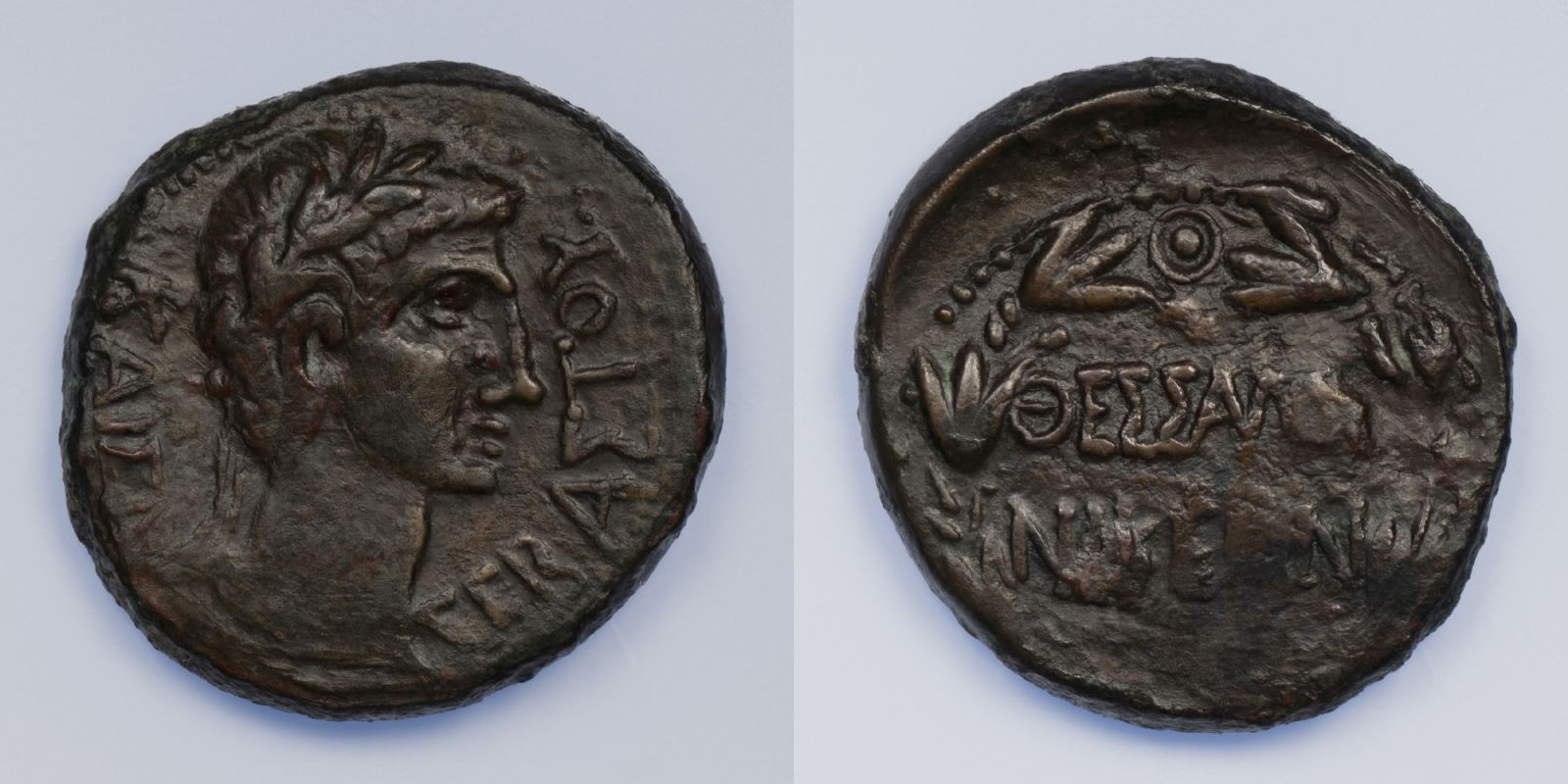
Reverse: ΘΕΣΣΑΛΟΠΙΚΕΩΠ, Inscription in two lines within laurel wreath
Die Orientation: 12 H
Weight: 10.24 g
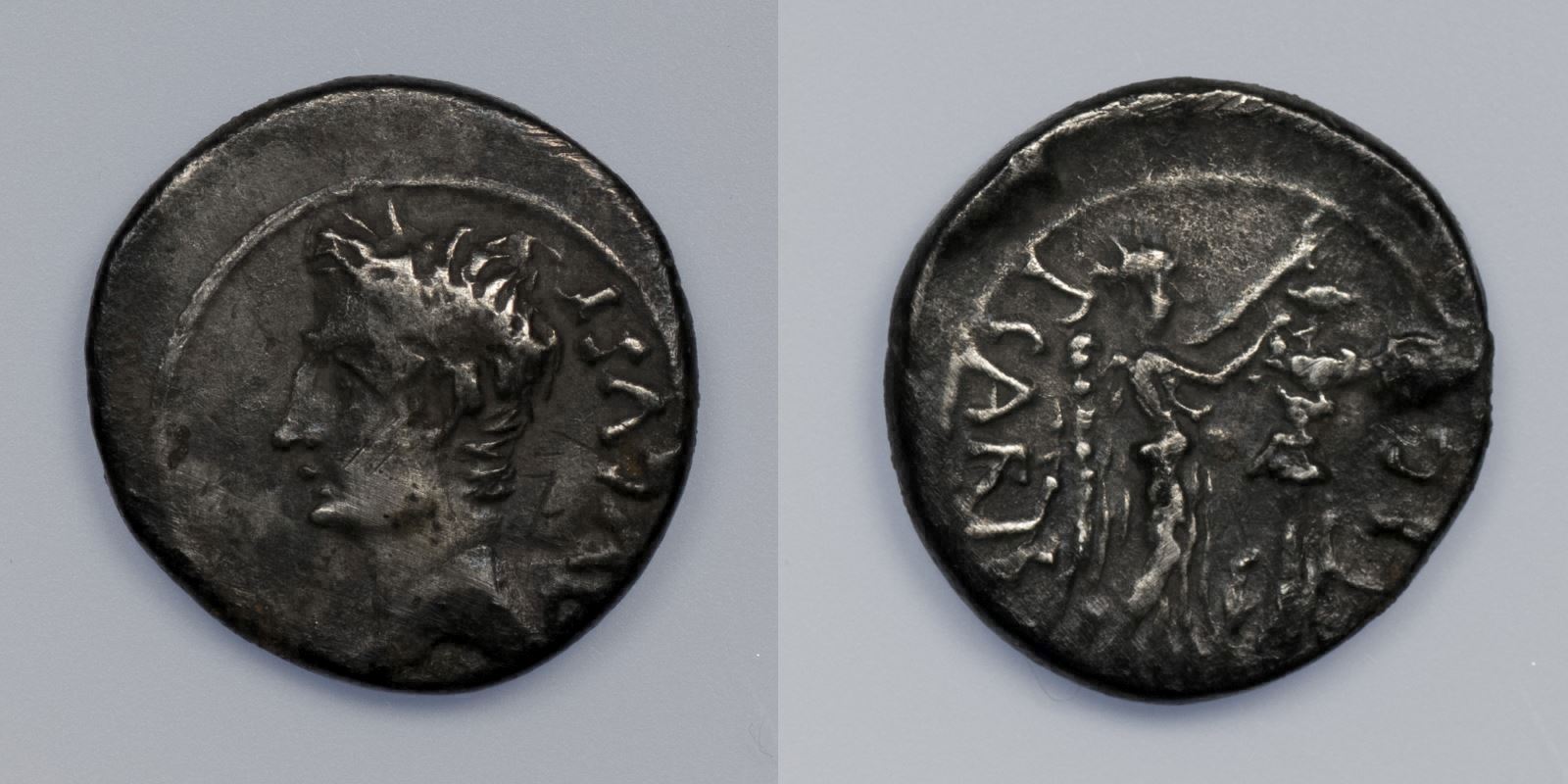
Reverse: P CARISI LEG, Victory standing facing right, crowning trophy of captured arms, dagger and curved sword at base
Die Orientation: 12 H
Weight: 1.79 g
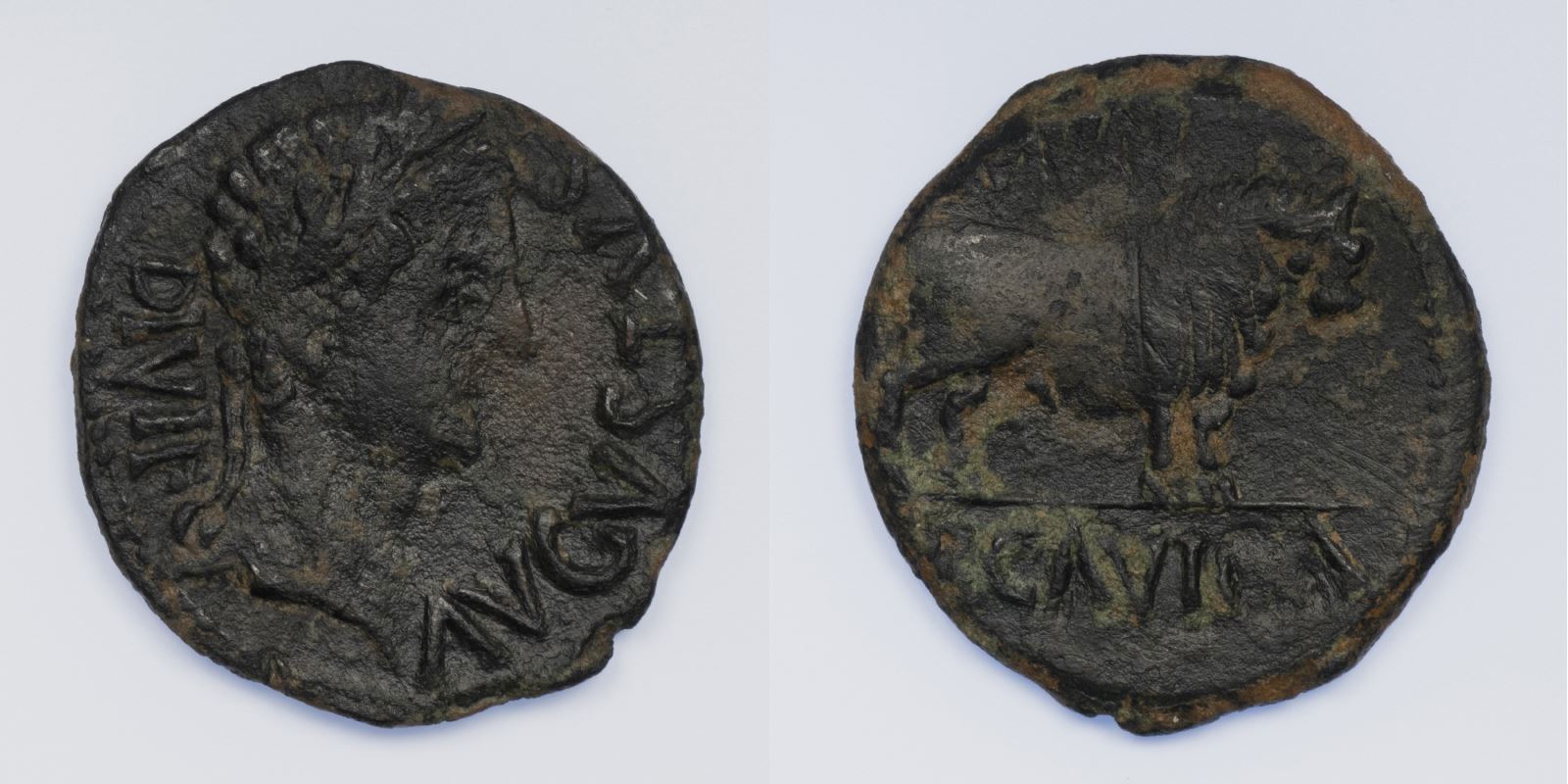
Reverse: MVN ERCAVICA, Bull standing facing right
Die Orientation: 1 H
Weight: 9.34 g
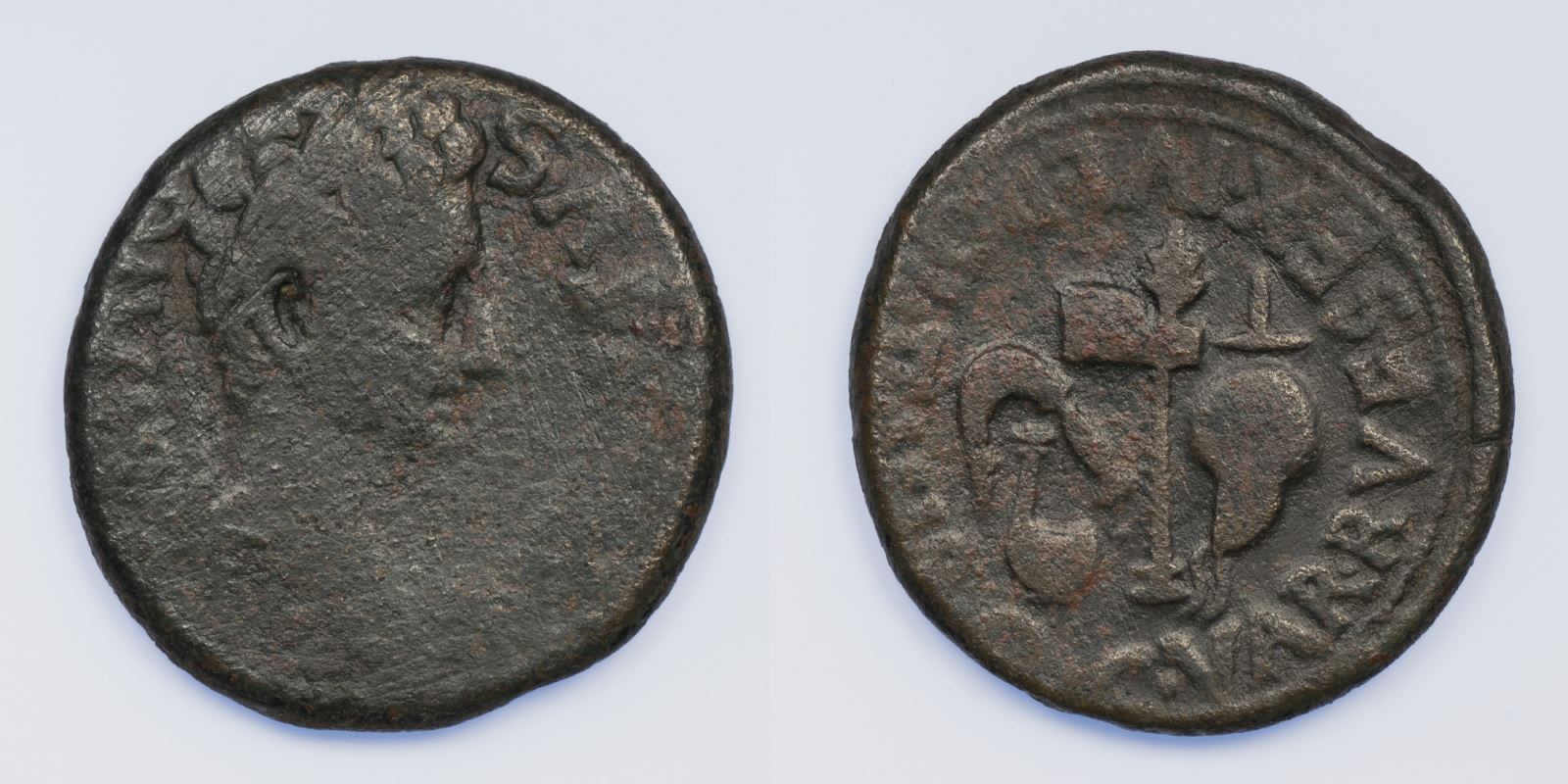
Reverse: C VAR RVF SEX IVL POL II VIRQ, Simpulum, aspergillum, securis, and apex
Die Orientation: 5 H
Weight: 13.92 g
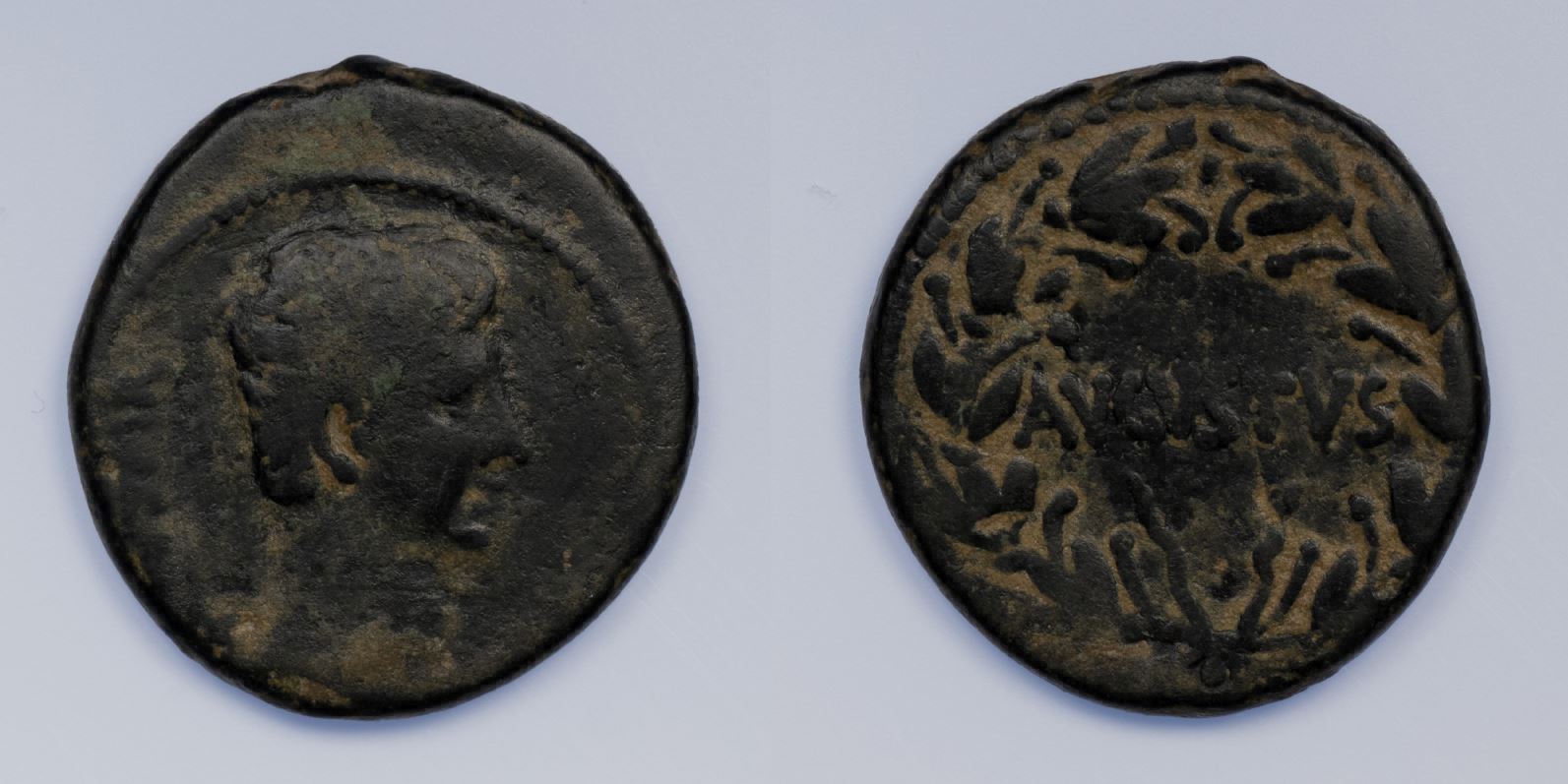
Reverse: AVGVSTVS, Inscription inside laurel wreath
Die Orientation: 11 H
Weight: 10.8 g
Tziambazis believes it to be of Cypriot origin. Needless to say, the scattered find evidence makes the coin remain an enigma.
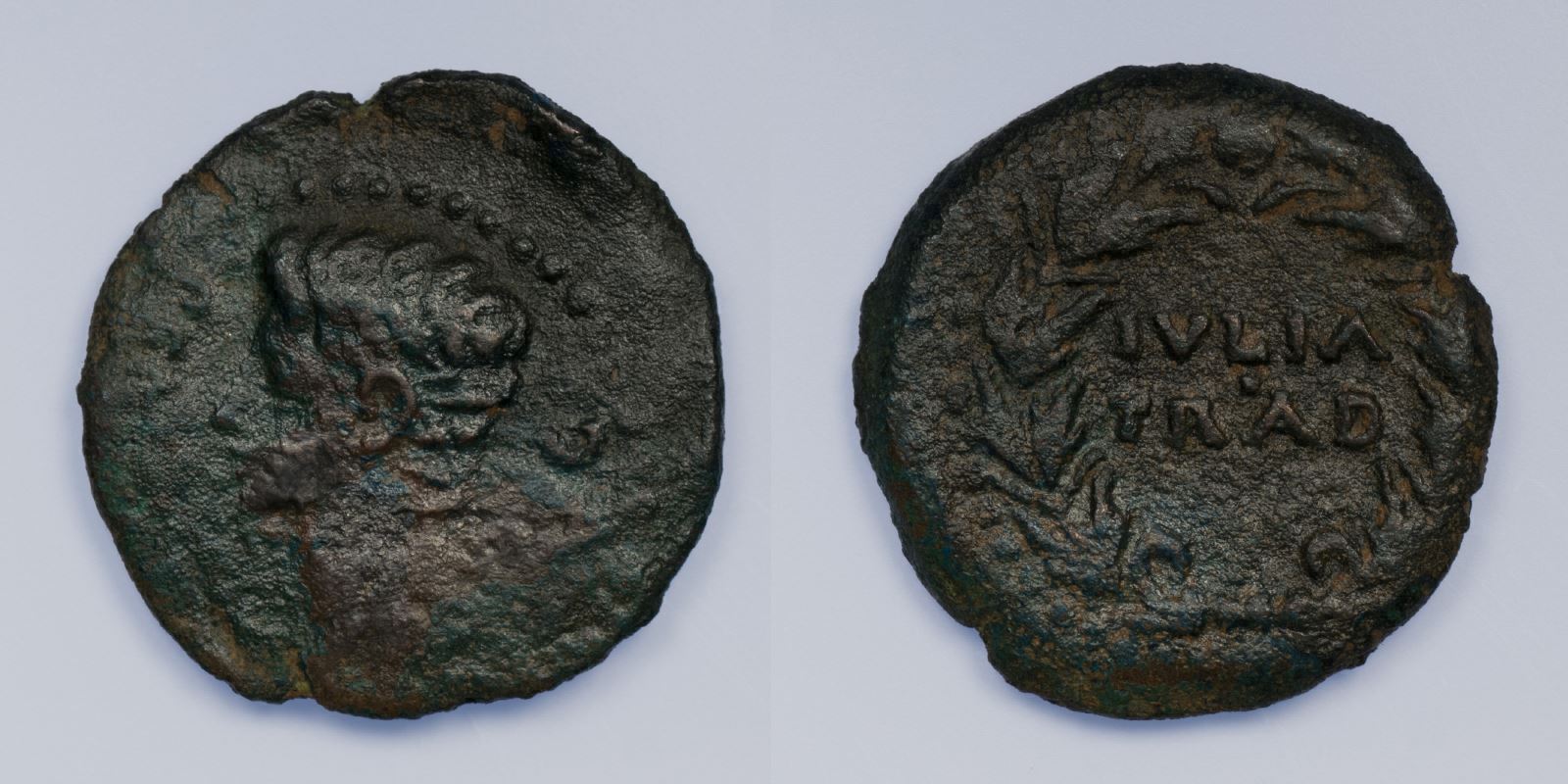
Reverse: IVLIA TRAD in two lines within oak wreath
Die Orientation: 10 H
Weight: 7.91 g
The obverse inscription translates to "[struck with] Permission of Caesar Augusuts"
The reverse inscription translates to "Julia Traducta"
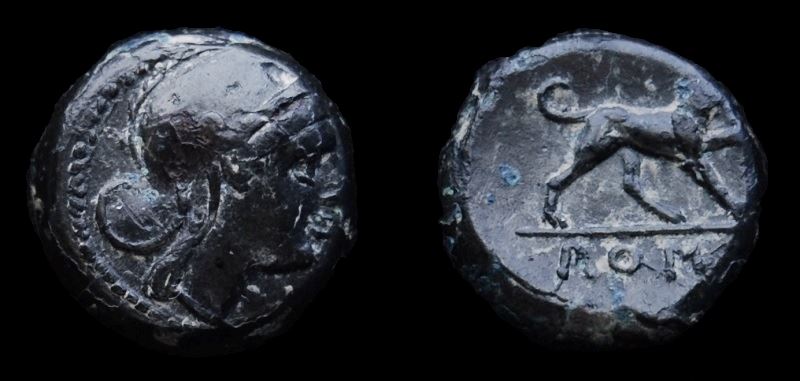
Reverse: Dog standing right, raising forepaw; ROMA in exergue.
Die Orientation: -
Weight: 1.79 g
.jpg)
Reverse: Bull butting to the right; IMP•X in exergue
Die Orientation: 12 H
Weight: 2.18 g
.jpg)
Reverse: III VIR AAAFF surrounding large SC
Die Orientation: 10 H
Weight: 3 g
.jpg)
Reverse: C V I CEL L BAGGIO MN FESTO II VIR, Bull standing facing right
Die Orientation: 12 H
Weight: 9.83 g
RPC notes a dating of 17 BC or later given the use of DIVI F in the name
.jpg)
Reverse: COS ITER ET TER DESIG, Pontifical emblems: simpulum, aspergillum, jug, and lituus
Die Orientation: 6 H
Weight: 3.57 g
.jpg)
Reverse: Equestrian statue with Octavian, facing left; S·C in exergue
Die Orientation: 6 H
Weight: 3.25 g
"This is a favourite type coin for me as it is the first appearance of Octavian on a coin. Very often found in low grade, it is nonetheless a very historically important coin. It’s a great piece of history at a low price! Here you see a young Octavian for the first time on the obverse. The reverse shows the equestrian statue that he demanded the senate build for him after putting down the siege at Mutina. It is a brazen display of Octavian’s contempt for the senate."
.jpg)
Reverse: Altar of Lugdunum, highly decorated with corona civica, laurels, and nude male figures; Victories flanking; ROM ET AVG in exergue
Die Orientation: 9 H
Weight: 10.22 g
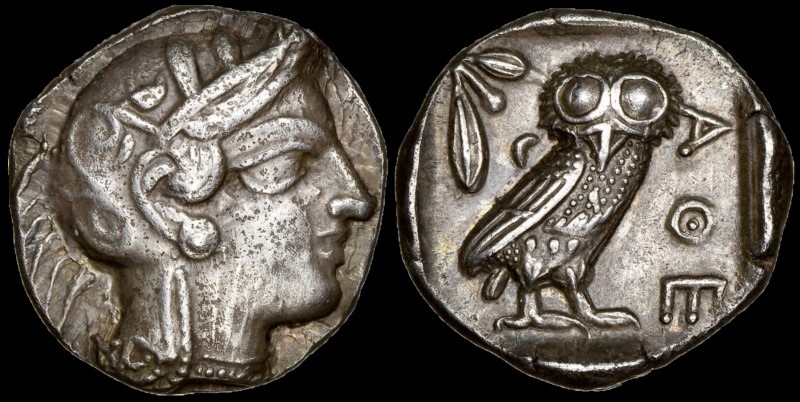
Reverse: Owl standing right, head facing; olive sprig and crescent to left; all within incuse square.
Die Orientation: 9 H
Weight: 17.03 g
.jpg)
Reverse: MENANΔPOC ΦIΛOKAICAP OTΔ, Head of Helios facing right, wearing crown
Die Orientation: 12 H
Weight: 5.58 g
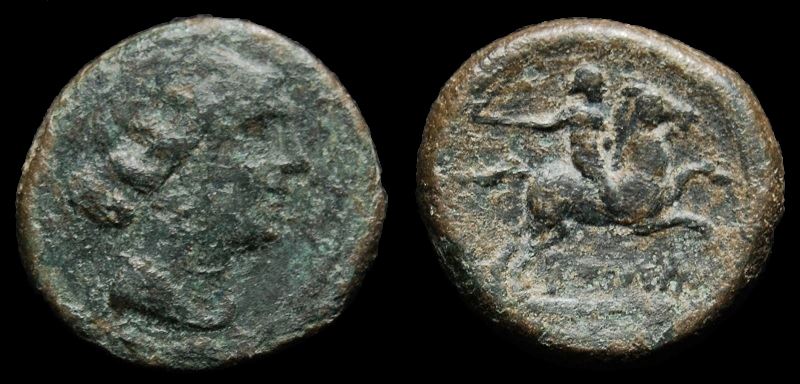
Reverse: Nude rider, holding whip, on horse prancing right; below, ROMA.
Die Orientation: -
Weight: 6.68 g
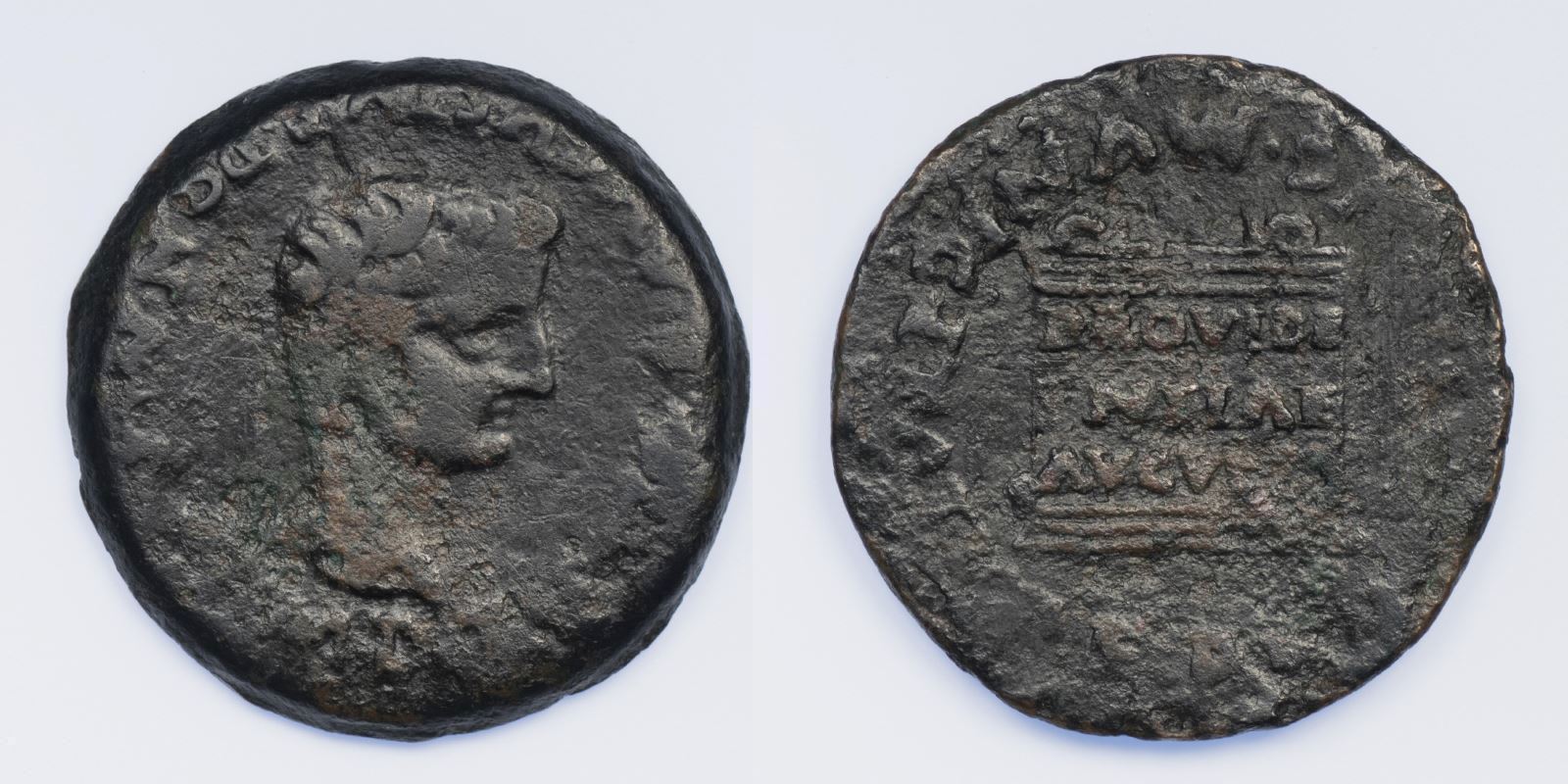
Reverse: MVNIC ITALIC PERM DIVI AVG, Altar inscribed PROVIDENTIAE AVGVSTI in three lines
Die Orientation: 1 H
Weight: 13.59 g
.jpg)
Reverse: Blundered Inscription, Caduceus between crossed cornucopias
Die Orientation: 12 H
Weight: 9.6 g
In 17 AD when Antiochus III of Commagene died, Tiberius annexed Commagene to the province of Syria. RIC is confident in the attribution to this mint, RPC is hesitant with Antioch being another possibility based on find evidence. RIC dates to 19-21 AD, whereas RPC goes with 19-20 AD.
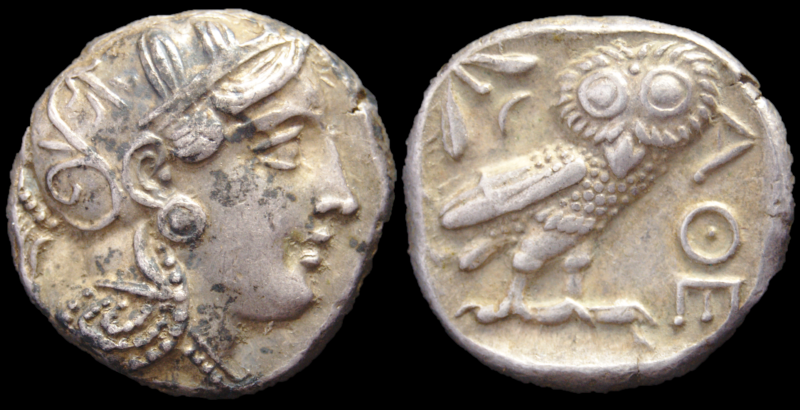
Reverse: Owl standing right, head facing, olive sprig and crescent moon behind, all in square incuse.
Die Orientation: 8 H
Weight: 17.18 g
Provenance: Heritage Auctions - Weekly Auction 232128 (15 July 2021), lot 130; Ex Stack's Bowers and Ponterio, NYINC Sale 173 (8 January 2013), lot 160; Demarete Collection (Elvira Clain-Stefanelli).
.jpg)
Reverse: Prow right, ROMA above, pellet below.
Die Orientation: 12 H
Weight: 11.16 g

Reverse: The Dioscuri, each holding spear, on horseback right; two stars above; ROMA in exergue.
Die Orientation: 3 H
Weight: 3.86 g
“This variety is believed to be one of the earliest issues of 53/2 based on its consistent presence (though in small numbers) in early hoards where contents included 53/2 examples. It is nearly always found with a loop under the visor, believed to be an attribute of Sicilian origin. There are no symboled siblings for this group.”
Obverse: There is usually a small loop under the visor in front of the forehead. The loop is often discretely represented as a small lump, other times it is clearly a loop.Tufts at the back of the helmet are very small and close together.
Reverse: More so than any other variety in this issue, the horses appear to be rearing up, rather than galloping forward, particularly the far horse, with forelegs farther above the exergue than on other varieties. The legend ROMA is in a trapezoidal frame. Cape style is Flag-like or Waving. There is nearly always a pointed horse's tail visible between the legs. The horses and riders appear rather small and distant, compared to other varieties.
Exceptions: There are rare examples that are clearly of this style but with horses that are galloping broadly forward rather than rearing up."
Provenance: CNG Electronic auction 408 (25 October 2017), lot 368, from the Andrew McCabe Collection. Ex Vecchi 13 (4 September 1998), lot 631.
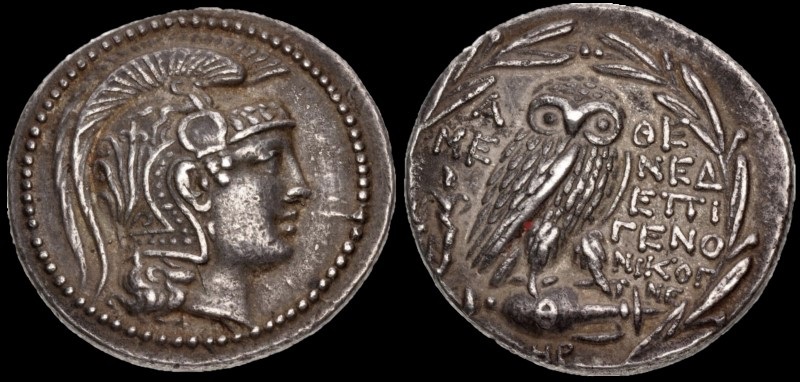
Reverse: Owl standing right, head facing, on amphora; magistrates’ names in fields; to left, Asklepios standing left, holding serpent-entwined scepter; Θ on amphora, HP below; all within wreath.
Die Orientation: 12 H
Weight: 16.46 g
Provenance: Triton XXV Session 5 (25 January 2022), lot 75.
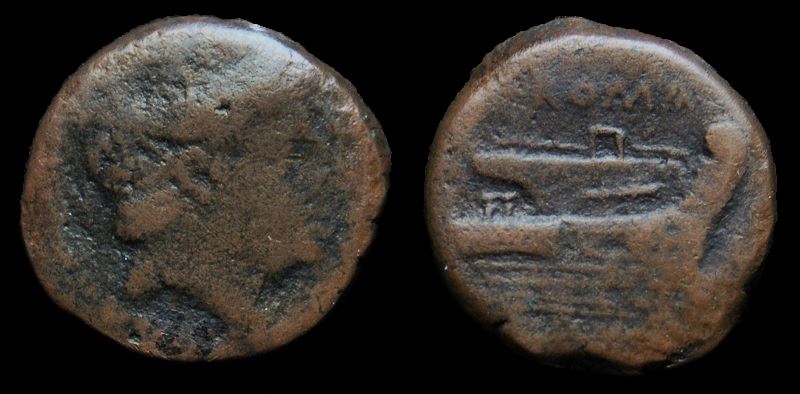
Reverse: Prow of galley right; ROMA above.
Die Orientation: -
Weight: 5.32 g
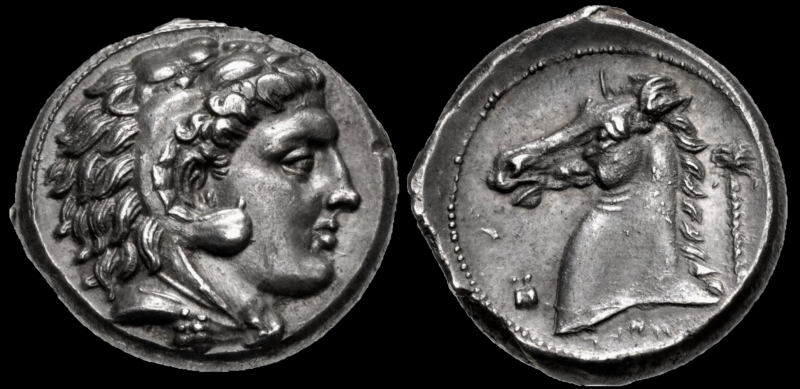
Reverse: Horse’s head left; astragalos to left, palm tree to right, Punic MḤSBM below.
Die Orientation: 3 H
Weight: 16.71 g
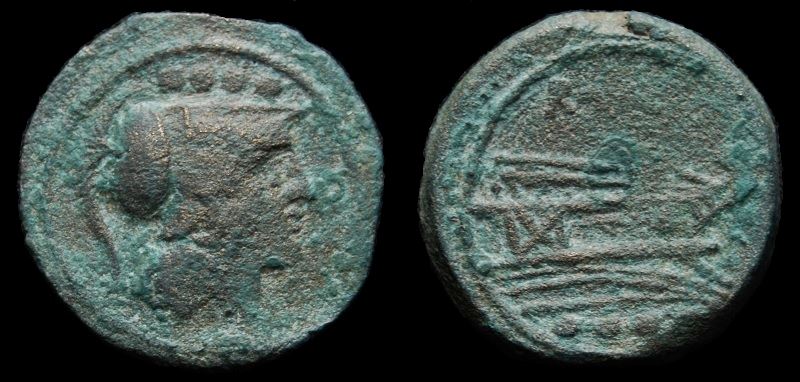
Reverse: Prow right, ROMA above, four pellets below.
Die Orientation: -
Weight: 13.97 g
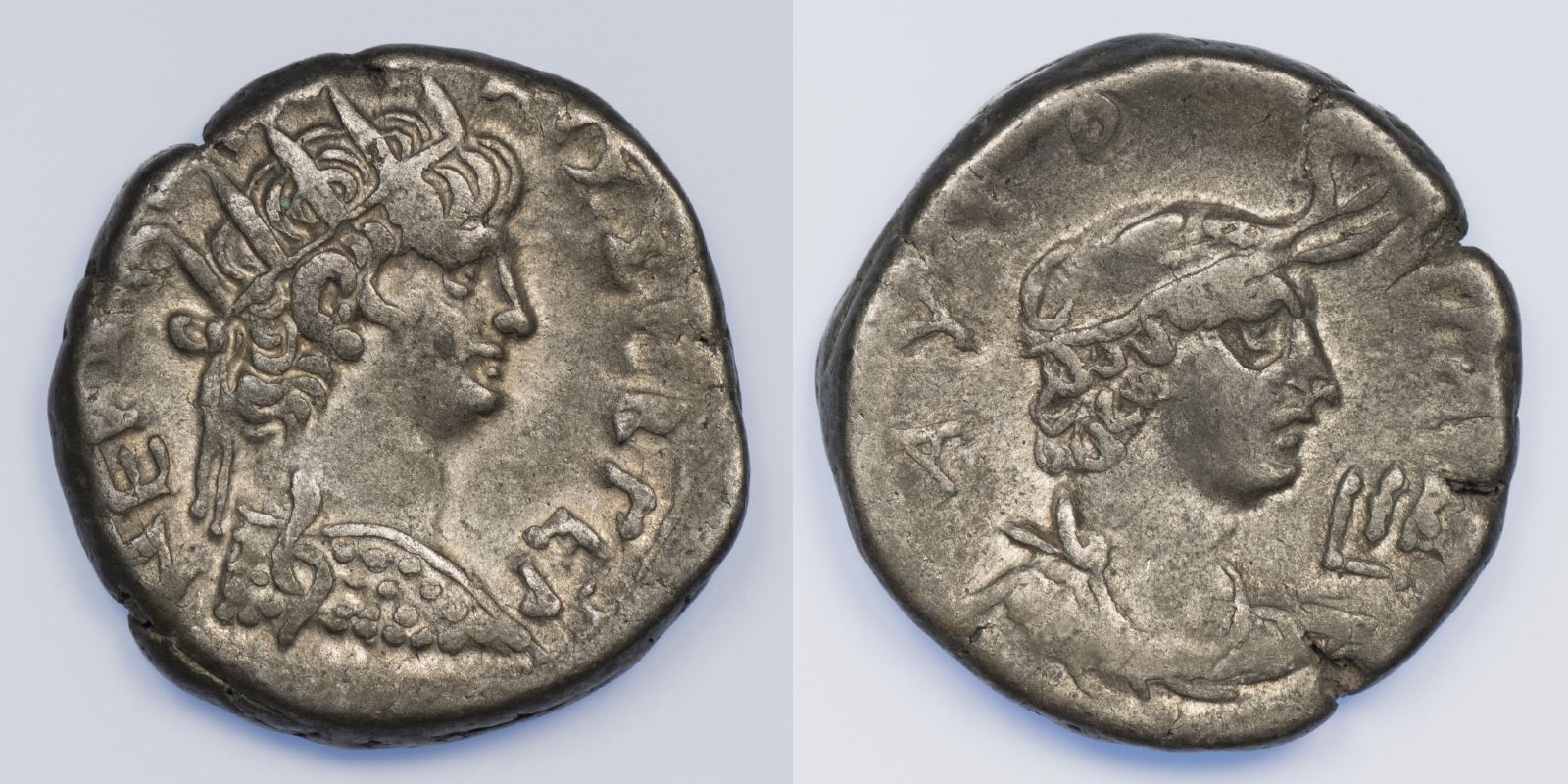
Reverse: AYTOKPA, Bust of Alexandria facing right, wearing elephant-skin headdress, and drapery; LIB in right field
Die Orientation: 11 H
Weight: 13.81 g
The reverse inscription translates to: "Commander-in-Chief" and LIB=Year 12 of his reign, which corresponds to 65-66 AD
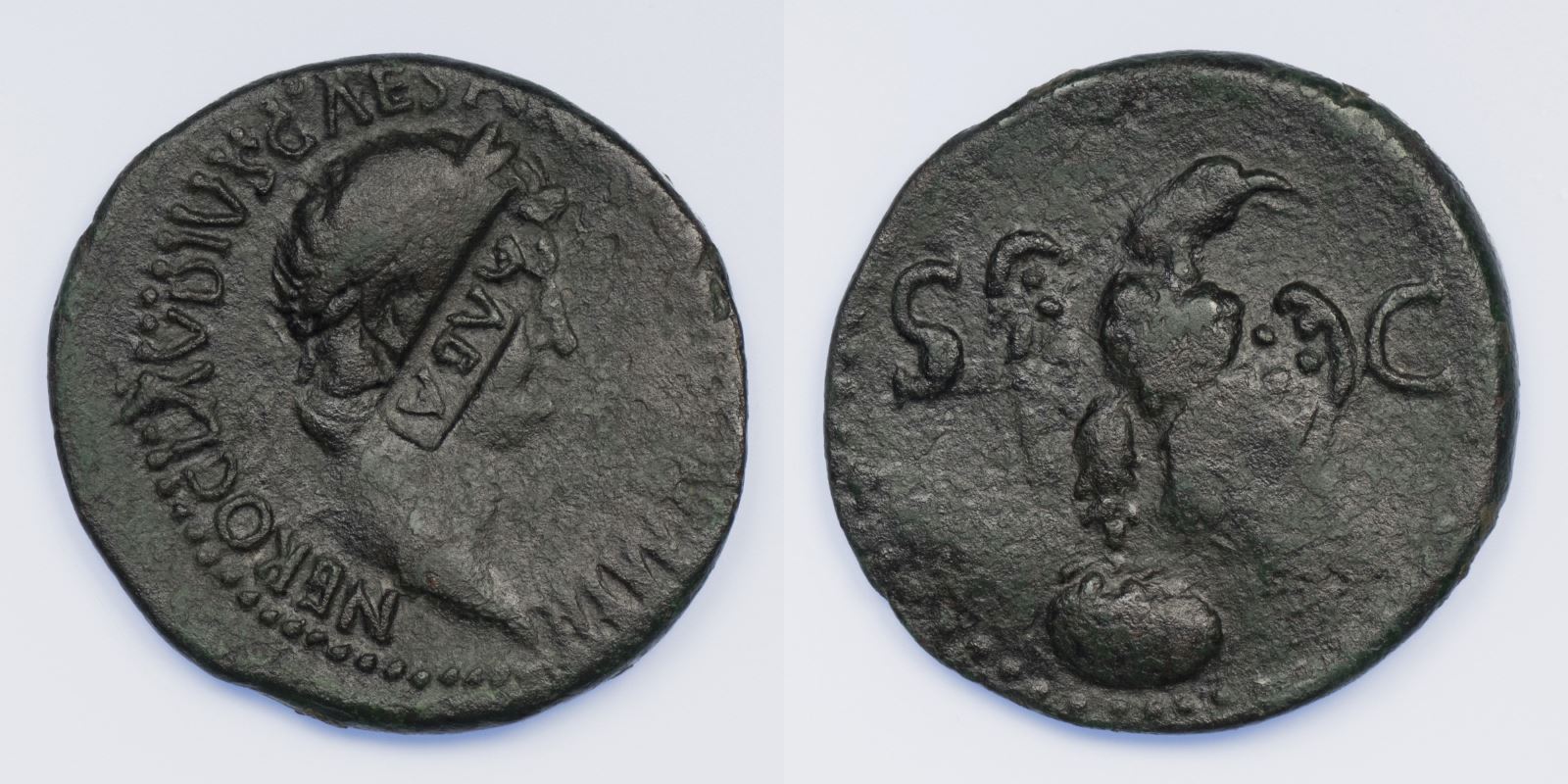
Reverse: Eagle standing facing right on globe; SC in fields
Die Orientation: 6 H
Weight: 9.68 g
The countermark of course translates to "Galba", very intentionally struck over Nero's face.

Reverse: The Dioscuri, each holding spear, on horseback right; two stars above; ROMA in exergue.
Die Orientation: -
Weight: 4.36 g
Sibling to the "Spearhead series", RRC 88/2.
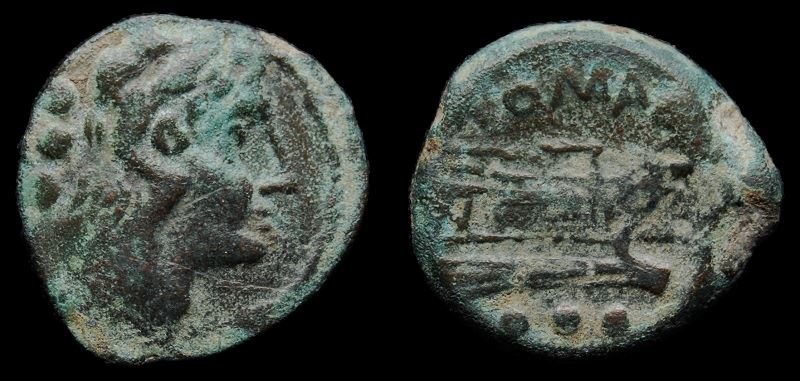
Reverse: Prow of galley right, ROMA above, three pellets below.
Die Orientation: -
Weight: 5.79 g
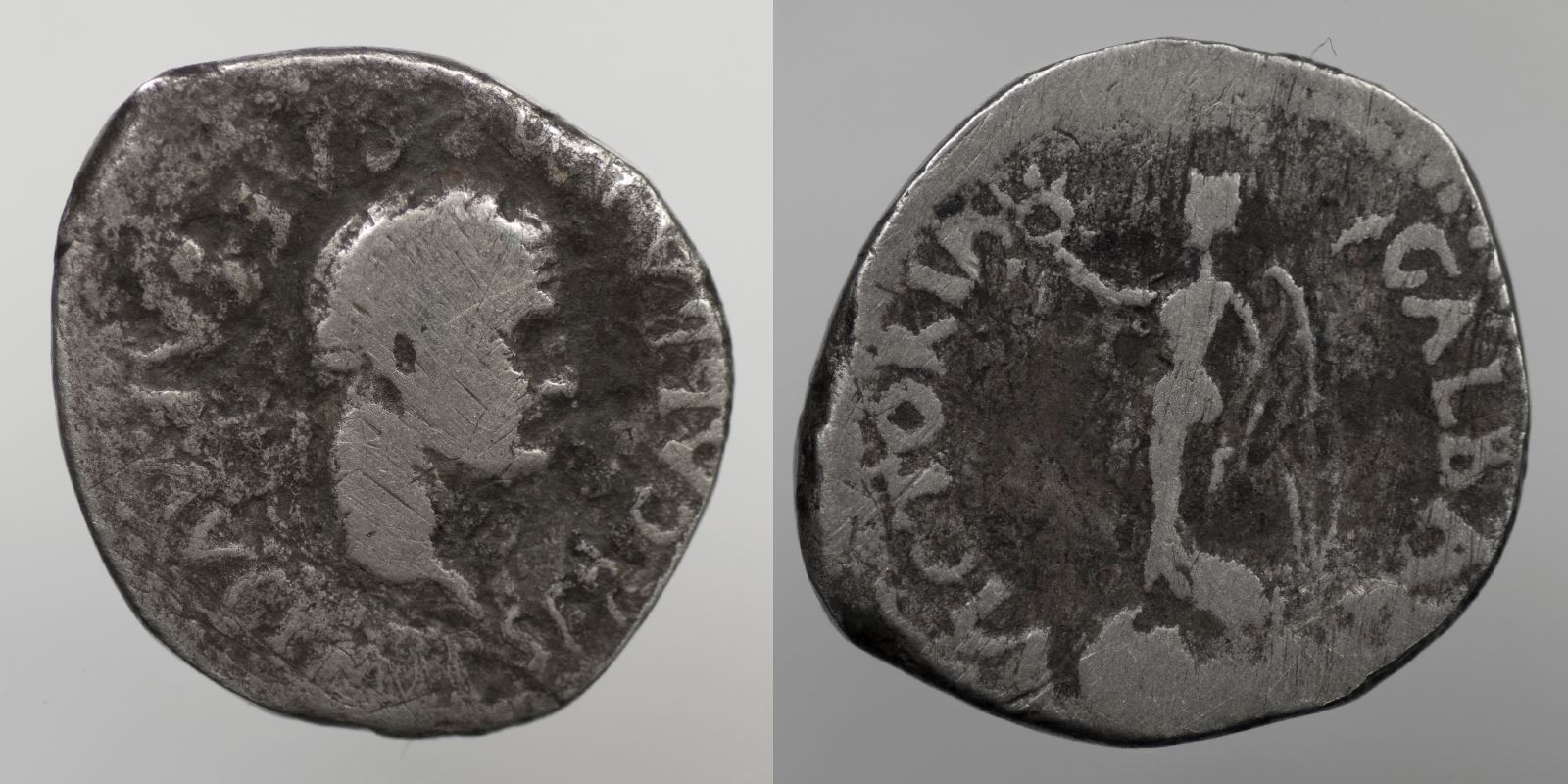
Reverse: VICTORIA GALBAE AVG, Victory wearing drapery, standing facing left on top of globe, holding wreath and palm
Die Orientation: 6 H
Weight: 1.62 g
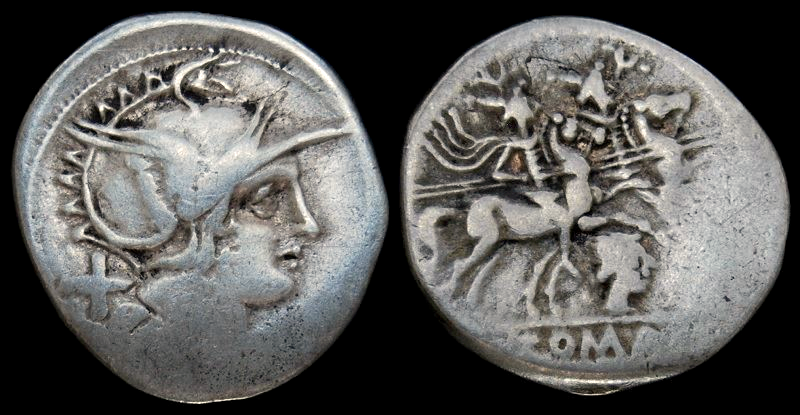
Reverse: The Dioscuri, each holding spear, on horseback right; below horses, female head right; ROMA in exergue.
Die Orientation: -
Weight: 3.76 g
Provenance: Naville Numismatics, Auction 42 (22 July 2018), lot 392.
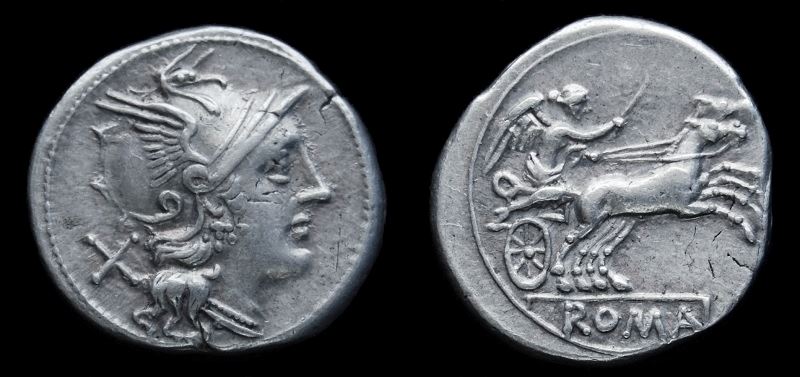
Reverse: Victory, holding goad, driving biga right; ROMA in exergue.
Die Orientation: 7 H
Weight: 3.75 g
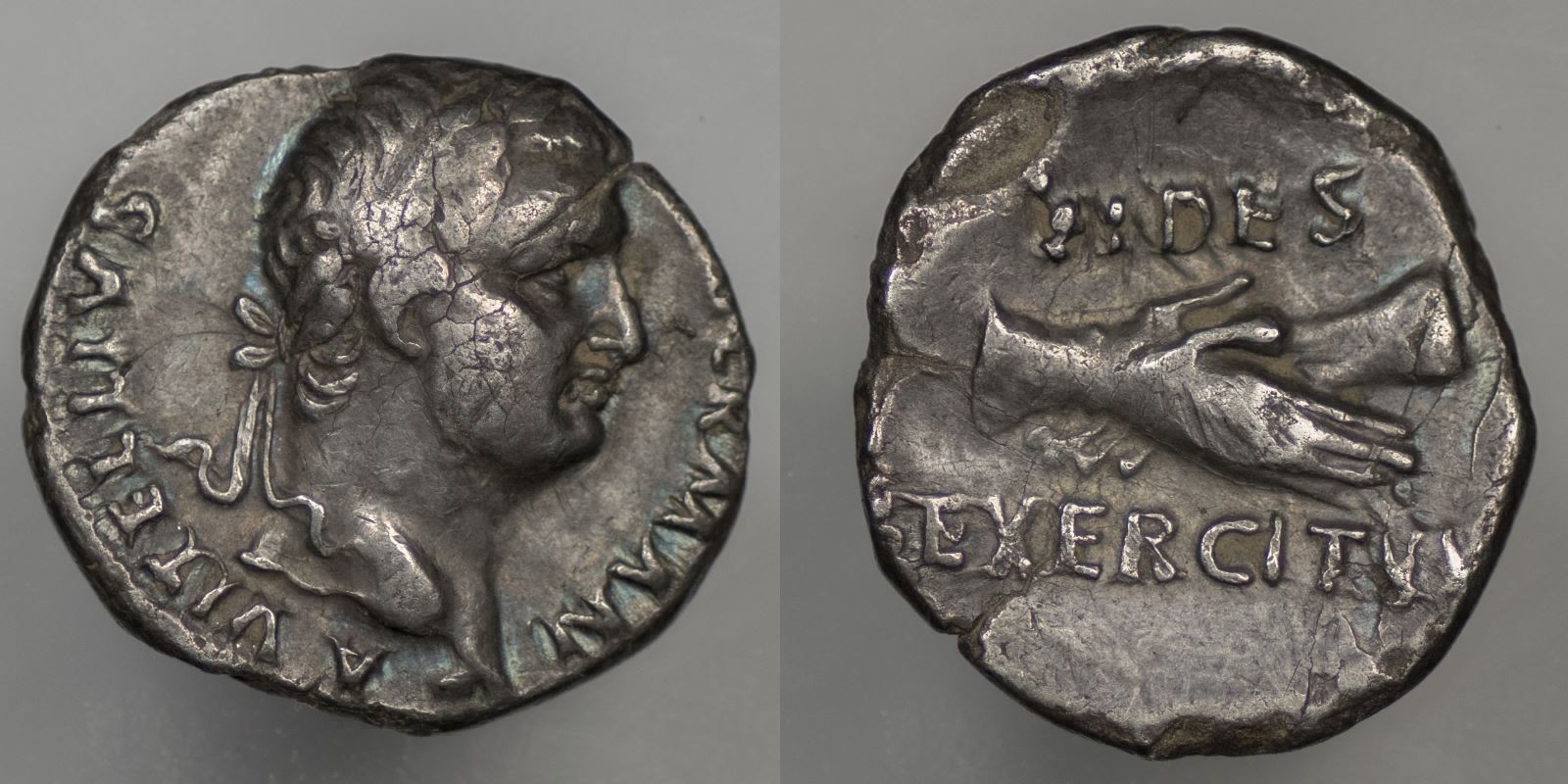
Reverse: FIDES EXERCITVVM, Inscription in two lines with clasped hands between
Die Orientation: 3 H
Weight: 3.22 g
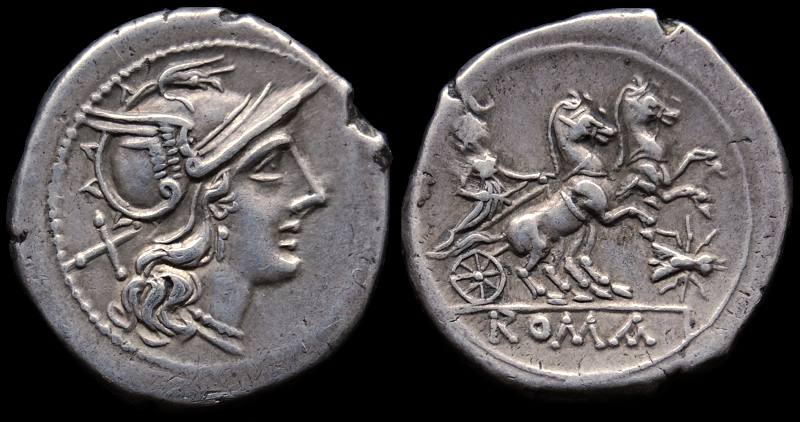
Reverse: Luna in prancing biga right; below, fly and ROMA in exergue.
Die Orientation: -
Weight: 3.85 g
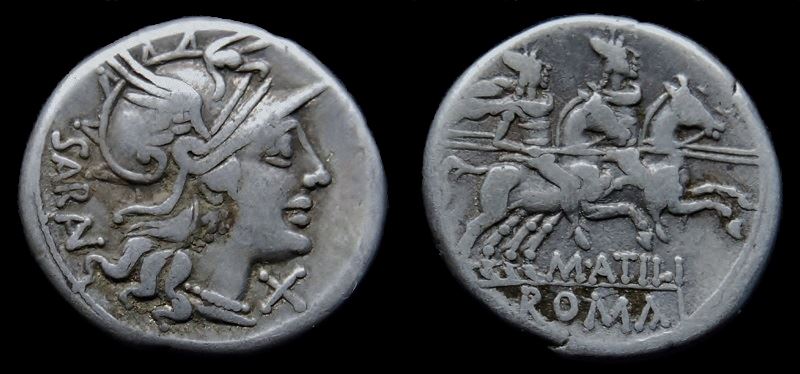
Reverse: The Dioscuri on horseback riding right. Below horses, M•ATILI and ROMA in linear border in exergue.
Die Orientation: 0 H
Weight: 3.8 g
From Appian - The Spanish Wars " He was succeeded in the command by Marcus Atilius, who made an incursion among the Lusitanians and killed about 700 of them and took their largest city, called Oxthracae. This so terrified the neighboring tribes that they all made terms of surrender. Among these were some of the Vettones, a nation adjoining the Lusitanians. But when he went away into winter quarters they all forthwith revolted and besieged some of the Roman subjects."
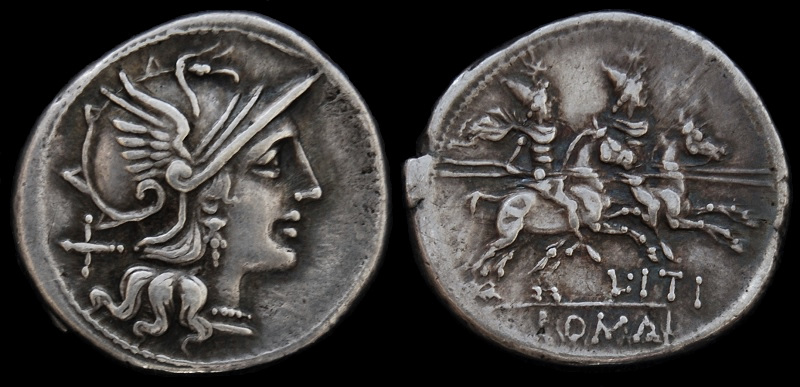
Reverse: The Dioscuri riding right; L•ITI below, ROMA in exergue.
Die Orientation: -
Weight: 3.39 g
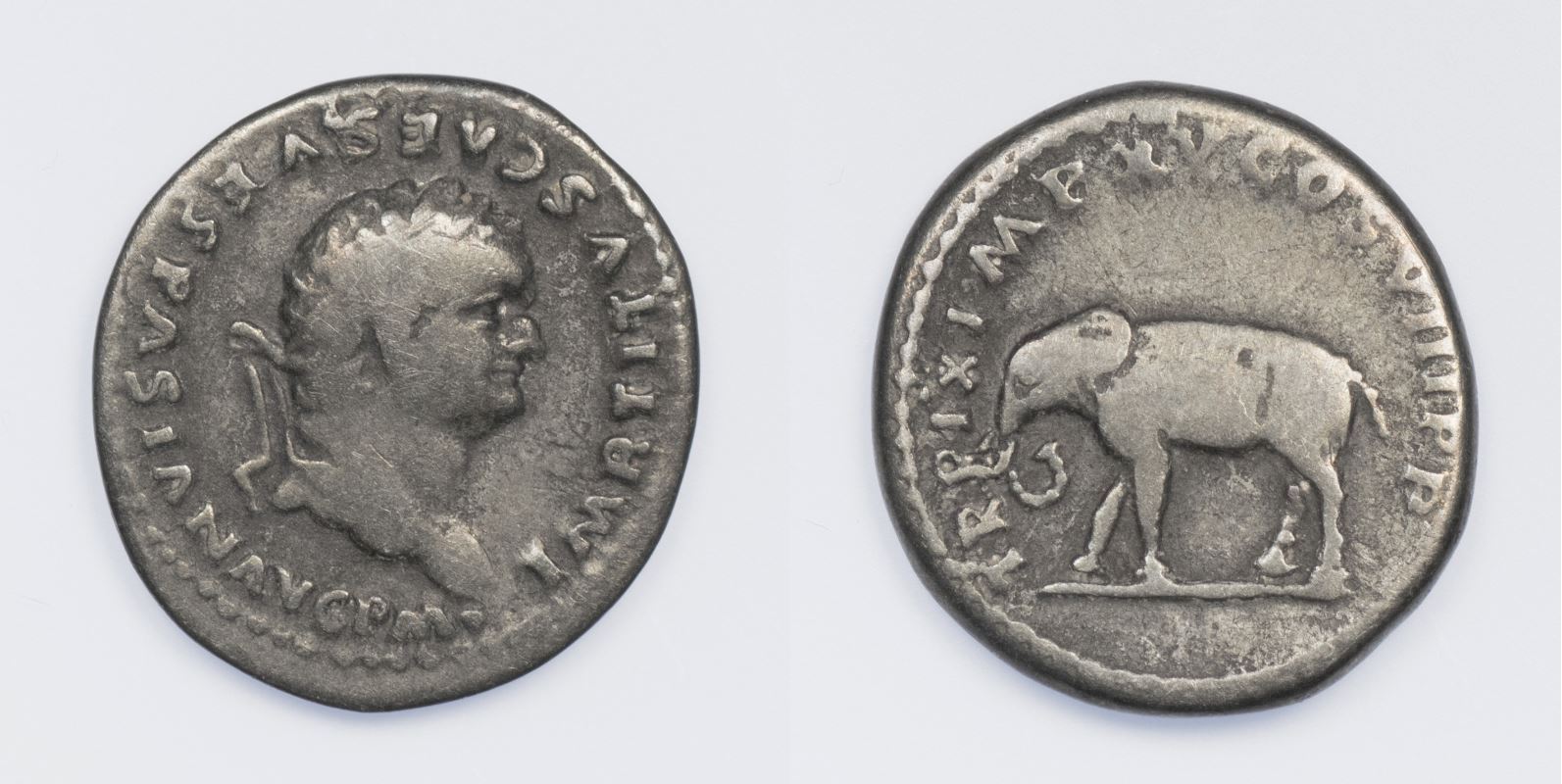
Reverse: TR P IX IMP XV COS VIII P P, Elephant standing facing left
Die Orientation: 6 H
Weight: 3.29 g
The dots around "IMP" seem to be some sort of minor sub variety, it's not on all of this particular type.
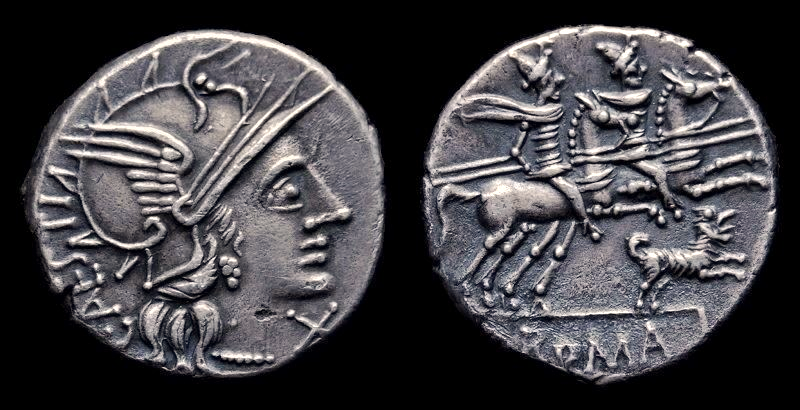
Reverse: The Dioscuri galloping right; below, puppy right with both fore-feet raised; ROMA in exergue.
Die Orientation: 10 H
Weight: 3.71 g
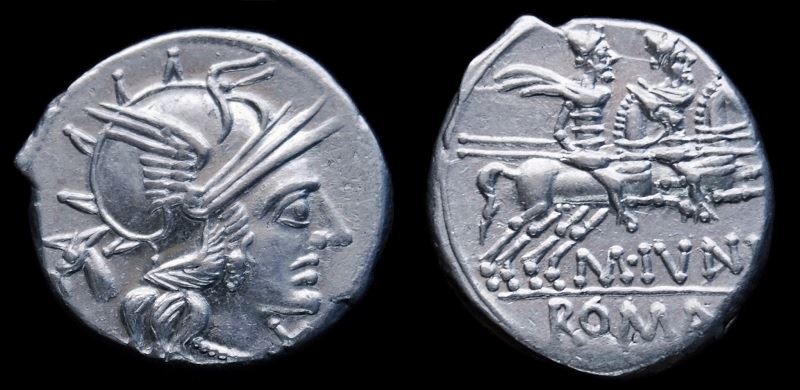
Reverse: The Dioscuri riding right; M•IVNI below, ROMA in exergue.
Die Orientation: 3 H
Weight: 4.12 g
In 109 BC Silanus achieved to become consul as the first member of his family, the Iunii Silani. He held this highest public office together with Quintus Caecilius Metellus Numidicus, who had to continue the war against Jugurtha, king of Numidia, whereas Silanus undertook to fight against the Cimbri. To increase the power of Rome Silanus abolished the exemptions from the military service. Probably before their battle with the consul the traveling Cimbri had asked to be given a domicile on Roman territory, but the Senate had declined their request. Silanus then rushed towards the Cimbri with his army but he was defeated at an unknown location in Gallia Transalpina.
In 104 BC the tribune of the people Gnaeus Domitius Ahenobarbus accused Silanus of his military failure, but the former consul was acquitted."
Provenance: Bertolami Fine Arts, E-Live Auction 49 (12 November 2017), lot 636.
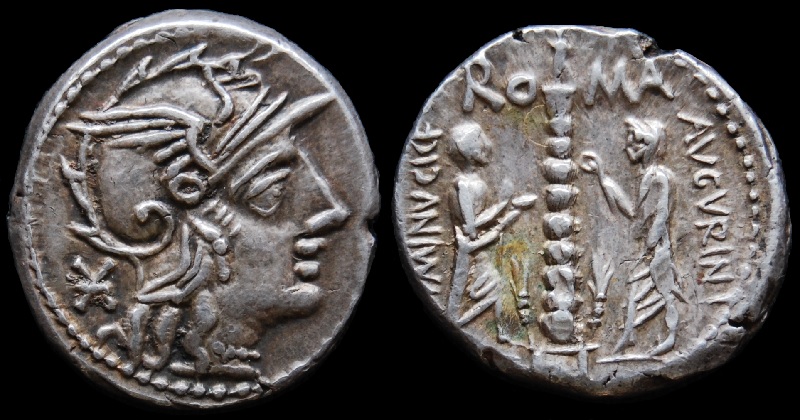
Reverse: Ionic column surmounted by statue; at base, two grain stalks; on left, L. Minucius Augurinus, holding patera, foot on modius; on right, M. Minucius Faesus , holding lituus; TI MINVCI CF upwards to left; AVGVRINI downwards to right. ROMA across fields.
Die Orientation: -
Weight: 3.97 g
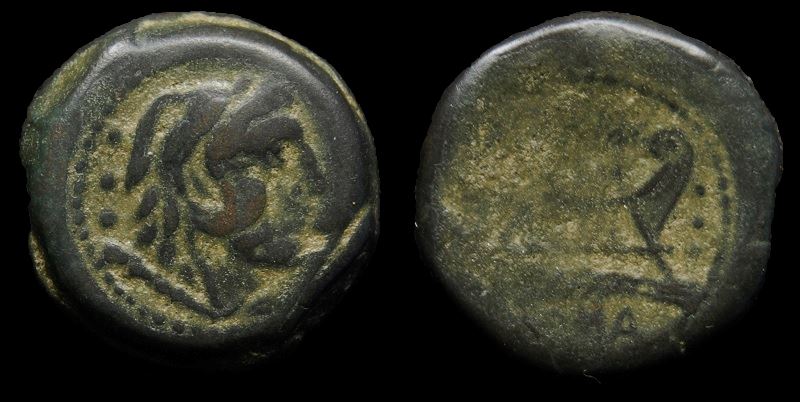
Reverse: Prow right; before, three pellets, above M·ABVRI MF / GEM, and below, ROMA.
Die Orientation: 0 H
Weight: 8.34 g

Reverse: The Dioscuri, each holding spear, on horseback right; two stars above; ROMA in exergue.
Die Orientation: -
Weight: 3.42 g
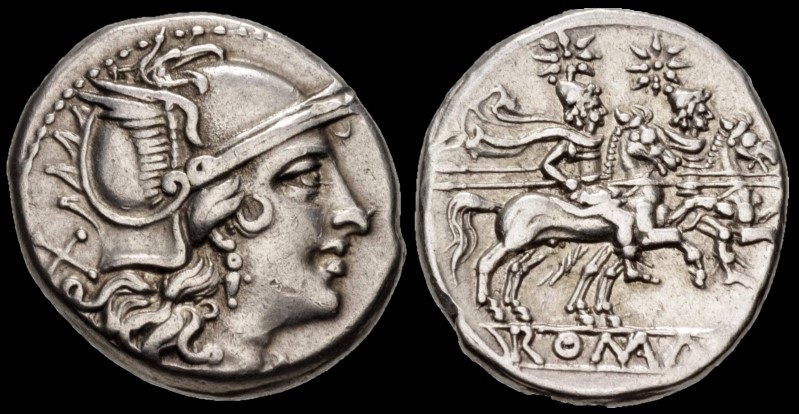
Reverse: The Dioscuri, each holding spear, on horseback right; two stars above; ROMA in exergue.
Die Orientation: 1 H
Weight: 4.47 g
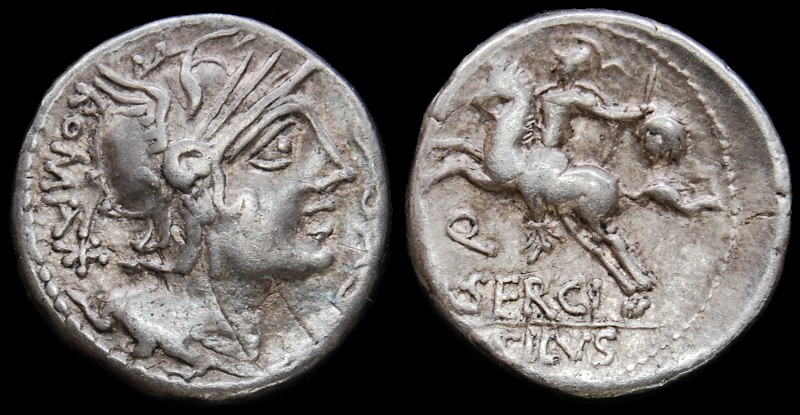
Reverse: Horseman galloping to the left; holding sword and severed head in hand; Q and M SERGI below; SILUS in exergue.
Die Orientation: 7 H
Weight: 3.85 g
Marcus Sergius was a Roman general during the Second Punic War (218 to 201 BC). He is famed in prosthetics circles as the first documented user of a prosthetic hand. The metal hand was constructed to allow him to hold his shield in battle.
A description of Marcus Sergius is found in the seventh book of Pliny's Natural History, published in AD 77:
Nobody - at least in my opinion - can rightly rank any man above Marcus Sergius, although his great-grandson Catiline shames his name. In his second campaign Sergius lost his right hand. In two campaigns he was wounded twenty-three times, with the result that he had no use in either hand or either foot: only his spirit remained intact. Although disabled, Sergius served in many subsequent campaigns. He was twice captured by Hannibal - no ordinary foe- from whom twice he escaped, although kept in chains and shackles every day for twenty months. He fought four times with only his left hand, while two horses he was riding were stabbed beneath him. He had a right hand made of iron for him and, going into battle with this bound to his arm, raised the siege of Cremona, saved Placentia and captured twelve enemy camps in Gaul - all of which exploits were confirmed by the speech he made as praetor when his colleagues tried to debar him as infirm from the sacrifices. What piles of wreaths he would have amassed in the face of a different enemy!

Reverse: Victory driving galloping biga right, holding reins and palm frond; rudder below horses; ROMA in exergue.
Die Orientation: -
Weight: 3.88 g
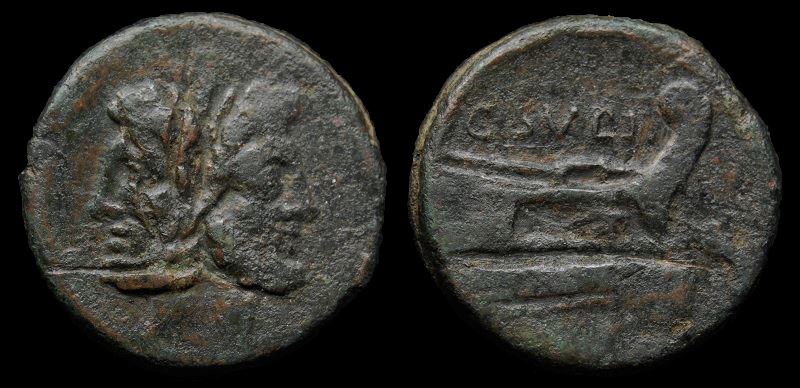
Reverse: Prow right; C•SVLPI above; palm-branch in right field; ROMA below.
Die Orientation: 0 H
Weight: 32.68 g
.png)
Reverse: The Dioscuri, each holding spear, on horseback right; two stars above; ROMA in exergue.
Die Orientation: 9 H
Weight: 3.98 g
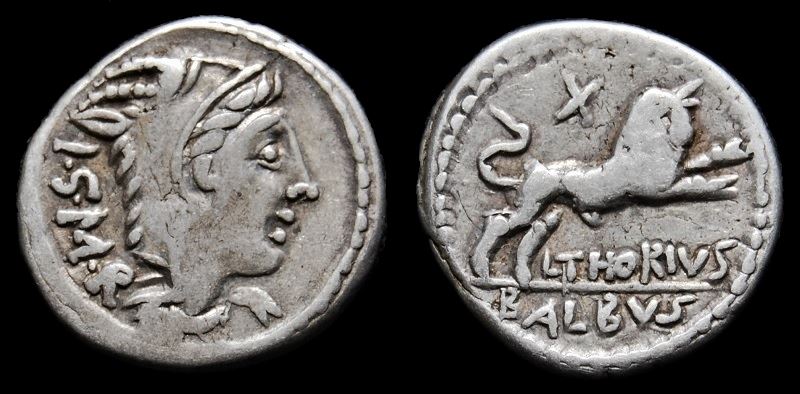
Reverse: Bull charging to right, L THORIVS below, BALBVS in exergue, X above.
Die Orientation: 6 H
Weight: 3.9 g

Reverse: Two warriors fighting, each armed with sword in right hand and shield in left; the one on the left protects a fallen comrade; the other wears horned helmet; Q•THERM•MF in exergue.
Die Orientation: -
Weight: 4.02 g
He may also have been the same Thermus who served as military tribune under Scipio in North Africa in 202 BC. Appian relates that about this time there was a cavalry engagement between the forces of Hannibal and those of Scipio near Zama, in which the latter had the advantage. On the succeeding days they had sundry skirmishes until Scipio, learning that Hannibal was very short of supplies and was expecting a convoy, sent the military tribune, [Quintus Minucius] Thermus, by night to attack the supply train. Thermus took a position on the crest of a hill at a narrow pass, where he killed 4,000 Africans, took as many more prisoners, and brought the supplies to Scipio."
Provenance: e-Bay sale (May 2018).
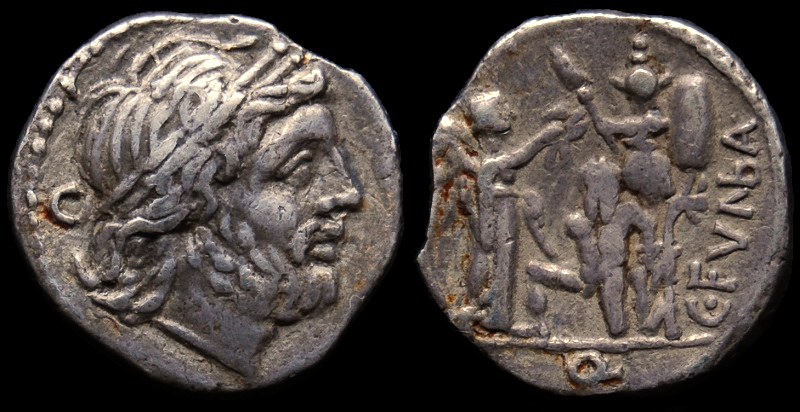
Reverse: Victory standing right, crowning trophy, beside which stands carnyx; before which, Gallic captive kneeling left; Q (mark of value) in exergue.
Die Orientation: -
Weight: 1.76 g
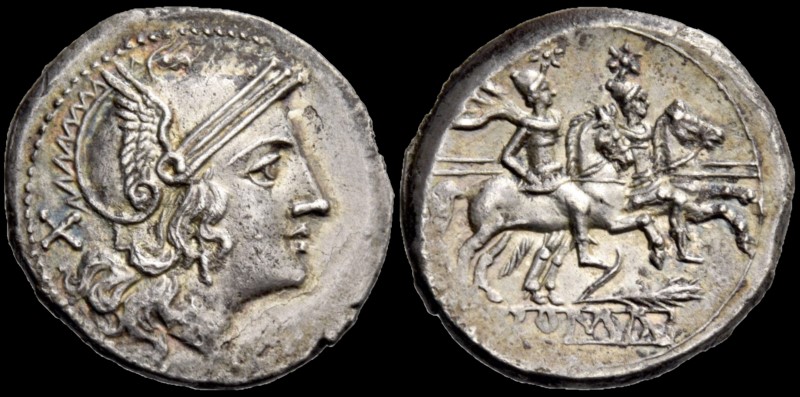
Reverse: The Dioscuri, each holding spear, on horseback right; two stars above; corn ear below horses; ROMA in exergue.
Die Orientation: -
Weight: 4.1 g
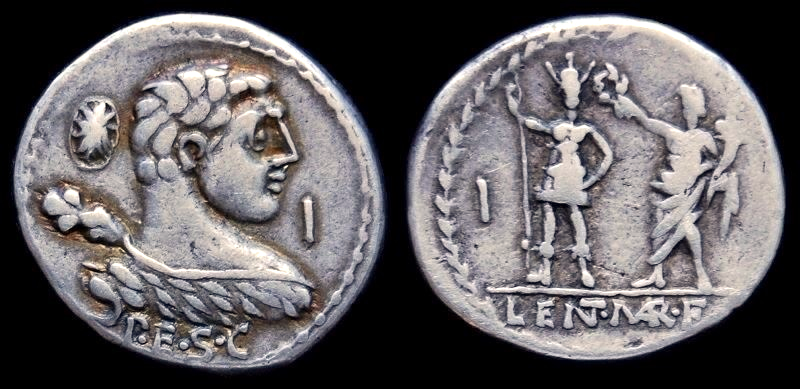
Reverse: Roma facing, holding spear, being crowned by Genius of the Roman People right; I (control mark) in left field, LENT•MAR•F in exergue; all within laurel-wreath.
Die Orientation: 11 H
Weight: 3.89 g
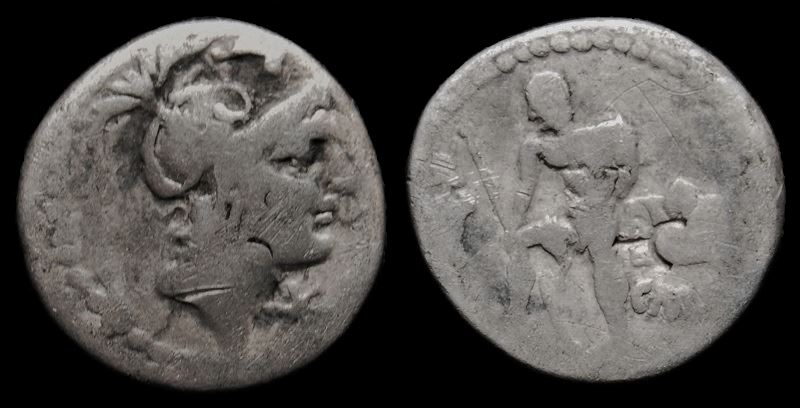
Reverse: Heroic figure standing left, foot on cuirass, holding spear and leaning on tabella divided into two compartments, CMA below, trophy in left field.
Die Orientation: 7 H
Weight: 3.6 g

Reverse: The Dioscuri, each holding spear, on horseback right; two stars above; ROMA in exergue.
Die Orientation: -
Weight: 4.65 g
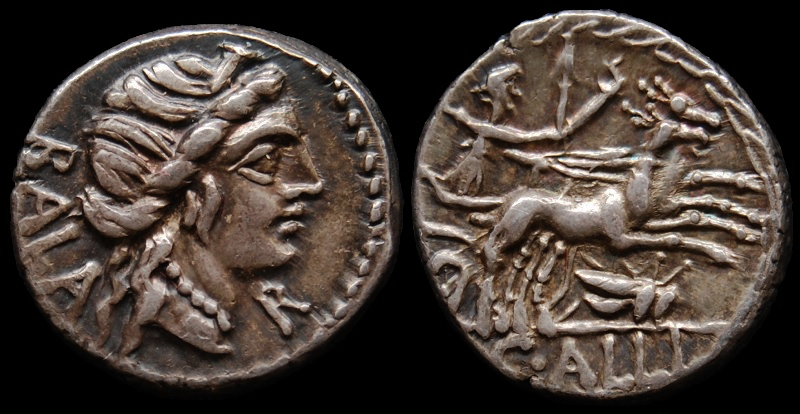
Reverse: Diana in a biga of stags to right; with quiver over shoulder and holding sceptre and reins in left hand and torch in right; grasshopper below stags, C•ALLI in exergue; all within laurel wreath.
Die Orientation: -
Weight: 3.88 g
"In Roman mythology, Diana was the goddess of the hunt, the moon and childbirth, associated with wild animals and woodland, and having the power to talk to and control animals. Oak groves were especially sacred to her. She was equated with the Greek goddess Artemis, though she had an independent origin in Italy. In myth, Diana was born with her twin brother Apollo on the island of Delos, daughter of Jupiter and Latona. Diana was known to be the virgin goddess of childbirth and women. She was one of the three maiden goddesses, along with Minerva and Vesta, who swore never to marry."
Provenance: e-Bay sale (November 2017).
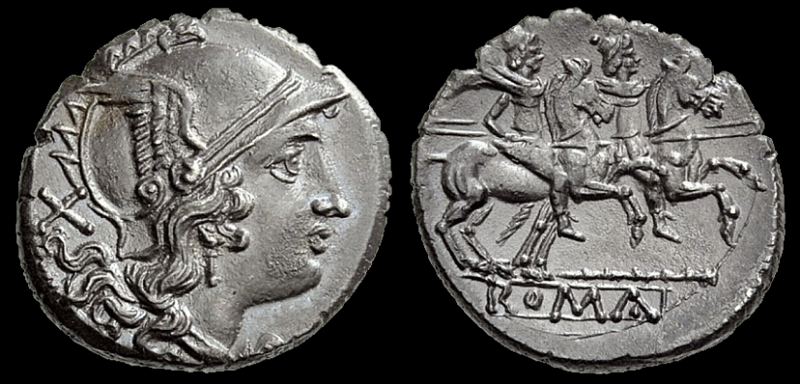
Reverse: The Dioscuri, each holding spear, on horseback right; two stars above; staff below horses; ROMA in exergue.
Die Orientation: -
Weight: 3.28 g
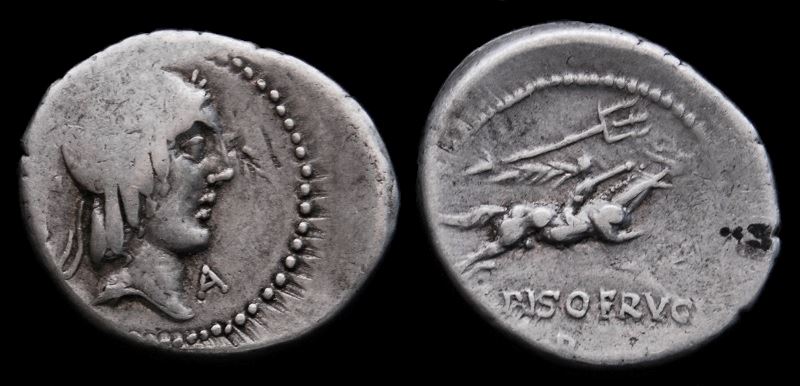
Reverse: Warrior riding horse right, holding palm frond and reins, above a trident right. L PISO FRUGI and control mark R in two lines below.
Die Orientation: 1 H
Weight: 3.9 g

Reverse: Victory advancing right, holding wreath and palm-branch, L PI - SO across fields, FRVGI in exergue.
Die Orientation: -
Weight: 2.16 g
Provenance: Naville Numismatics, Auction 42 (22 July 2018), lot 422. Ex Sternberg Auction 18 (20 November 1986), lot 323.
.png)
Reverse: Oath-taking scene: Youth kneeling by standard, holding pig at which eight soldiers (four on each side) point their swords, C in exergue.
Die Orientation: -
Weight: 3.64 g
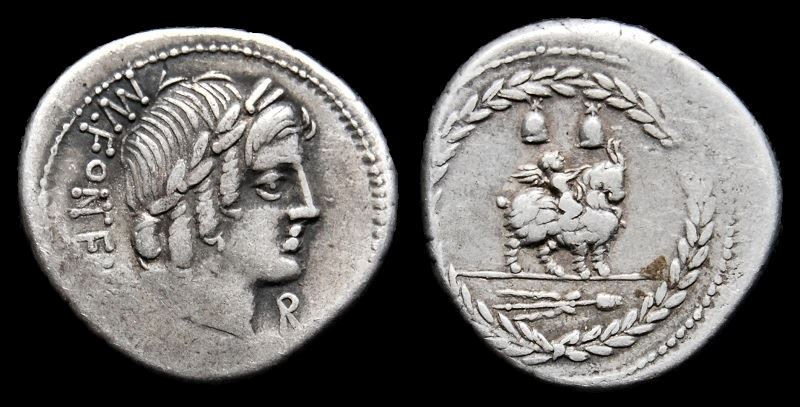
Reverse: Infant winged Genius (or Cupid) seated on goat standing right; pilei of the Dioscuri above; thyrsus with fillet in exergue; all within laurel wreath.
Die Orientation: 10 H
Weight: 3.93 g
"The moneyer is perhaps the brother of the moneyer M. Fonteius (see Crawford 347) and not inconceivably the tribune featured on the reverse of Crawford 429/1. The reverse recalls that the god Jupiter was suckled by the she-goat Amaltheia on Mt. Ida during his infancy, and depicts a statue that was within the Temple of Vejovis in Rome.
Romans believed that Vejovis was one of the first gods to be born. He was a god of healing, and was later associated with the Greek Asclepius. He was mostly worshipped in Rome and Bovillae in Latium. On the Capitoline Hill and on the Tiber Island, temples were erected in his honour. In spring, goats were sacrificed to avert plagues.
Vejovis is portrayed as a young man, holding a bunch of arrows, pilum, (or lightning bolts) in his hand, and is accompanied by a goat. He may be based on the Etruscan god of vendetta, known to them by the name Vetis written on the Piacenza Liver, a bronze model used in haruspical divination.
The studies about Vejovis are very poor and unclear. They show a constant updating of his condition and his use by people: escaping from netherworld, Volcanic God responsible for marshland and earthquakes, and later guardian angel in charge of slaves and fighters refusing to lose. God of deceivers, he was called to protect right causes and to give pain and deception to enemies. His temple has been described as a haven safe from police for wrongly persecuted people, and dedicated to the protection of the new comers in Rome, but this view is probably wrong.
The legend shows him more like an entity escaping from hell and trying to join the light and heaven, awesome fighter and protector of any people victims of unfairness. Aulus Gellius, in the Noctes Atticae, speculated that Vejovis was the inverse or ill-omened counterpart of Jupiter; compare Summanus. Aulus Gellius observes that the particle ve- that prefixes the name of the god also appears in Latin words such as vesanus, "insane," and thus interprets the name Vejovis as the anti-Jove. Aulus Gellius also informs us that Vejovis received the sacrifice of a female goat, sacrificed ritu humano; this obscure phrase could either mean "after the manner of a human sacrifice" or "in the manner of a burial." "

Reverse: Soldier (or Mars?) standing facing, head right, left foot on lorica, holding inverted spear in right hand and sword in left; to right, recumbent bull facing, head left; I in exergue.
Die Orientation: -
Weight: 3.75 g
Provenance: Roma Numismatics Auction XVI (26 September 2018), lot 537. Ex Bolaffi Spa, Auction 29 (30 November 2016), lot 80.
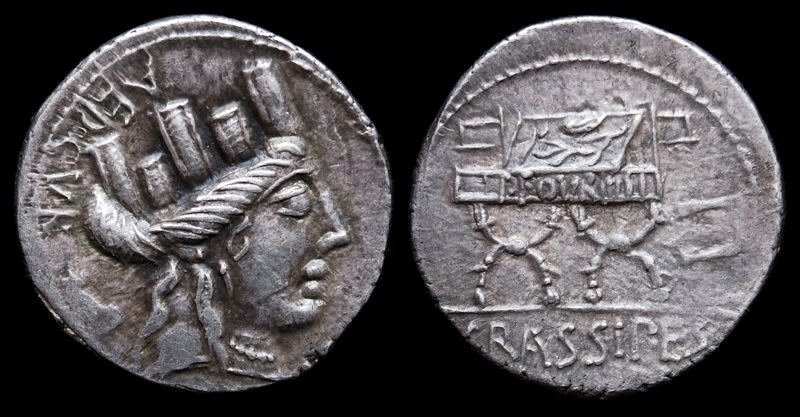
Reverse: Curule chair inscribed P•FOVRIVS; CRASSIPES in exergue.
Die Orientation: -
Weight: 3.93 g
The types of this coin and Crawford 409/2 probably refer to the Ludi Megalenses, games which honored the goddess Cybele, and were presented by the curule aediles.
Provenance: Naville Numismatics, Auction 37 (28 January 2018), lot 482.
.png)
Reverse: Soldier(or Mars?), nude to waist, standing facing, helmeted head turned right, holding lance with his right hand, sword in his lowered left hand; on left, four shields attached to a tree, on right, forepart of bull reclining right, in exergue, IIIV.
Die Orientation: -
Weight: 3.72 g
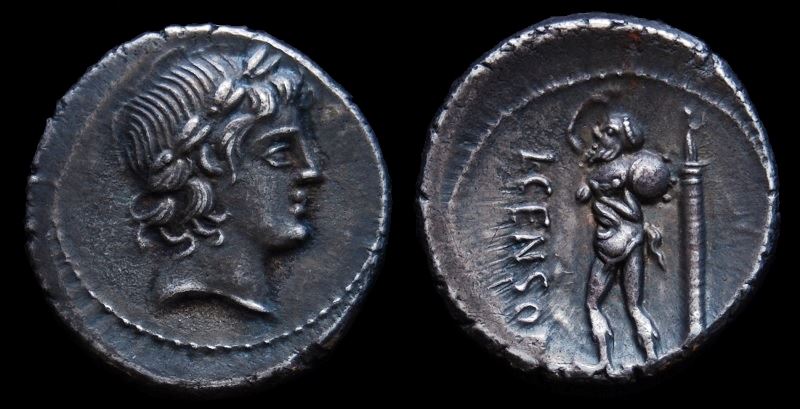
Reverse: Marsyas standing left, raising hand and holding wineskin over shoulder; L•CENSOR downwards in left field; column surmounted by statue of Minerva(?) in right field.
Die Orientation: 6 H
Weight: 3.46 g
"Among the Romans, Marsyas was cast as the inventor of augury and a proponent of free speech (the philosophical concept "parrhesia") and "speaking truth to power." The earliest known representation of Marsyas at Rome stood for at least 300 years in the Roman Forum near or in the comitium, the space for political activity. He was depicted as a silen, carrying a wineskin on his left shoulder and raising his right arm. The statue was regarded as an indicium libertatis, a symbol of liberty, and was associated with demonstrations of the plebs, or common people. It often served as a sort of kiosk upon which invective verse was posted."
"The plebeian gens of the Marcii claimed that they were descended from Marsyas. Gaius Marcius Rutilus, who rose to power from the plebs, is credited with having dedicated the statue that stood in the Roman forum, most likely in 294 BC, when he became the first plebeian censor and added the cognomen Censorinus to the family name. Marcius Rutilus was also among the first plebeian augurs, co-opted into their college in 300, and so the mythical teacher of augury was an apt figure to represent him."
"The descendant of Marcius Rutilus, L. Marcius Censorinus, issued coins depicting the statue of Marsyas, at a time when the augural college was the subject of political controversy during the Sullan civil wars of the 80s BC. On the coin, Marsyas wears a Phrygian cap or pilleus, an emblem of liberty. This Marcius Censorinus was killed by Sulla and his head displayed outside Praeneste. Sulla's legislative program attempted to curtail power invested in the people, particularly restricting the powers of the plebeian tribunes, and to restore the dominance of the senate and the privileges of patricians."
Provenance: CNG 106 (13 September 2017), lot 649.
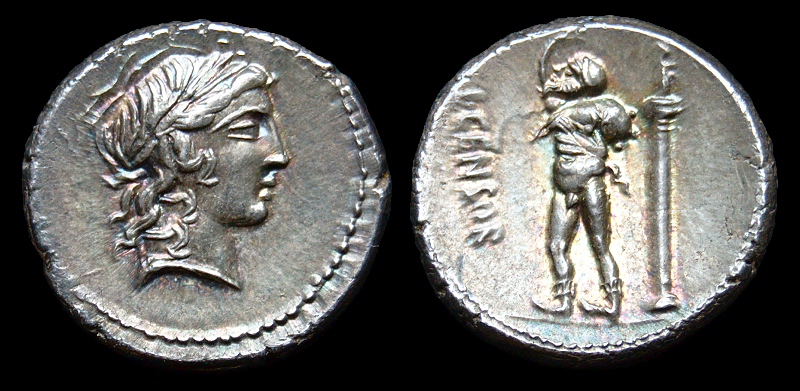
Reverse: Marsyas standing left, raising hand and holding wineskin over shoulder; L•CENSOR downwards in left field; column surmounted by statue of Minerva(?) in right field
Die Orientation: -
Weight: 3.99 g
Among the Romans, Marsyas was cast as the inventor of augury and a proponent of free speech (the philosophical concept "parrhesia") and "speaking truth to power." The earliest known representation of Marsyas at Rome stood for at least 300 years in the Roman Forum near or in the comitium, the space for political activity. He was depicted as a silen, carrying a wineskin on his left shoulder and raising his right arm. The statue was regarded as an indicium libertatis, a symbol of liberty, and was associated with demonstrations of the plebs, or common people. It often served as a sort of kiosk upon which invective verse was posted."
The plebeian gens of the Marcii claimed that they were descended from Marsyas. Gaius Marcius Rutilus, who rose to power from the plebs, is credited with having dedicated the statue that stood in the Roman forum, most likely in 294 BC, when he became the first plebeian censor and added the cognomen Censorinus to the family name. Marcius Rutilus was also among the first plebeian augurs, co-opted into their college in 300, and so the mythical teacher of augury was an apt figure to represent him.
The descendant of Marcius Rutilus, L. Marcius Censorinus, issued coins depicting the statue of Marsyas, at a time when the augural college was the subject of political controversy during the Sullan civil wars of the 80s BC. On the coin, Marsyas wears a Phrygian cap or pilleus, an emblem of liberty. This Marcius Censorinus was killed by Sulla and his head displayed outside Praeneste. Sulla's legislative program attempted to curtail power invested in the people, particularly restricting the powers of the plebeian tribunes, and to restore the dominance of the senate and the privileges of patricians."
Provenance: CNG 111 (29 May 2019), lot 613. From the Alan J. Harlan Collection, purchased from Edward J. Waddell, Ltd.

Reverse: Togate figure standing left, raising hand, between aquila and fasces. A – POST•A•F – •S•N – ALBIN across fields and in exergue.
Die Orientation: 10 H
Weight: 4.13 g
Provenance: CNG 106 (13 September 2017), lot 651. Ex Deyo Collection (Classical Numismatic Group 90, 23 May 2012), lot 1334. Stack’s (9 December 1992), lot 3177.

Reverse: Elephant walking left; Q•C•M•P•I in exergue.
Die Orientation: 6 H
Weight: 3.66 g
Metellus Pius came from one of the most important and wealthiest families of Rome. Beginning in the 3rd century BC, his family held numerous consulships, tribunates, censorships and military commands. His father, Q. Caecilius Metellus Numidicus, was the chief commander in the Jugurthine War in Numidia until Marius displaced him, and was later censor until driven into exile by Marius.
Though Metellus Pius fame is largely derived from his later campaigns in Hispania against Sertorius, the coinage in his name was struck at a North italian mint in 81 B.C, while he fought for Sulla against leaders of the Marian Party, such as Carrinas, Norbanus and Carbo. The obverse of this coin portrays the goddess Pietas and alludes to the moneyer's cognomen, Pius. The moneyer acquired the honorable title from the people of Rome, whom he had beseeched in order to secure the restoration from exile of his father. The reverse with the elephant recalls the accomplishment of his ancestor Lucius Caecilius Metellus, who in 251 B.C captured an army of Carthaginian elephants at Panormus."
Provenance: e-Bay sale, December 2017.
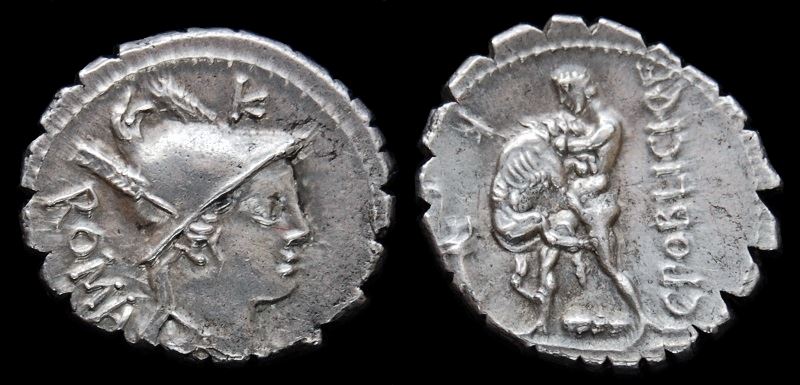
Reverse: Hercules standing left, strangling Nemean Lion; club at his feet, K (control mark) above; bow and arrows in left field; C•POBLICI•Q•F upwards in right field.
Die Orientation: 5 H
Weight: 3.9 g
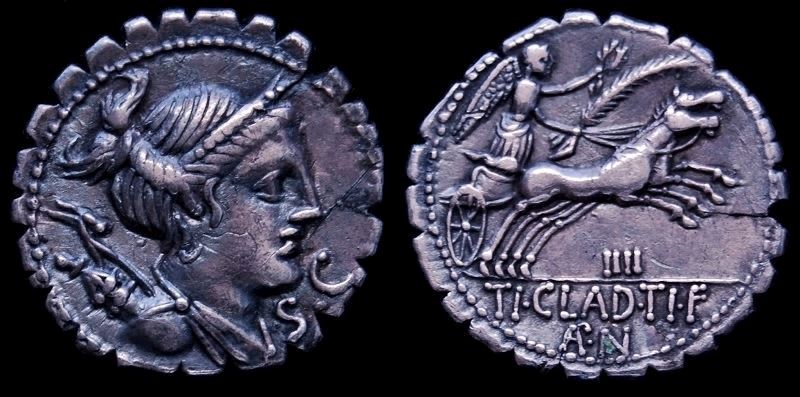
Reverse: Victory in biga riding right, holding palm-branch, reins and wreath, IIII (control mark) below. TI•CLAVD•TI•F AP•N in exergue.
Die Orientation: 10 H
Weight: 3.9 g
Provenance: e-Bay sale (June 2017).
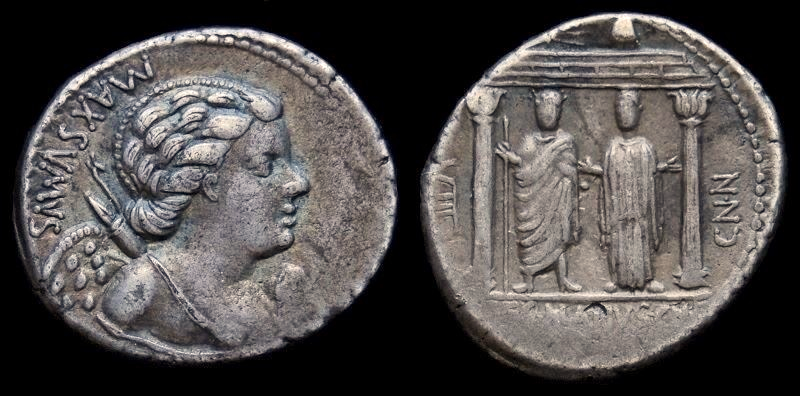
Reverse: Distyle temple with two facing statues within; Jupiter, to the left, holding staff, and Libertas, on the right, holding pileus. Above pediment, thunderbolt and pileus. VIII (control mark) in left field; CN•N in right field; C•EGNATIVS•CN•F in exergue.
Die Orientation: -
Weight: 3.98 g
This moneyer, a man of somewhat disreputable character, was admitted into the Roman senate, but was subsequently expelled by the censors. Not much more is known about him.
In Catullus love poetry, Cupid and Venus are constantly paired as the patrons of all sensual love and they have maintained the same symbolism even today for people who no longer worship the gods. The bust of Cupid so prominently placed on the obverse of Egnatius coin, depicted with his cherub-like features and armed with a bow whose arrows only wound one's heart with passion and desire, but never kill, is symbolic of peace and the pleasure it brings.
This issue is the only surviving record of the Temple of Jupiter Libertas. The temple of Libertas was built on the Aventine hill ca 246 B.C by the plebeian aediles Tiberius Sempronius Gracchus and Gaius Fundanius. The money to finance the erection of the temple came from fines. The main contributor was Claudia, the sister of the consul of 249 B.C, Publius Claudius Pulcher. On an occasion when she found it hard to make her way through the crowded streets of Rome she exclaimed that she wished her brother was still alive to lose another fleet for the Romans for that would thin out the population a little. That insensitive comment cost her 25.000 asses.
In the course of time the temple came to be better known as the temple of Jupiter Libertas. The original connection between the two deities may be found in the belief that Libertas was the daughter of Jupiter and Juno. Egnatius depiction of the temple shows its true bipartite nature at that time. It was restored by Augustus as part of his grand renovation of Rome.”
Provenance: Purchased from Moruzzi Numismatica (5 March 2018). Ex Varesi 63 (26 November 2013), lot 46.
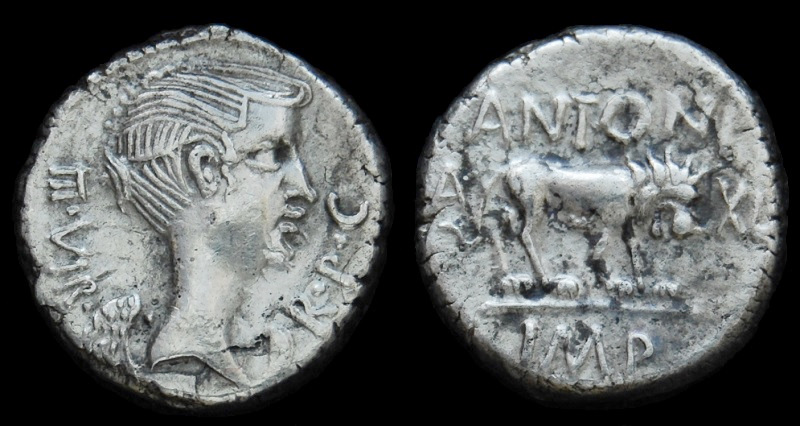
Reverse: Lion walking right; ANTONI above; A - XLI ( = 41, Antony’s age at time of issue) across field; IMP in exergue.
Die Orientation: -
Weight: 1.88 g
.jpg)
Reverse: Hound running right; spear below, C•POSTVMI and TA monogram in exergue.
Die Orientation: -
Weight: 3.92 g
Provenance: Tauler & Fau Floor Auction 20, (28 November, 2018), lot 112.

Reverse: Curule chair between fasces, L•FVRI CN•F above.
Die Orientation: 6 H
Weight: 3.95 g
"Ceres was the Roman goddess of agriculture. She was equivalent to the Greek Demeter. The curule chair (sella curulis) was the official chair of the 'curule' magistracies: the consulship, the praetorship, and the 'curule' aedileship (the two highest aediles). The fasces were bundles of rods bound together. The rods symbolized the power to inflict physical punishment. When an axe (securis) was bound in the middle of the rods, it signified the power to inflict death."
Provenance: CNG 106 (13 September 2017), lot 659.
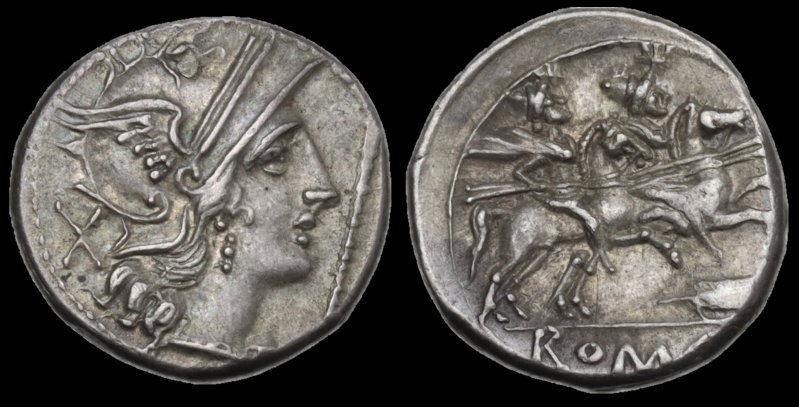
Reverse: The Dioscuri, each holding spear, on horseback right; two stars above; feather below horses; ROMA in exergue.
Die Orientation: 0 H
Weight: 3.29 g
Provenance: Artemide Aste - E-auction 22 (3 April 2022), lot 454.

Reverse: Erato, the Muse of Erotic Poetry, standing slightly right, habited in the stola — over which is the palla, — holding a kithara, and playing upon it with a simple plectrum held at her side; Q•POMPONI to left; MVSA to right.
Die Orientation: -
Weight: 3.98 g
The Muses are the inspirational goddesses of literature, science, and the arts in Greek mythology. They were considered the source of the knowledge embodied in the poetry, lyric songs, and myths that were related orally for centuries in these ancient cultures. They were later adopted by the Romans as a part of their pantheon. According to Hesiod's Theogony from the seventh century BC, they were daughters of Zeus, king of the gods, and Mnemosyne, Titan goddess of memory. For Alcman and Mimnermus, they were even more primordial, springing from the early deities Ouranos and Gaia. Gaia is Mother Earth, an early mother goddess who was worshipped at Delphi from prehistoric times, long before the site was rededicated to Apollo, possibly indicating a transfer to association with him after that time.
Sometimes the Muses are referred to as water nymphs, associated with the springs of Helicon and with Pieris. It was said that the winged horse Pegasus touched his hooves to the ground on Helicon, causing four sacred springs to burst forth, from which the Muses were born. Athena later tamed the horse and presented him to the Muses.
Classical writers set Apollo as their leader. In one myth, the Muses judged a contest between Apollo and Marsyas. They also gathered the pieces of the dead body of Orpheus, son of Calliope, and buried them in Leivithra. In a later myth, Thamyris challenged them to a singing contest. They won and punished Thamyris by blinding him and robbing him of his singing ability. The earliest known records of the Nine Muses are from Boeotia, the homeland of Hesiod.
It was not until Hellenistic times that the following systematic set of functions was assigned to them, and even then there was some variation in both their names and their attributes: Calliope (epic poetry), Clio (history), Euterpe (flutes and lyric poetry), Thalia (comedy and pastoral poetry), Melpomene (tragedy), Terpsichore (dance), Erato (erotic/love poetry), Polyhymnia (sacred poetry), Urania (astronomy).
Erato was one of the nine Muses. In the Classical era, when the Muses were assigned specific literary and artistic spheres, Erato was named Muse of erotic poetry and mime, and represented with a kithara. Her name means "lovely" or "desired" from the Greek word eratos."
Provenance: Purchased from Moruzzi Numismatica (25 April 2018).
.jpg)
Reverse: Cretan goat standing right; quiver and bow in left field.
Die Orientation: 9 H
Weight: 3.86 g
Cn. Plancius became friends with Cicero during Ciceros exile in Macedonia, and in 55 BC, after being elected to the curule aedileship, was defended by Cicero against charges of electoral corruption. The obverse and reverse types refer to his activities in Macedonia and Crete."
Provenance: Bertolami Fine Arts, E-Live Auction 49 (12 November 2017), lot 774.

Reverse: Urania, the Muse of Astronomy, wearing long flowing tunic and peplum, standing left, touching with wand held in right hand a globe set on base; Q • POMPONI downward to right, MVSA downward to left.
Die Orientation: -
Weight: 18.5 g
.png)
Reverse: The Villa Publica: building consisting of two stories, each with a row of columns; the lower columns are surmounted by arches, the upper ones by a sloping roof - T·DIDI· IMP VIL·PVB in fields.
Die Orientation: 1 H
Weight: 3.86 g
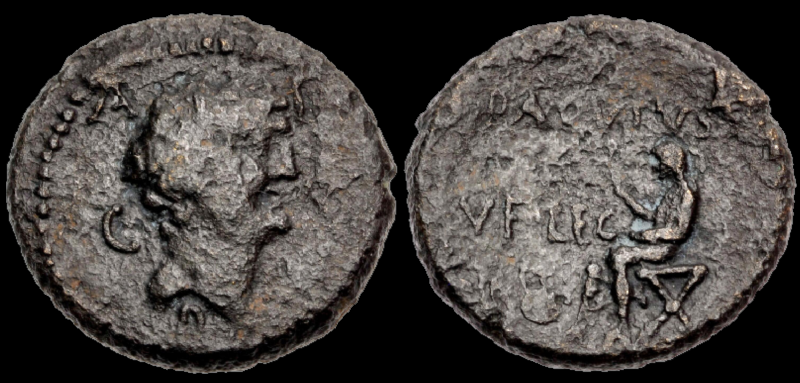
Reverse: Togate figure seated left on sella curulis, urn at feet, holding tablet; Q PA[Q]VIVS/[R]VF LEG in two lines in field.
Die Orientation: 12 H
Weight: 7.25 g
Provenance: CNG Electronic Auction 484 (27 January 2021), lot 507.
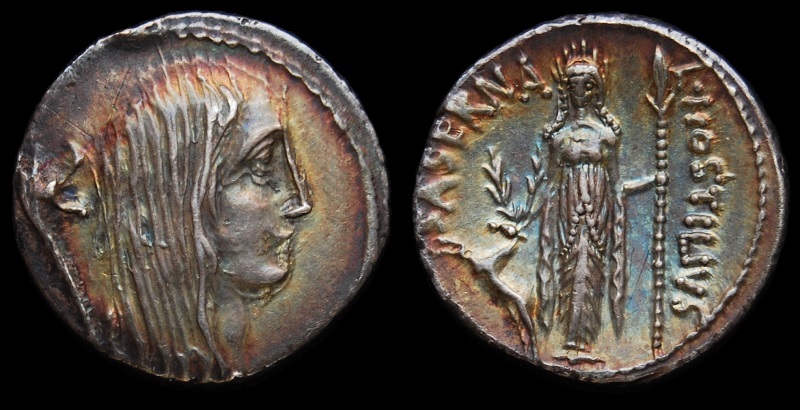
Reverse: Diana (Artemis) standing facing, laureate, wearing long hair falling down her shoulders and long flowing robes, holding spear in left hand and stag by its antlers in her right; SASERNA upward around left, L • HOSTILIVS downward to right
Die Orientation: -
Weight: 3.82 g
The obverse figure has not been definitively identified. Some speculate that she is a representation of Gallia, made to represent Julius Caesar's conquest of the area during the Gallic War. This belief is further bolstered by the presence of a carnyx behind the bust.
Another proposition is that the figure is a representation of Pallor, the goddess of fear and paleness. The complexion on the faces of different dies lend plausibility to this theory. There was another god, Pavor, who represented consternation, panic, and dread. Interestingly, Hostilius also struck a coin with a male head (who many bealieve may be a representation of the Gallic chieftain Vercingetorix). This may be an allusion to Tullus Hostilius, who vowed (and presumably later erected) temples to Pallor and Pavor during his war with the Etruscan cities Veii and Fidenae.
Another theory proposed is that Gallia is represented by Pallor, perhaps to show the fear of conquest.
The reverse probably refers to that Artemis was the chief goddess of Massalia, a Greek colony in southern Gaul. In the Civil War, Massalia declared for Pompey and Caesar besieged the city. When it submitted in 49 BC, Caesar allowed it to remain free, but took most of its lands."
Provenance: e-Bay sale (March 2018).
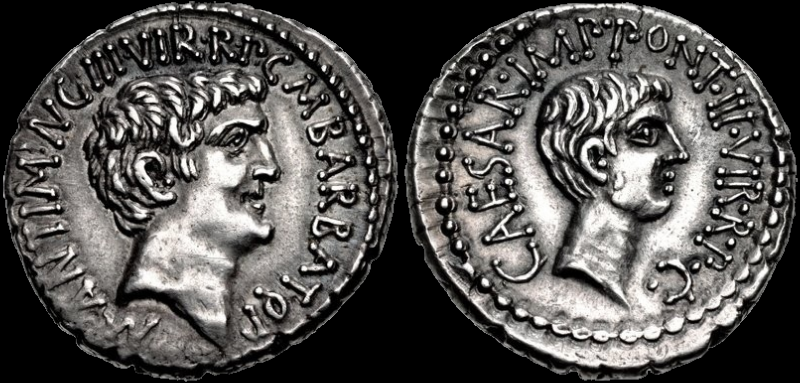
Reverse: Bare head of Octavian right, wearing slight beard; CAESAR • IMP • PONT • III • VIR • R • P • C • around.
Die Orientation: 12 H
Weight: 3.99 g
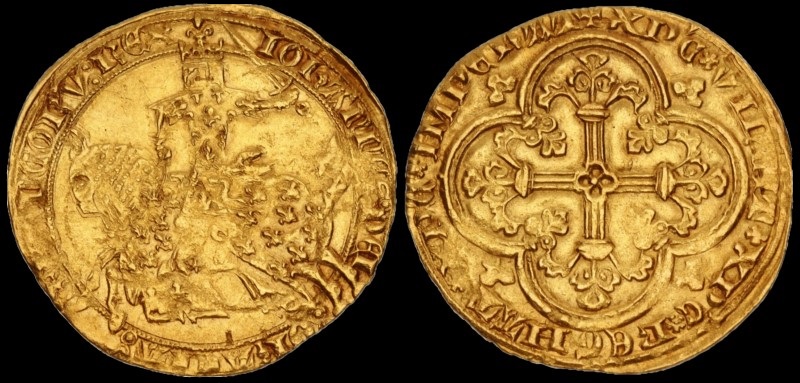
Reverse: +XP'C • VIИCIT • XP'C • RЄGNAT • XP'C • IMPЄRAT (rosette stops), cross tréflée and feuillue; in center of cross, • within quadrilobe; all within quadrilobe, trefoil fleurée at end of each arc; trilobe in spandrels.
Die Orientation: 1 H
Weight: 3.76 g
Provenance: Triton XXV Session 5 (25 January 2022), lot 455.
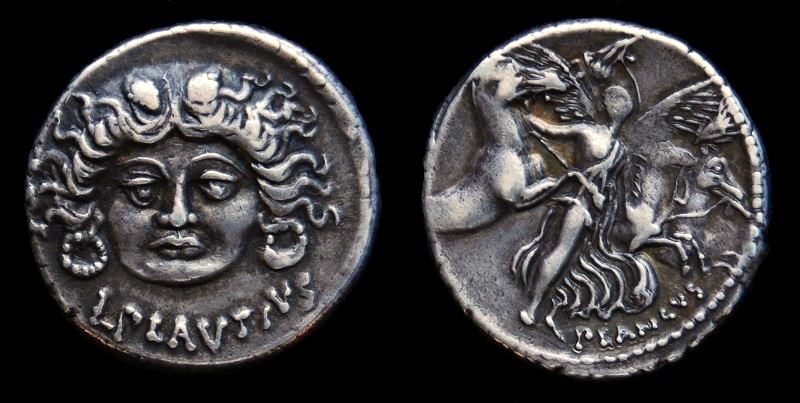
Reverse: Aurora, winged and draped, flying right, head facing slightly left, holding reins and palm branch, conducting the four rearing horses of the sun; PLANCVS below.
Die Orientation: 12 H
Weight: 4 g
Provenance: CNG Electronic auction 404 (23 August 2017), lot 453. Ex Hirsch Nachf. 284 (26 September 2012), lot 2585.
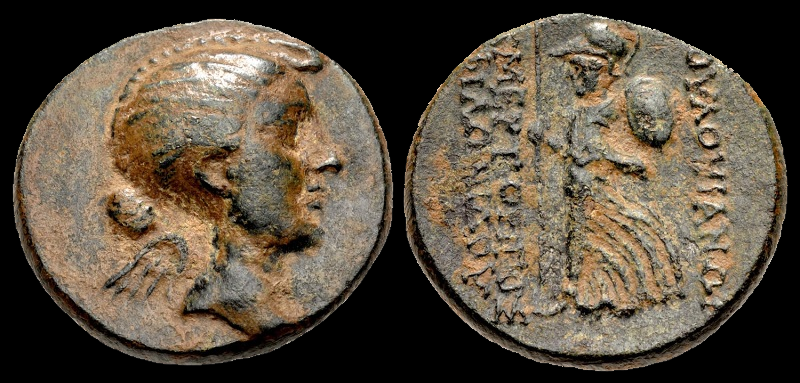
Reverse: Minerva standing left, holding shield and spear; [ΦOYΛOYIANON] in right field, [Z]MEPTOPIΓOΣ / [Φ]IΛΩNIΔOΥ] in two lines in left field.
Die Orientation: 12 H
Weight: 6.1 g

Reverse: Sphinx seated right; T • CARISIVS above, III • VIR in exergue.
Die Orientation: -
Weight: 3.8 g
Provenance: Ex Aureo & Calicó Auction 319 – Alba Longa, vol. I (7 November 2018), lot 223, Ex Sotheby's "Greek and Roman coins" (28 October 1993), lot 1385.
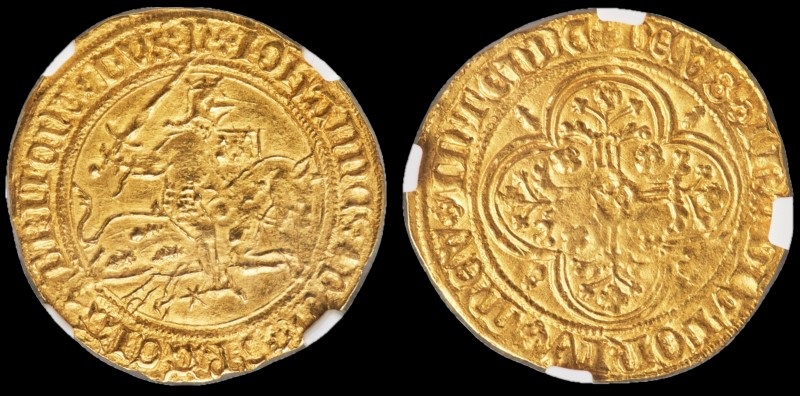
Reverse: +DЄVS • InΛDIVTORIV • mЄV • InTЄnDЄ (rosette stops), cross fleuillue with rosettes in angles, all within quadrilobe with ermines in spandrels.
Die Orientation: 0 H
Weight: 2.95 g
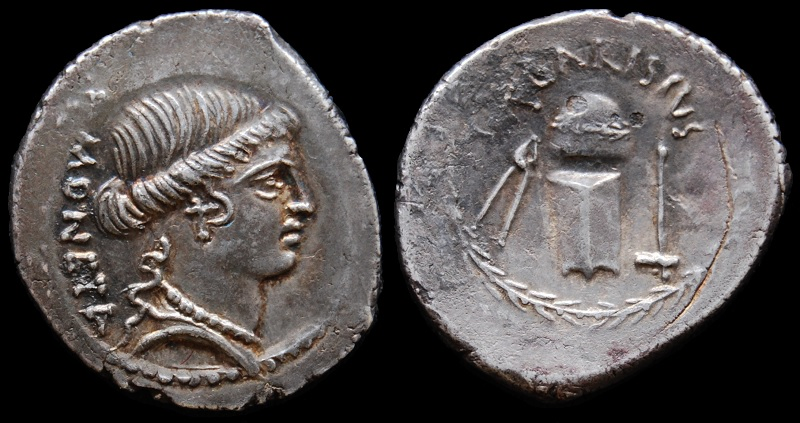
Reverse: Implements for coining money: anvil die with garlanded punch die above, tongs and hammer on either side; T•CARISIVS above; all within laurel wreath.
Die Orientation: -
Weight: 3.74 g
Provenance: Jesus Vico S.A, Auction 150 (1 March 2018), lot 414. Ex Herrero (25 March 1993), lot 78.
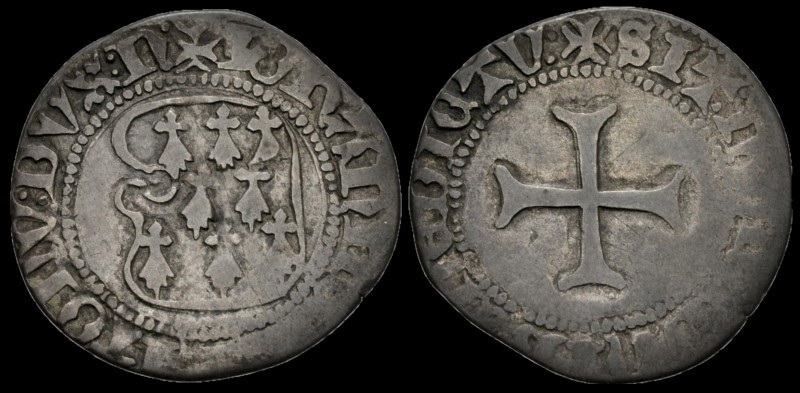
Reverse: + SIT : NOME : DNI : BENEDICTV, Cross pattée
Die Orientation: 0 H
Weight: 2.59 g

Reverse: Scepter, cornucopia on globe, and rudder; T • CARISI below; all within laurel wreath.
Die Orientation: -
Weight: 3.61 g
There are coins in which Titus Carisius is identified as triumvir monetalis, and another which mentions Publius Carisius, as legatus and propraetor, together with the word Emerita, apparently referring to the town of Augusta Emerita in Lusitania, which the emperor Augustus established for the emeriti, veterans of the war in Hispania. From this it has been conjectured that the praenomen Titus, assigned to the conqueror of the Astures by Cassius Dio, should instead be Publius.
Provenance: Triton XXII (9 January 2019), lot 912. From the Alan J. Harlan Collection, purchased from Freeman & Sear. Ex Numismatica Ars Classica 33 (5 April 2006), lot 339.
.png)
Reverse: Desultor (horseman who leaps from one horse to another), wearing conical cap and holding whip, right on horseback, second horse behind; palm frond and wreath to left; P SEPVLLIVS above, MACER below.
Die Orientation: 8 H
Weight: 3.87 g
"This is the first portrait issue of Mark Antony. Struck within a month or two of the assassination of Julius Caesar, Antony is shown bearded, clearly symbolic of one in mourning. For the next two and a half years, until after the battle of Philippi, the portraits on coins of both Mark Antony and Octavian were bearded for the same reason. The reverse depicts a rider who switches from one horse to the other while the horses are in motion, an equestrian event which was part of the Parilian games, celebrated each year on 21 April. In 44 BC, the year of Julius Caesar’s assassination, the Parilia celebrated Caesar’s victory at Munda. Including a desultor on the reverse, Mark Antony probably attempted to kindle public support of the Caesarian cause." Provenance: From the John L. Cowan Collection. Ex Cederlind BBS 154 (31 March 2010), lot 213, ex Gorny & Mosch auction 180 (12 October 2009), lot 322, ex Numismatica Ars Classica auction 41 (20 November 2007), lot 17.

Reverse: LE-PI flanking cornucopia; all within laurel wreath
Die Orientation: -
Weight: 0.36 g
Provenance: Leu Numismatik Web auction 8 (29 June, 2019), lot 611.

Reverse: Minerva, helmeted and draped, standing right, holding spear in right hand and Victory in extended left; shield at side, C • VIBIVS downward to right, VARVS downward to left.
Die Orientation: -
Weight: 3.67 g
Provenance: Heritage Auctions - Long Beach Expo World & Ancient Coins Signature Auction Session 5 (September 5-9 2019), lot 155. Coin Galleries: The Numismatic Review and Fixed Price List (May - June, 1960), lot A371.
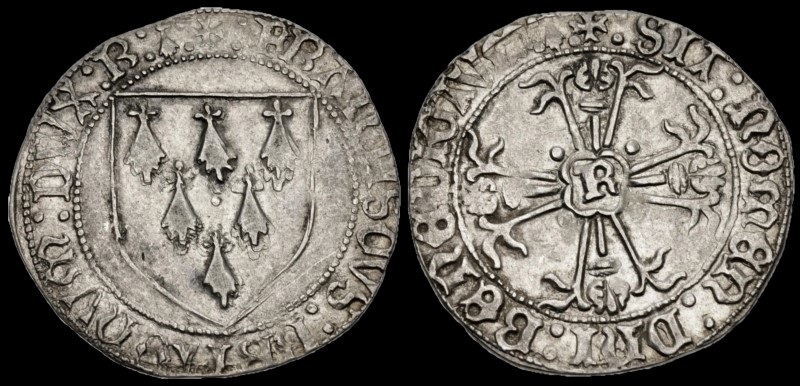
Reverse: + SIT : NOMEN : DNI : BENEDICTV(M), Cross fleuronnée; R in central quadrilobe; pellet in quarters.
Die Orientation: 0 H
Weight: 3.7 g
.png)
Reverse: III•VIR• R•P•C - head of Octavia atop cista mystica, between twisting snakes.
Die Orientation: 12 H
Weight: 12.4 g
"Following the death of Octavia's first husband C. Claudius Marcellus in 40 BC, her marriage to Antony sought to seal the Pact of Brundisium in which it had been agreed that Octavian would assume control of the west and Antony of the east. The striking of this type cements the agreement before the people of Ephesus, an important city, later made the capital of Asia Minor by Augustus in 27 BC. Octavia spent two winters with Antony in Athens and in 37 BC assisted in securing the Triumvirate for another 5 years at the Pact of Tarentum. Following this, Antony returned to the east and, having left Octavia behind, lived with Cleopatra VII in Egypt. Although they divorced in 32 BC, after Antony's defeat at the Battle of Actium and subsequent suicide, Octavia raised all of his surviving children by Fulvia and Cleopatra, along with her own."
Provenance: Roma Numismatics, Auction XX (29-30 October 2020), lot 373.
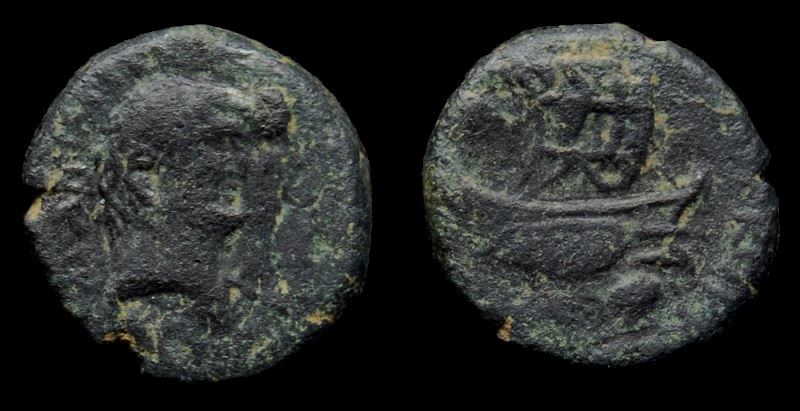
Reverse: M OPPIVS CAPITO PRO PR PRAEF CLASS F C - Galley right, below A.
Die Orientation: -
Weight: 3.69 g
"M. Oppius Capito was Antony’s senior naval officer, stationed at the main naval base at Piraeus. His coins are found distributed around central Greece, and were most likely struck at Piraeus. His coins are found in two series, a heavy and a light and it has been suggested that some were struck at Tarentum where part of Antony’s fleet was based during the joint action against Sextus Pompey in 37-36 BC"
"The coin illustrated here is an as, marked A, with jugate portraits of Antony and Octavia on the obverse, a galley under sail on the reverse. It falls into the "light" series, perhaps issued a year after the first release of the coins, on a lighter standard, in the name of Antony and Oppius Capito. Although this experimental coinage was short-lived and very rare today, it is interesting to note that the great currency reform started by Octavian, after he had taken the name Augustus and become the first Emperor of Rome, resulted in a bronze coinage using exactly the same denominations as Anthony's fleet issues."
Provenance: Private purchase (August 2017).
.png)
Reverse: M OPPIVS CAPITO PRO PR PRAEF CLASS F C - Galley right; A below.
Die Orientation: 11 H
Weight: 6.69 g

Reverse: M OPPIVS CAPITO PRO PR PRAEF CLASS F C - Two quinqueremes sailing right; caps of Dioscuri above, B below.
Die Orientation: 0 H
Weight: 7.76 g
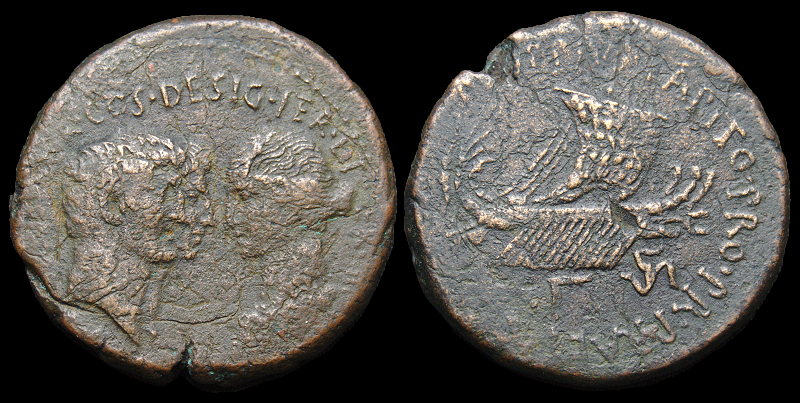
Reverse: M•OPPIVS•CAPITO•PRO•PR•PRAEF•CLASS•F•C - Three galleys under sail to right. Γ (Gamma) and Triskeles below.
Die Orientation: -
Weight: 25.78 g
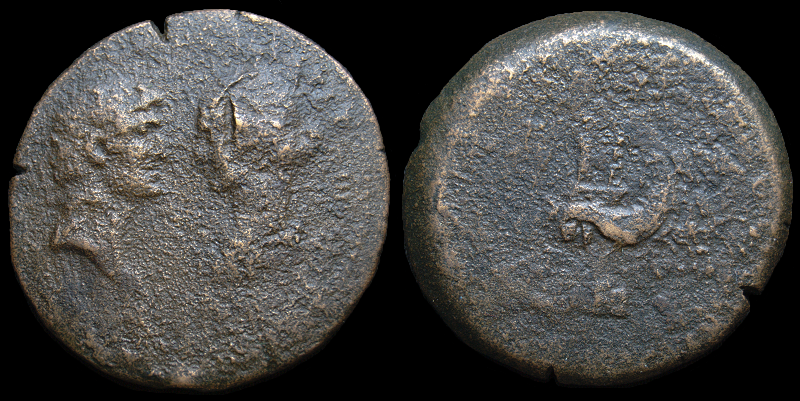
Reverse: M • OPPIVS • CAPITIO • P[R) • PR • PRAEF • CLASS • F • C • - Mark Antony and Octavia in quadriga of hippocamps; in l. field, HS and below, Δ and astragalos.
Die Orientation: -
Weight: 30.16 g
.png)
Reverse: L•BIBVLVS•M•F•PR•DESIG, quinquereme right, with three oars and stern ending in boar's head left.
Die Orientation: 0 H
Weight: 4.92 g
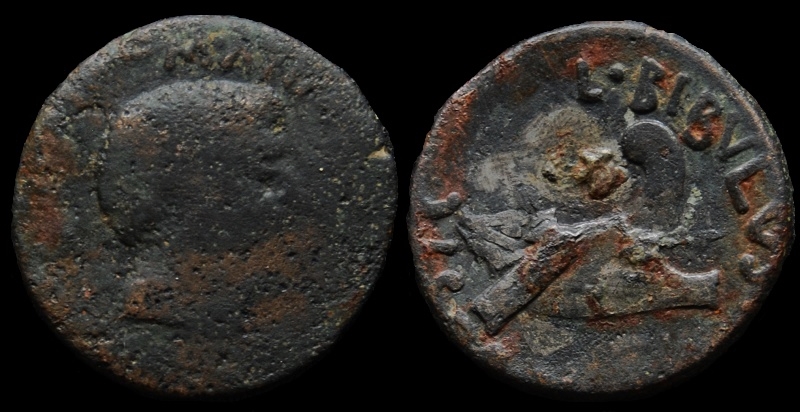
Reverse: L•BIBVLVS•M•F•PR•DESIG, quinquereme right, with three oars and stern ending in boar's head left.
Die Orientation: 0 H
Weight: 3.61 g
Provenance: Private purchase (May 2018).

Reverse: Bull reclining left on ground line; ϹΚΓ Μ (below), ΙΑΝ and kof (above).
Die Orientation: -
Weight: 9.09 g
.png)
Reverse: BAΛANEΩTΩN AP CY - Indian Dionysos in quadriga left.
Die Orientation: 3 H
Weight: 8.77 g
.png)
Reverse: Bellerophon mounted on Pegasus prancing to right, preparing to strike with his spear the Chimaera at his right. - L • CAECIL • NIGR/ C • HEIO P AM above, II VIR in exergue
Die Orientation: 9 H
Weight: 6.55 g
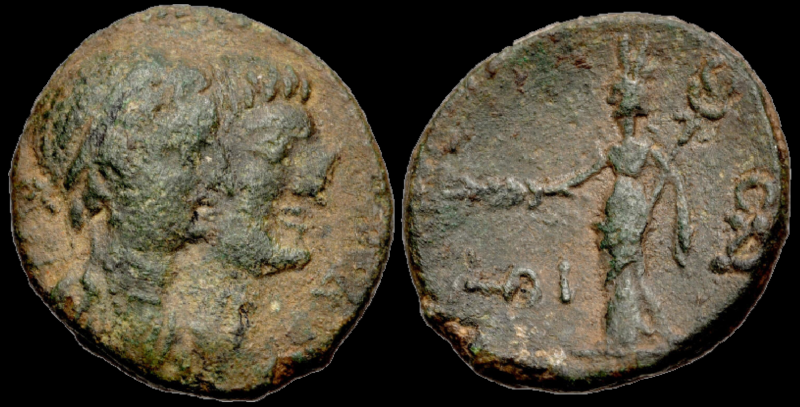
Reverse: Tyche of Dora standing left, holding palm frond and caduceus; L ΘΙ (date) to left; Ω/Δ to right.
Die Orientation: 12 H
Weight: 7.28 g
.png)
Reverse: ANTONIVS/AVG • IMP • III in two lines.
Die Orientation: 5 H
Weight: 3.84 g
"The carefully concealed letter "P" behind the ear of Antony's portrait represents the only known example of an artist's signature on a Roman Republican coin. The letter went unnoticed by numismatists for centuries before it was recognized in the early decades of the twentieth century."
.jpg)
Reverse: TRIB POT COS DES II, Pietas, veiled, standing left, raising hand and holding incense box; to left, altar; S-C in fields; PIETAS in exergue
Die Orientation: 12 H
Weight: 22.77 g
Minted circa February 25th-July 10th, 138 AD
.jpg)
Reverse: LI-Z (year 17), Eagle standing facing, on thunderbolt, head left, wings spread References: Köln 169
Die Orientation: 12 H
Weight: 24.05 g
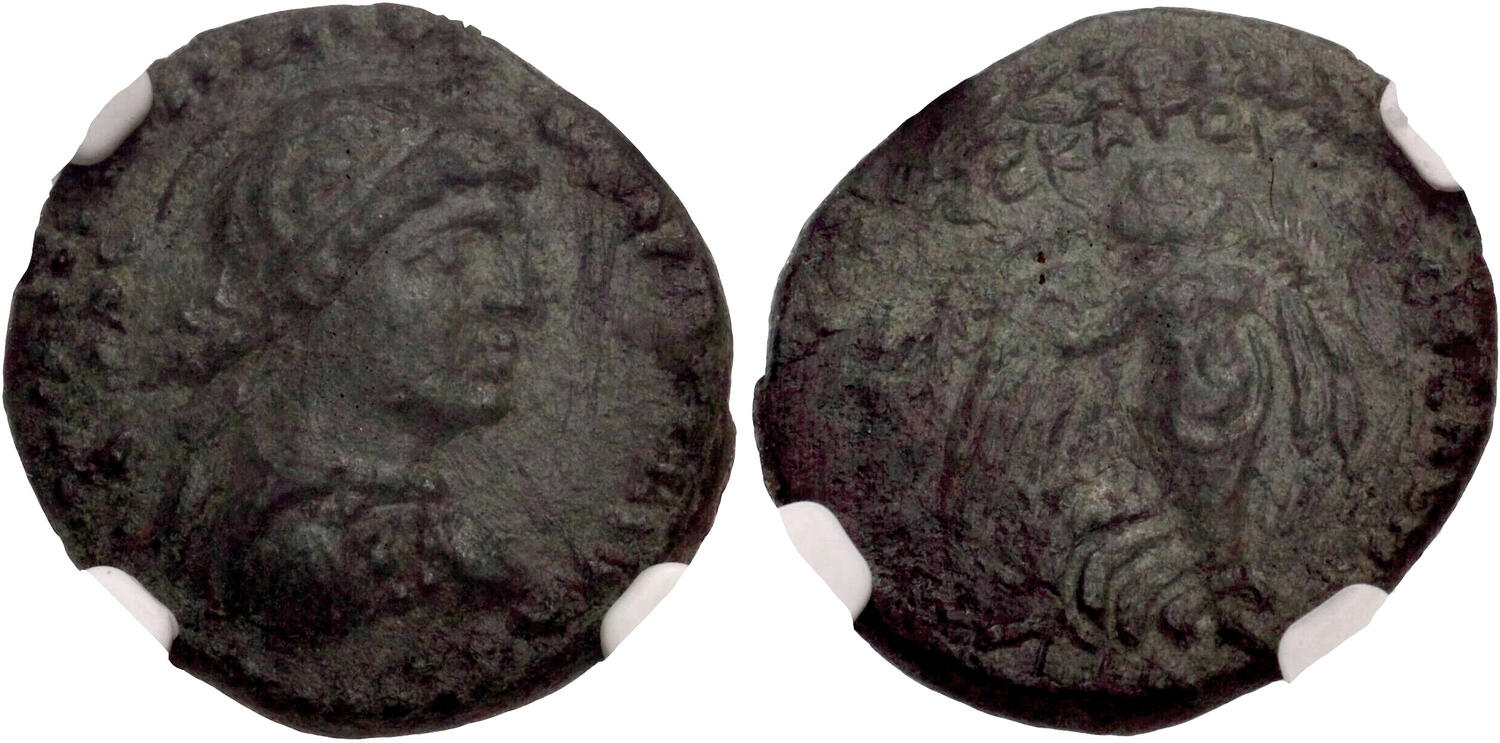
Reverse: Nike advancing right with palm and wreath; ƐΤΟΥϹ ΚΑ ΤΟΥ ΚΑΙ Ϛ ΘΕΑϹ ΝƐWΤƐΡΑϹ around; all within wreath.
Die Orientation: 11 H
Weight: 3.89 g
.jpg)
Reverse: AVGVSTA, Throne, draped and ornamented, on which is a wreath; against it, on left, rests transverse scepter pointing upwards, to right
Die Orientation: 6 H
Weight: 2.61 g
_WHITE.jpg)
Reverse: Jupiter, holding sceptre and brandishing thunderbolt, in quadriga driven to right by Victory; ROMA incuse on tablet below
Die Orientation: 11 H
Weight: 6.76 g
(0).jpg)
Reverse: Sol in quadriga right, holding reins and whip; M•ABVRI below horses, ROMA in exergue
Die Orientation: 12 H
Weight: 3.85 g
(8).JPG)
Reverse: M•METELLVS Q•F, Macedonian shield with elephant's head in central boss, surrounded by laurel wreath
Die Orientation: 6 H
Weight: 3.85 g
.jpg)
Reverse: Libertas driving quadriga right, holding pileus in right hand; Victory flying left above, crowning Libertas; M•PORC below, ROMA in exergue
Die Orientation: 5 H
Weight: 3.96 g
(9).JPG)
Reverse: Galley left with three rowers, gubernator at stern; C•FONT above, ROMA below
Die Orientation: 7 H
Weight: 3.7 g
(25).jpg)
Reverse: Jupiter standing facing, holding sceptre and thunderbolt, between Juno and Minerva, the latter crowning Jupiter with wreath; palm branch in central field, dolphin in right field, ROMA (divided by eagle) in exergue
Die Orientation: 5 H
Weight: 4.03 g
.jpg)
Reverse: Victory driving biga right, L FLAMINI below, CILO in exergue
Die Orientation: 4 H
Weight: 4.01 g
.jpg)
Reverse: Mars walking left, holding spear and carrying trophy over left shoulder; L•VALERI FLACCI and apex before; corn-ear behind
Die Orientation: 2 H
Weight: 3.96 g
(11).JPG)
Reverse: Two warriors in combat, one on left protecting a fallen man; Q•TERM•MF in exergue
Die Orientation: 6 H
Weight: 3.94 g
(10).JPG)
Reverse: Bull charging right, X above, L•THORIVS below, BALBVS in exergue
Die Orientation: 7 H
Weight: 3.8 g
(1).jpg)
Reverse: Victory standing right, crowning trophy; CN LENT in exergue (NT in monogram)
Die Orientation: 2 H
Weight: 1.85 g
.jpg)
Reverse: Infant Genius (or Cupid) seated on goat right; pilei of the Dioscuri above; below, thrysus right; all within wreath
Die Orientation: 3 H
Weight: 4.07 g
(13).JPG)
Reverse: Corn ear, fasces and caduceus
Die Orientation: 12 H
Weight: 3.93 g
_2.jpg)
Reverse: Victory in triga right; C NÆ BALB in exergue
Die Orientation: 5 H
Weight: 3.91 g
(2).jpg)
Reverse: Cybele seated in biga of lions right; O above, M VOLTEI M F in exergue
Die Orientation: 6 H
Weight: 3.89 g
.jpg)
Reverse: Distyle temple with figures of draped Jupiter and Libertas standing facing within; C EGNATIVS CN F below, CN N upwards to right, control numeral (VIII) to left
Die Orientation: 2 H
Weight: 3.96 g
(14).jpg)
Reverse: The Calydonian boar standing right, it’s front legs thrust forward, pierced through by a spear and harried by a hound below; C•HOSIDI•C•F in exergue.
Die Orientation: 6 H
Weight: 3.98 g
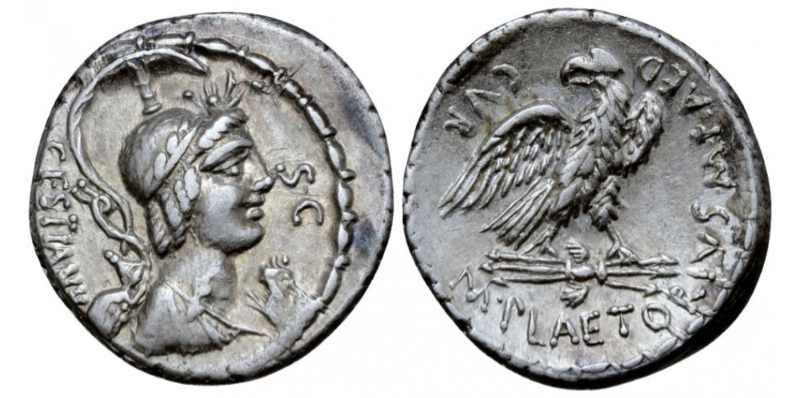
Reverse: Eagle standing right on thunderbolt, head left; M• PLAETORIVS M•F•AED•CVR around
Die Orientation: 7 H
Weight: 3.97 g
(19).jpg)
Reverse: Disjointed horse left, with rectangular head, body of crescents, four vertical legs, three roughly horizontal lines for tail; pellet below; twelve pellets above
Die Orientation: 0 H
Weight: 2.99 g
(15).JPG)
Reverse: Valetudo standing left, holding snake and resting on column; MN ACILIVS III VIR VALETV around
Die Orientation: 6 H
Weight: 3.45 g
(16).JPG)
Reverse: Aurora flying right, conducting the four horses of the sun and holding palm frond; PLANCVS below
Die Orientation: 4 H
Weight: 3.86 g
(18).jpg)
Reverse: Stylised horse prancing right, with grain ear mane; [pelletal sun above], reversed S before, pellet triad, line of three pellets and [obscured monogram] below
Die Orientation: 9 H
Weight: 1.24 g
Before the Romans arrived Britain was shared by several Celtic tribes; the Iceni being centred on the Norfolk area (but also occupying surrounding parts of Suffolk and Cambridgeshire). The Iceni are probably best known as the tribe that, united with the Trinovantes (from the area north east of London), ran riot over Roman rule under their warrior queen Boudicca. This coin, whose Celtic name has never been discovered, is simply referred to as a ‘silver unit’. It is tiny at just 14mm diameter and weighing in at 1.24g. All of these coins weighed the same (1.25g); a standard which was maintained for over 100 years to an extremely small tolerance, an amazing techical achievement for the time. As with all Celtic coinage the design is somewhat abstract. On the obverse is an ornate pattern, resembling 2 C’s back to back across an ornate belt, with patterns around. This has been progressively derived from the hair & laurel head band of Apollo on Greek coins, whose face has since disappeared. The reverse shows a horse galloping towards the right, a dotted wheel above it’s back, and various dots around. The charioteer has disappeared, and what remains of the chariot is the wheel floating above. Some of the dots and symbols are not mere random decoration but part of a series of coded control marks, probably denoting the issuing mint and moneyer. The coins were struck on concave blanks which were only about two-thirds of the size of the dies, so the entire design is never seen on one specimen.
(2).JPG)
Reverse: COL-NEM, palm tree curving to right, crocodile right chained below, wreath to left of palm tip with long ties trailing to right
Die Orientation: 6 H
Weight: 12.45 g
(26).jpg)
Reverse: SIGNIS RECEPT DEVICTIS GERM, Germanicus, bare-headed, wearing cuirass and short tunic, standing left, cloak over arm in which he cradles aquila, and extending hand in gesture of command; S-C across lower fields
Die Orientation: 6 H
Weight: 11.46 g
(39).jpg)
Reverse: Neptune standing left, holding small dolphin and trident; S-C across fields
Die Orientation: 6 H
Weight: 9.57 g
(40).jpg)
Reverse: DIVA AVGVSTA, Livia standing left, holding patera and sceptre
Die Orientation: 5 H
Weight: 3.2 g
(41).jpg)
Reverse: SECVRITAS P R, Securitas standing left holding wreath and sceptre
Die Orientation: 6 H
Weight: 3.15 g
(17).JPG)
Reverse: IMP T CAES DIVI VESP F AVG P M TR P P P COS VIII RESITV, S C in centre
Die Orientation: -
Weight: 10.79 g
(30).jpg)
Reverse: TR P IX IMP XV COS VIII P P, dolphin coiled around anchor
Die Orientation: 6 H
Weight: 3.28 g
(38).JPG)
Reverse: Spes advancing left, holding flower and raising skirt; S-C across field
Die Orientation: 7 H
Weight: 25.03 g
(28).jpg)
Reverse: VIRTVTI AVGVSTI, Virtus standing right, left foot on helmet, holding spear and parazonium; S C across fields
Die Orientation: 7 H
Weight: 10.56 g
(18).JPG)
Reverse: IMP XXII COS XVI CENS P P P, Minerva standing left, holding spear
Die Orientation: 6 H
Weight: 3.58 g
(42).jpg)
Reverse: FORTVNA AVGVST, Fortuna standing left, holding rudder and cornucopiae; S-C across fields
Die Orientation: 6 H
Weight: 12.96 g
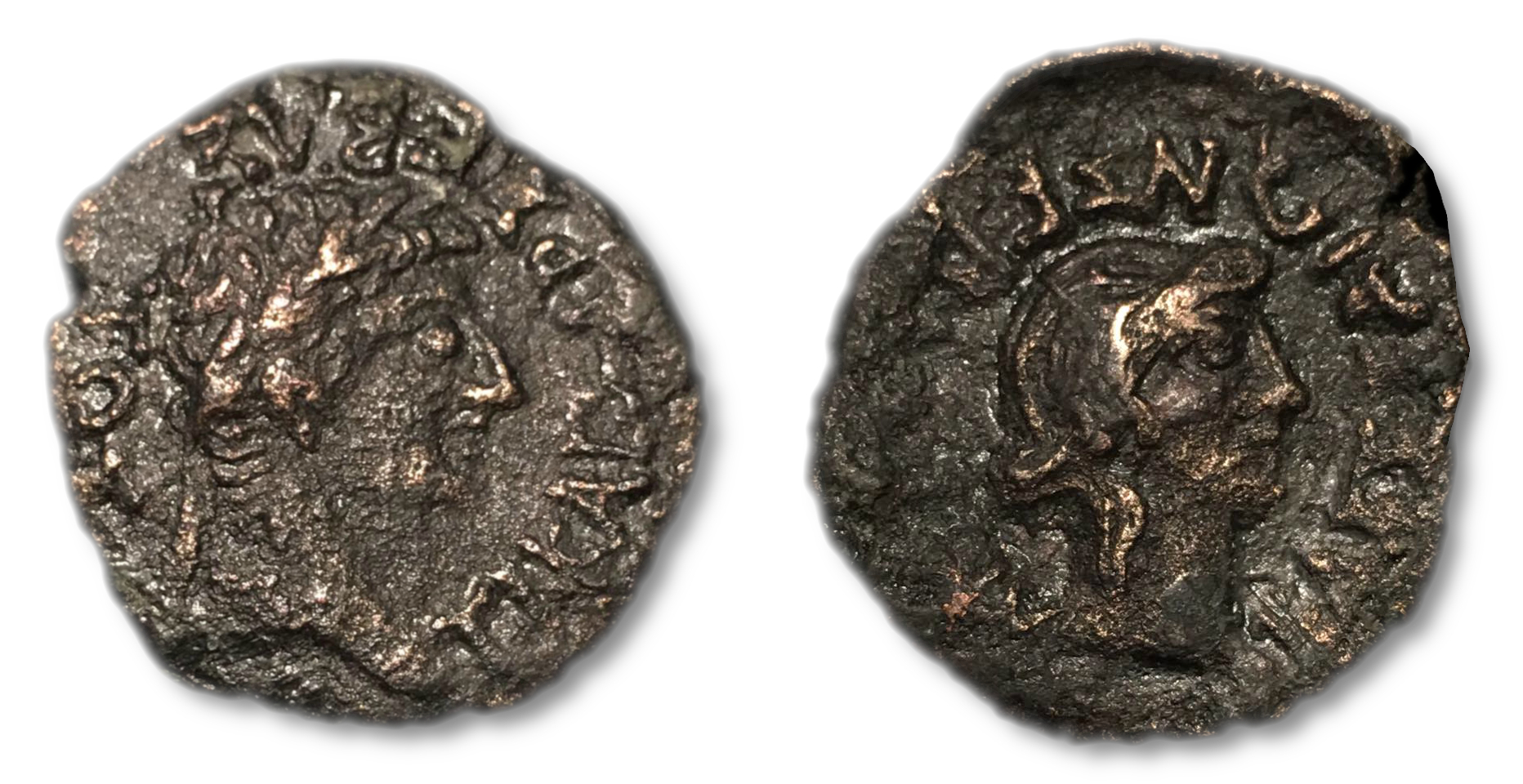
Reverse: SEBASTH EDESSAIWN / head of Livia right.
Die Orientation: -
Weight: 6.38 g
(19).JPG)
Reverse: SPQR OPTIMO PRINCIPI, Trajan’s column, surmounted with statue of the Emperor, with two eagles at base
Die Orientation: 7 H
Weight: 3.22 g
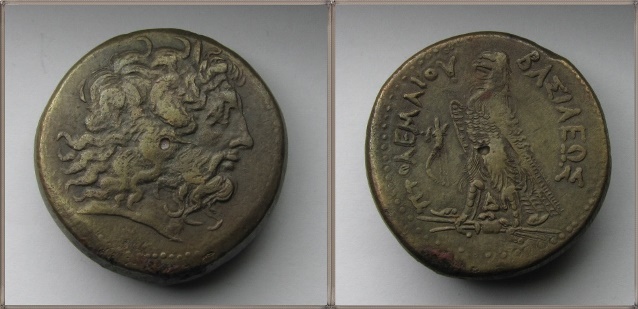
Reverse: ΠΤΩΛΕΜΑΙΟΥ ΒΑΣΙΛΕΩΣ Eagle standing left on thunderbolt; cornucopiae left, ΔΙ between legs.
Die Orientation: 4 H
Weight: 73.07 g
(1).jpg)
Reverse: P M TR P COS VI P P S P Q R, Mars advancing right, carrying spear and trophy
Die Orientation: 6 H
Weight: 3.22 g
(21).JPG)
Reverse: COS III, Aequitas seated left, holding scales and cornucopiae; S C in exergue
Die Orientation: 5 H
Weight: 10.41 g
(29).jpg)
Reverse: CONCORDIA AVG, Concordia seated left, holding patera and sceptre
Die Orientation: 6 H
Weight: 3.19 g
(43).jpg)
Reverse: Diana standing left, holding bow and arrow; S-C across fields
Die Orientation: 6 H
Weight: 25.22 g
(4).JPG)
Reverse: Two canopic jars; L IH (date) across field
Die Orientation: 12 H
Weight: 26.06 g
(22).JPG)
Reverse: AFRICA, Africa reclining left, holding scorpion and cornucopiae, basket of grain at feet
Die Orientation: 12 H
Weight: 3.35 g
.jpg)
Reverse: VENERIS FELICIS, Venus seated left on throne, holding Cupid and sceptre
Die Orientation: 6 H
Weight: 2.63 g
(5).JPG)
Reverse: IOVΛIЄШN TШN KAI ΛAOΔIKЄWN, draped and turreted bust of Tyche right, bunches of grapes as earrings; HΠP in left field and MO in right field
Die Orientation: 1 H
Weight: 9.84 g
(0).jpg)
Reverse: AVGVSTA, Ceres standing left, holding long torch in her right hand, and supporting drapery in left
Die Orientation: 6 H
Weight: 3.61 g
(11).jpg)
Reverse: CONSECRATIO, peacock walking right, head left.
Die Orientation: 5 H
Weight: 3.54 g
(44).jpg)
Reverse: [SECVRITAS] PVBLICA, Securitas sanding left, holding sceptre and leaning on column; S-C across fields
Die Orientation: 12 H
Weight: 9.68 g
.jpg)
Reverse: TR POT VI COS II, Genius Exercitus, holding standard and sacrificing from patera over altar
Die Orientation: 5 H
Weight: 3.23 g
(45).jpg)
Reverse: LIBERTAS COS IIII, Libertas standing facing, head right, holding pileus in left hand and with right arm outstretched; S-C across fields
Die Orientation: 11 H
Weight: 22.92 g
(32).jpg)
Reverse: FELIC SAEC COS IIII, Felicitas standing left, holding caduceus and resting on column
Die Orientation: 6 H
Weight: 3.09 g
(46).jpg)
Reverse: [C]O[NSECRA]TIO, eagle flying right, bearing aloft Marcus Aurelius, holding sceptre; S C across fields
Die Orientation: 5 H
Weight: 23.95 g
_2.jpg)
Reverse: IVPPITER CONSERVATOR TR P VI IMP IIII COS III P P, Jupiter standing left, extending thunderbolt and cloak over small figure of Commodus at his feet and holding sceptre; S-C across fields
Die Orientation: 5 H
Weight: 24.77 g
(33).jpg)
Reverse: PM TR P XIII IMP VIII COS V P P, Aequitas standing left, holding scales and cornucopia
Die Orientation: 1 H
Weight: 3.14 g
(7).JPG)
Reverse: P M TR P COS, Fortuna standing left, holding rudder in lowered right hand above globe at feet to left, and cornucopiae in left hand
Die Orientation: 7 H
Weight: 2.72 g
(48).jpg)
Reverse: AEQVIT AVG TR P COS II, Aequitas standing left holding scales and cornucopiae
Die Orientation: 7 H
Weight: 3.18 g
(47).jpg)
Reverse: IVSTITIA AVGVSTI, Justitia (or Aequitas) standing left, holding scales and cornucopiae
Die Orientation: 12 H
Weight: 2.79 g
(23).JPG)
Reverse: VENERI VICTR, Venus, seen from behind standing right, leaning on column, half nude with drapery hanging low beneath her posterior, holding palm branch and apple
Die Orientation: 12 H
Weight: 2.03 g
(34).jpg)
Reverse: PRINC IVVENTVTIS, Geta, in military dress, standing left, holding branch and spear; behind, trophy
Die Orientation: 7 H
Weight: 3.7 g
(65).jpg)
Reverse: PART MAX P M TR P VIIII, two captives seated at foot of trophy
Die Orientation: 12 H
Weight: 2.43 g
(49).jpg)
Reverse: INDVLGENTIA AVGG, the Dea Caelestis, holding thunderbolt and sceptre, riding on lion right over waters gushing from rock, IN CARTH in exergue
Die Orientation: 12 H
Weight: 3.41 g
(15).jpg)
Reverse: CONCORDIA AVGG, Concordia standing left, holding patera and sceptre
Die Orientation: 6 H
Weight: 3.03 g
(24).JPG)
Reverse: PONTIF TR P XI COS II[I], Caracalla on horseback right, holding spear; PROF in exergue
Die Orientation: 8 H
Weight: 2.71 g
(2).jpg)
Reverse: MONETA AVG, Moneta standing left, holding scales and cornucopiae
Die Orientation: 1 H
Weight: 3.26 g
(52).jpg)
Reverse: FECVNDITAS AVG, Fecunditas standing left, extending her hand over a child and holding cornucopiae
Die Orientation: 6 H
Weight: 2.77 g
(51).jpg)
Reverse: CONCORDIA, Concordia seated left, holding patera in her extended right hand, resting left arm on armrest; star in left field
Die Orientation: 12 H
Weight: 3.32 g
(53).jpg)
Reverse: FIDES MILITVM, Fides standing left, holding military standard in each hand
Die Orientation: 12 H
Weight: 2.98 g
(64).jpg)
Reverse: P M TR P IIII COS II P P, emperor in military dress, standing right, holding transverse spear and globe
Die Orientation: 6 H
Weight: 3.55 g
.jpg)
Reverse: CONCORDIA AVGG, Concordia seated left, holding patera and double cornucopiae
Die Orientation: 11 H
Weight: 3.68 g
(35).jpg)
Reverse: MARTI PROPVGNATORI, Mars advancing right, carrying spear and shield
Die Orientation: 11 H
Weight: 3.33 g
(54).jpg)
Reverse: PRINCIPI IVVENTVTIS, Hostilian standing left, holding standard and reversed spear
Die Orientation: 6 H
Weight: 3.34 g
_3.jpg)
Reverse: CONSECRATIO, peacock standing facing, tail spread in splendour
Die Orientation: 7 H
Weight: 4.05 g
(0).jpg)
Reverse: COL AVG, horse grazing right; TRO in exergue
Die Orientation: 5 H
Weight: 5.49 g
(1).JPG)
Reverse: COL AVG, horse grazing right; TRO in exergue
Die Orientation: 1 H
Weight: 5.47 g
A pseudo-autonomous issue struck during the reign of Gallienus
.JPG)
Reverse: COL AVG TRO, eagle, wings spread, standing right on head of bull
Die Orientation: 11 H
Weight: 5.69 g
(20).JPG)
Reverse: COL AVG, she-wolf standing right, suckling the twins Romulus and Remus; TRO in exergue
Die Orientation: 6 H
Weight: 4.88 g
.jpg)
Reverse: PIETAS AVGG, Valerian and Gallienus standing facing each other, sacrificing over altar
Die Orientation: 12 H
Weight: 3.69 g
.jpg)
Reverse: LEG I ADI VI P VI F, capricorn right
Die Orientation: 11 H
Weight: 3.19 g
(57).jpg)
Reverse: ROMAE AETERNAE, Roma seated left on shield, holding Victory and spear
Die Orientation: 5 H
Weight: 4 g
(36).jpg)
Reverse: IVNO REGINA, Juno standing left, holding patera and sceptre; KAϛ in exergue
Die Orientation: 6 H
Weight: 2.98 g
(59).jpg)
Reverse: PAX AVGG, Pax standing left, holding Victory on globe and transverse sceptre; III in exergue
Die Orientation: 12 H
Weight: 3.59 g
.jpg)
Reverse: AETERNITAS AVG N, The Dioscuri standing facing each other, each holding sceptre and bridles of their horse
Die Orientation: 11 H
Weight: 7.15 g
(60).jpg)
Reverse: MEMORIA FELIX, lighted altar adorned with garlands, eagle standing on either side; P LN in exergue
Die Orientation: 5 H
Weight: 5.54 g
(37).jpg)
Reverse: VENERI VICTRICI, Venus standing facing, head left, holding apple in upraised right hand and with left raising drapery over left shoulder, with altar at feet to left; star in left field, Δ in right field, ANT in exergue
Die Orientation: 11 H
Weight: 6.61 g
(61).jpg)
Reverse: She-wolf standing left, suckling Romulus and Remus; two stars above, SMANΘ in exergue
Die Orientation: 5 H
Weight: 2.94 g
(62).jpg)
Reverse: SECVRITAS PVBLICA, Euphrates seated right on ground, leaning on sceptre with urn at his side and reed in background; CONSS in exergue
Die Orientation: 5 H
Weight: 1.44 g
.jpg)
Reverse: FEL TEMP REPARATIO, soldier left, spearing fallen horseman, shield on ground to right; ASIS (reverse Z) in exergue
Die Orientation: 1 H
Weight: 2.17 g
(1).jpg)
Reverse: VOTIS XXX MVLTIS XXXX in four lines within wreath; SCON in exergue
Die Orientation: 11 H
Weight: 1.82 g
.jpg)
Reverse: COS VIII, Mars standing left, holding spear & trophy.
Die Orientation: 0 H
Weight: 0 g
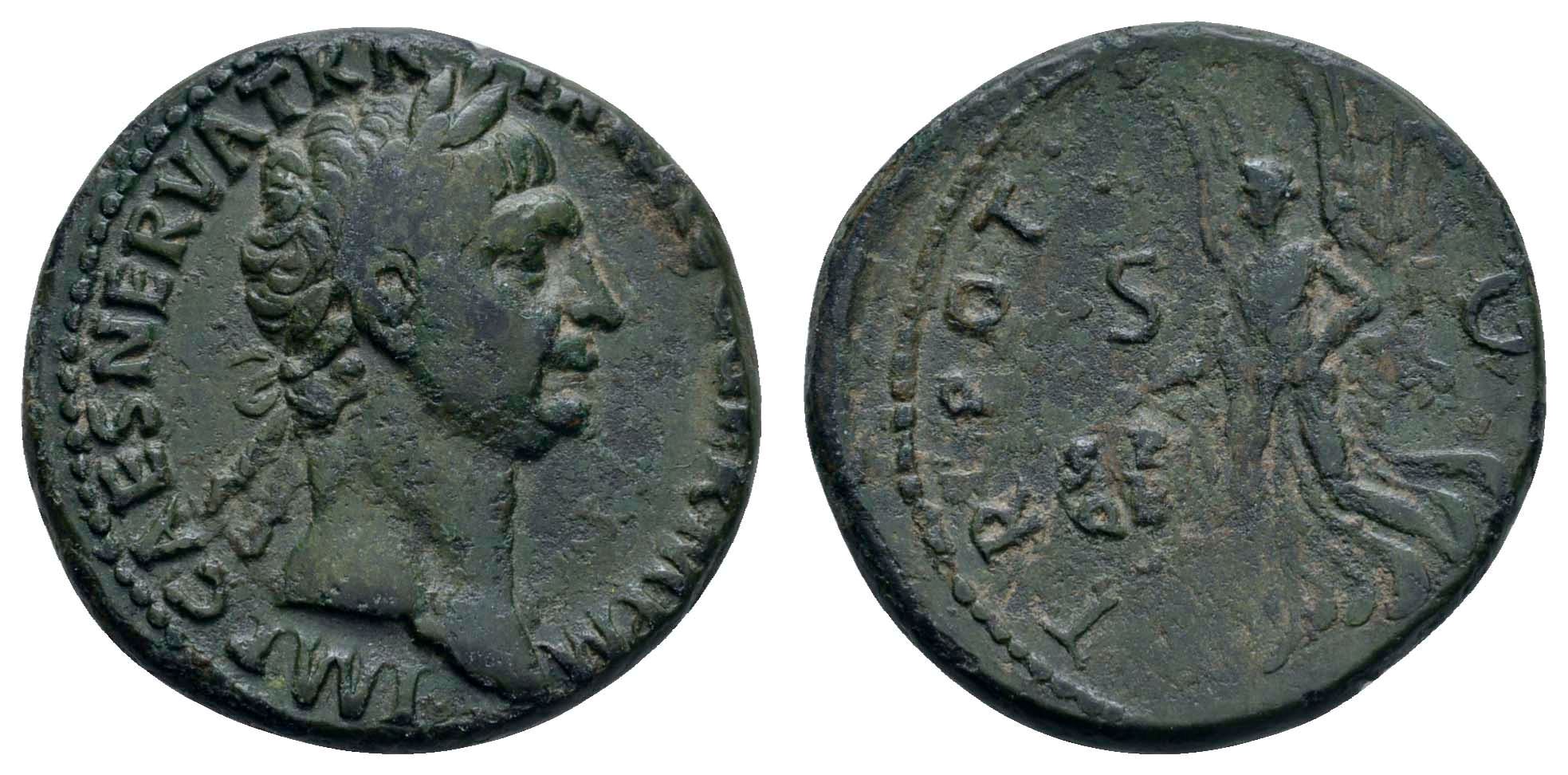
Reverse: TR POT COS II P P / Victory walking left, holding palm-branch and shield inscribed SPQR
Die Orientation: -
Weight: 11.59 g
.jpg)
Reverse: VΠA KVNTIΛIANOV MAPKIANOΠOΛITΩ-N, Tyche Soteiros (Fortuna Redux) standing left, holding rudder in outstretched right hand and cornucopiae in left; E in upper left field.
Die Orientation: -
Weight: -
.jpg)
Reverse: PROVID AVG, Providence standing left with scepter, pointing wand at globe at feet
Die Orientation: 0 H
Weight: 0 g
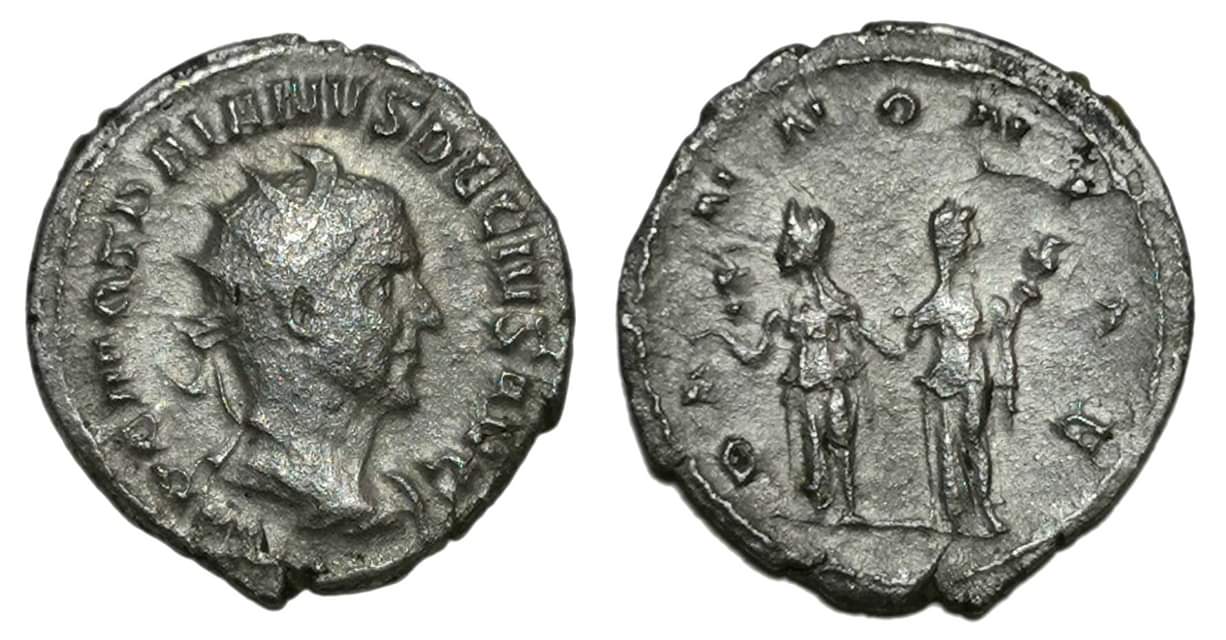
Reverse: PANNONIAE / the two Pannioniae standing half-left, looking in opposite directions, each holding standard
Die Orientation: -
Weight: -
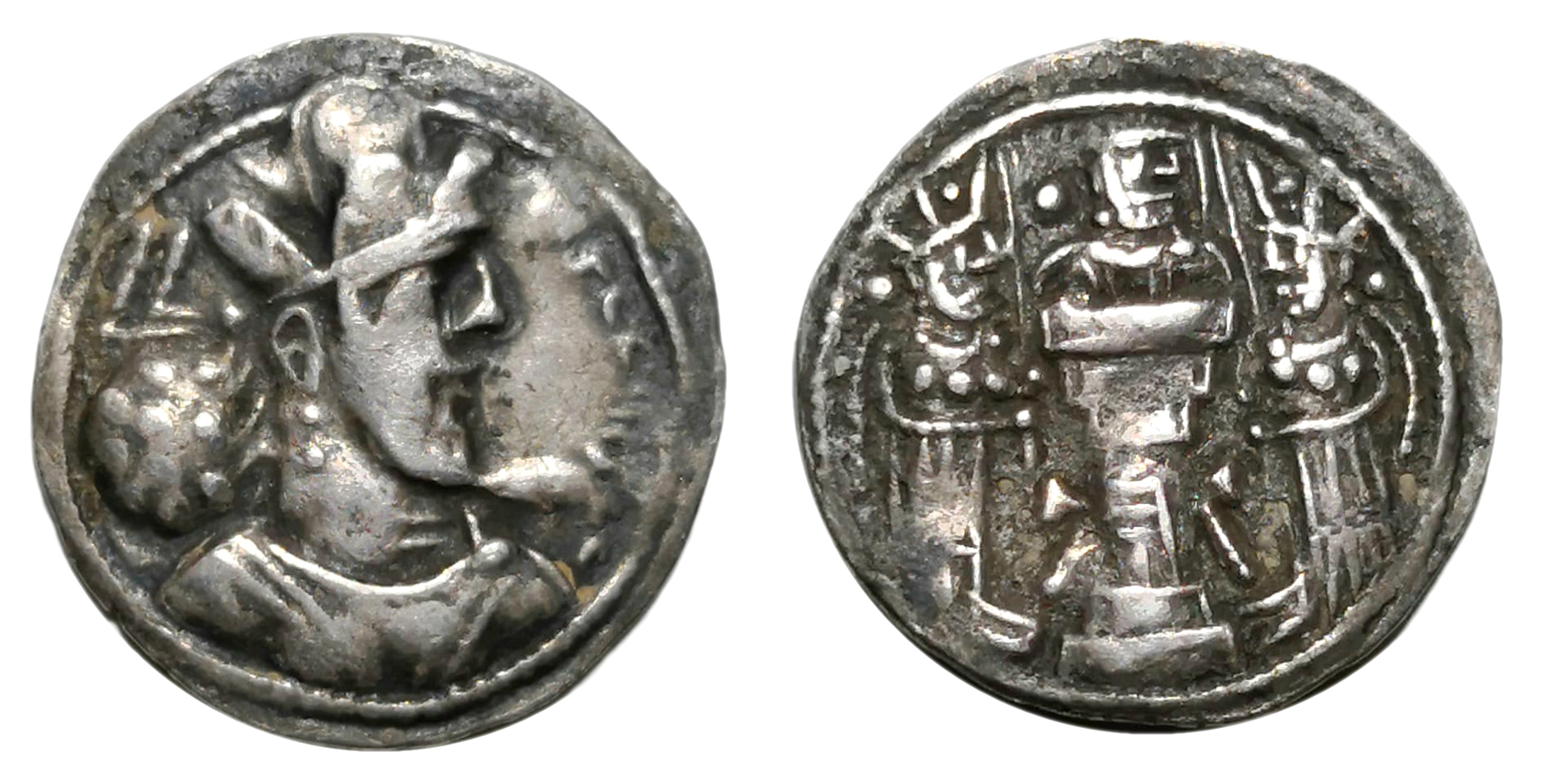
Reverse: Fire altar with two attendants; bust right within flames
Die Orientation: -
Weight: 3.96 g
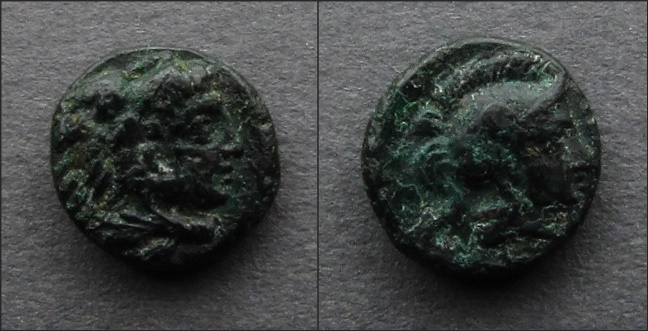
Reverse: ΠEΡ, head of Athena right in crested helmet.
Die Orientation: 6 H
Weight: 1.09 g
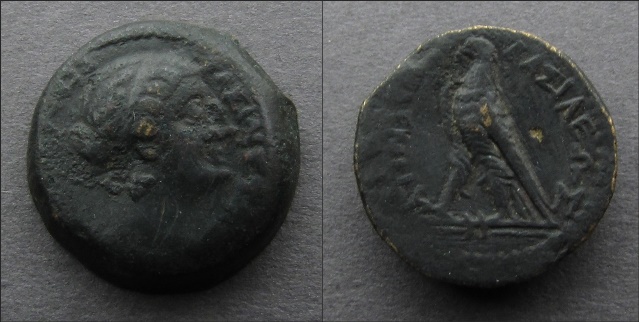
Reverse: BAΣIΛEΩΣ ΠTOΛEMAIOY, eagle standing left on thunderbolt, wings closed.
Die Orientation: 12 H
Weight: 8.78 g
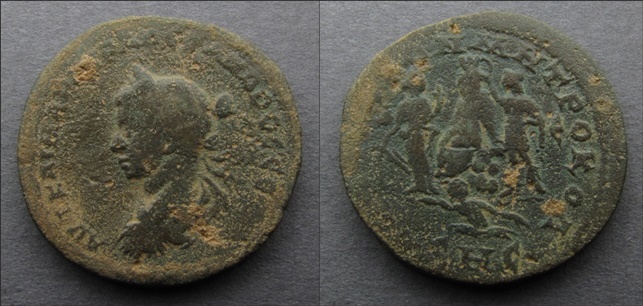
Reverse: Tyche seated left on rocks; to left, another Tyche standing right, holding rudder and cornucopia; to right, emperor standing left, crowning her; below, river-god swimming r.; Δ-E across field; H (denomination) in exergue.
Die Orientation: 12 H
Weight: 14.65 g
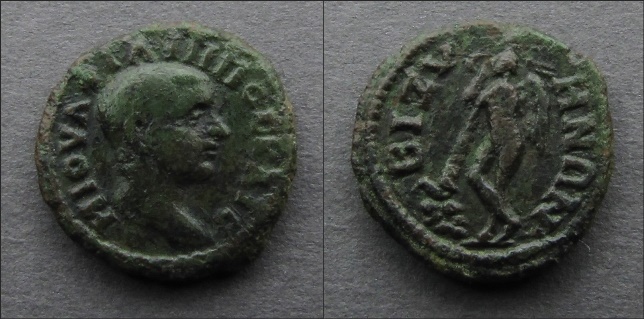
Reverse: BIZVHNΩN, Thanatos (god of death) or weary Eros extinguishing torch.
Die Orientation: 7 H
Weight: 3.32 g
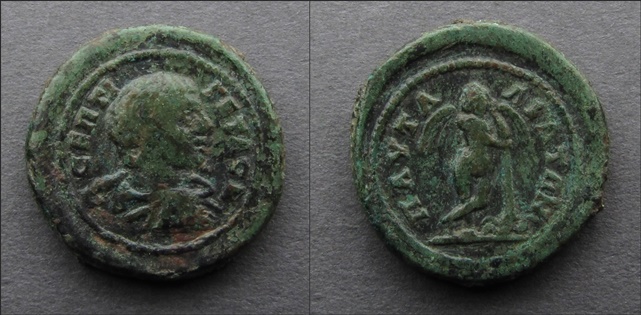
Reverse: ΠAVTA-ΛIΩTΩN, Thanatos standing slightly right, resting on lighted torch.
Die Orientation: 12 H
Weight: 6.96 g
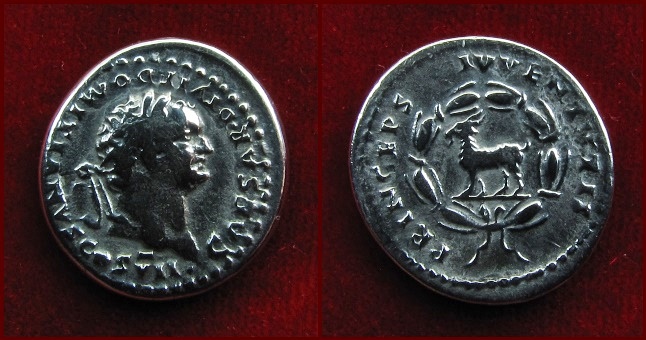
Reverse: PRICIPI IVVENTVTIS, Cretan goat standing left within laurel wreath.
Die Orientation: 6 H
Weight: 3.08 g
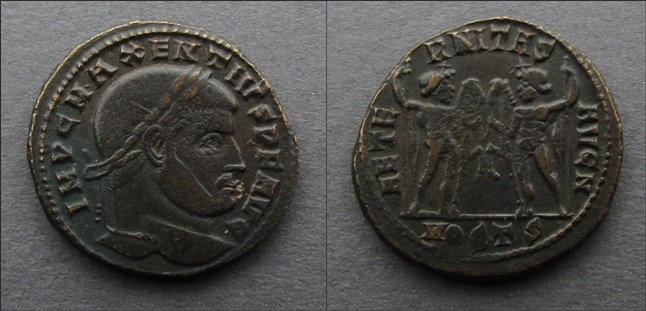
Reverse: AETERNITAS AVG N, the Dioscuri standing facing each other, their horses between; MOSTS in exergue.
Die Orientation: 12 H
Weight: 6.4 g
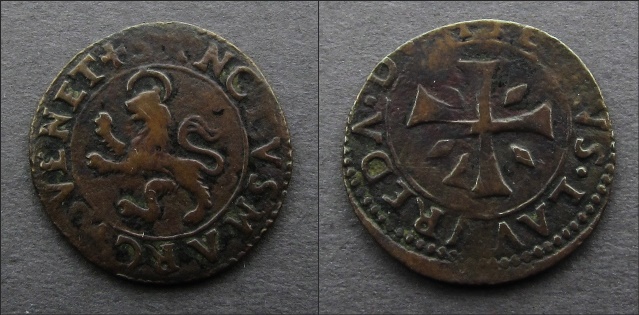
Reverse: + SΛNCTVS • MΛRCVS • VENET, lion rampant left.
Die Orientation: 11 H
Weight: 1.88 g

Reverse: Jerusalem cross.
Die Orientation: -
Weight: -
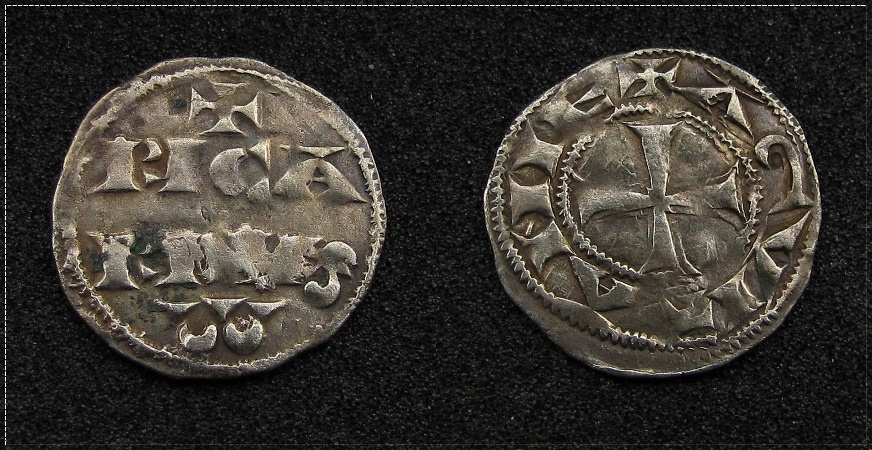
Reverse: +AQVITANIE, Cross pattee within inner circle.
Die Orientation: 0 H
Weight: 0.86 g
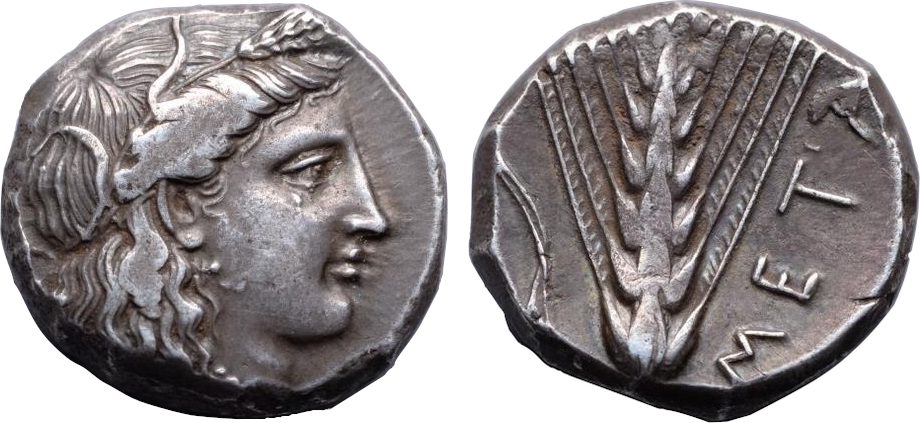
Reverse: META (Barley ear)
Die Orientation: 6 H
Weight: 8.05 g
.jpg)
Reverse: IMP VI COS III, Victory placing a shield inscribed VIC GER in two lines on trunk of palm; SC in fields
Die Orientation: 5 H
Weight: 25.22 g
.jpg)
Reverse: SALVS AVGVSTI S-C, COS III below, Salus standing left holding patera, feeding serpent arising from altar
Die Orientation: 0 H
Weight: 0 g
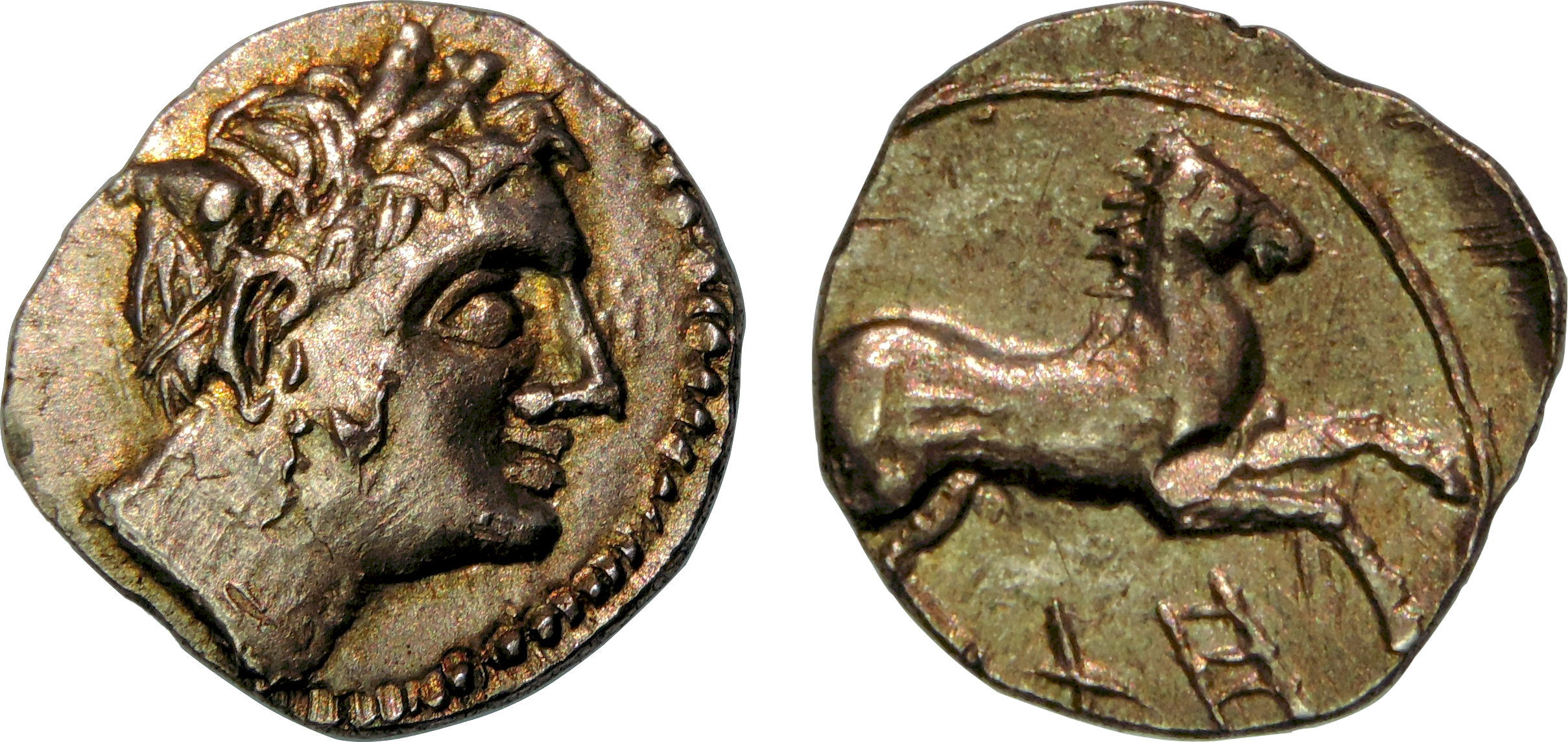
Reverse: Horse gallopping right, ḤT underneath
Die Orientation: 0 H
Weight: 1.11 g
This coin was struck during the 2nd Punic War.
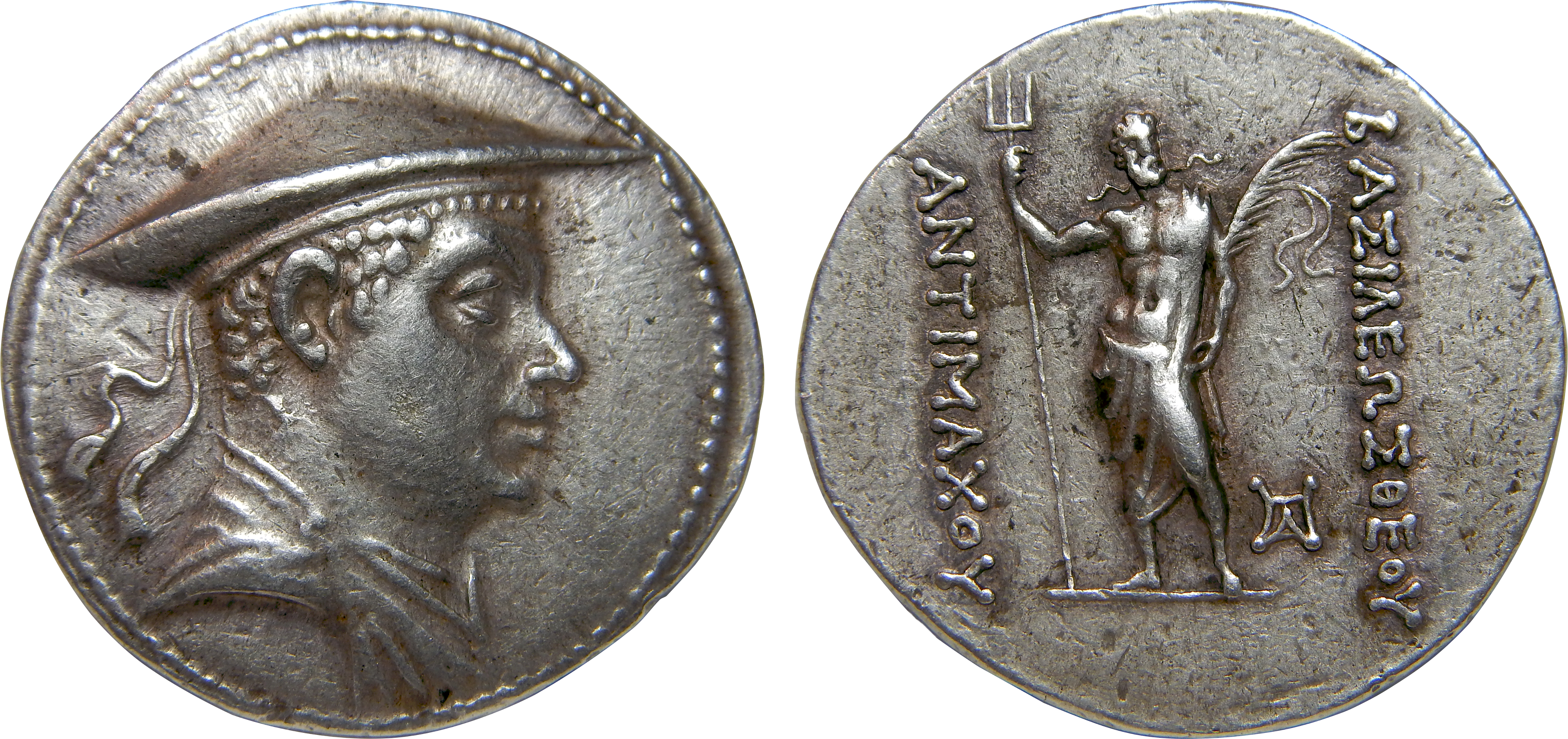
Reverse: ΒΑΣΙΛΕΩΣ ΘΕΟΥ ΑΝΤΙΜΑΧΟΥ (Poseidon stg. facing, holding trident and palm branch; in lower r. field, monogram.)
Die Orientation: -
Weight: 16.98 g
.jpg)
Reverse: Poseidon standing facing left, right foot on a dolphin, unknown object (variously described as grain ear, sword, ship's ram, aphlaston) in right hand, trident in left; LB in fields
Die Orientation: 12 H
Weight: 8.23 g
The reverse inscription translates to "Year 2" which corresponds to August 269-August 270
.jpg)
Reverse: VICTORIA AVGGG, Victory standing facing left, holding long jeweled cross; star in left and right fields; CONOB in exergue
Die Orientation: 6 H
Weight: 4.28 g
.jpg)
Reverse: VOTA PVBLICA, Inscription in three lines within laurel wreath
Die Orientation: 6 H
Weight: 3.24 g
She became an Augusta in 164 AD upon the marriage to Lucius Verus who was co-Augustus with Marcus Aurelius.
.jpg)
Reverse: P CRASSVS IVN right, LEG PRO P R left - Victory standing left, holding winged caduceus in right hand, small round shield in left
Die Orientation: 12 H
Weight: 3.15 g
During the civil war between Julius Caesar and the senatorial faction led by Pompeius Magnus ("Pompey the Great"), Scipio remained a staunch optimate. He led troops against Caesar's forces, mainly in the battles of Pharsalus and Thapsus, where he was defeated. He later committed suicide. Ronald Syme called him "the last Scipio of any consequence in Roman history."
Roma Numismatics Limited has put forward the thought that it is Tanit in leontocephalic form instead of "Genius of Africa" and the "ankh" is rather the linear female abstract symbol for Tanit. I agree with the rationality behind this, because it looks everything like that symbol and nothing like an anhk, but include the standard attributions as we know them.
.jpg)
Reverse: ΠΤΟΛΕΜΑΙΟΥ ΒΑΣΙΛΕΩΣ, Cult statue of Aphrodite standing facing
Die Orientation: 12 H
Weight: 3.26 g
Ptolemaic Kingdom
The reverse inscription translates to: "of King Ptolemy"
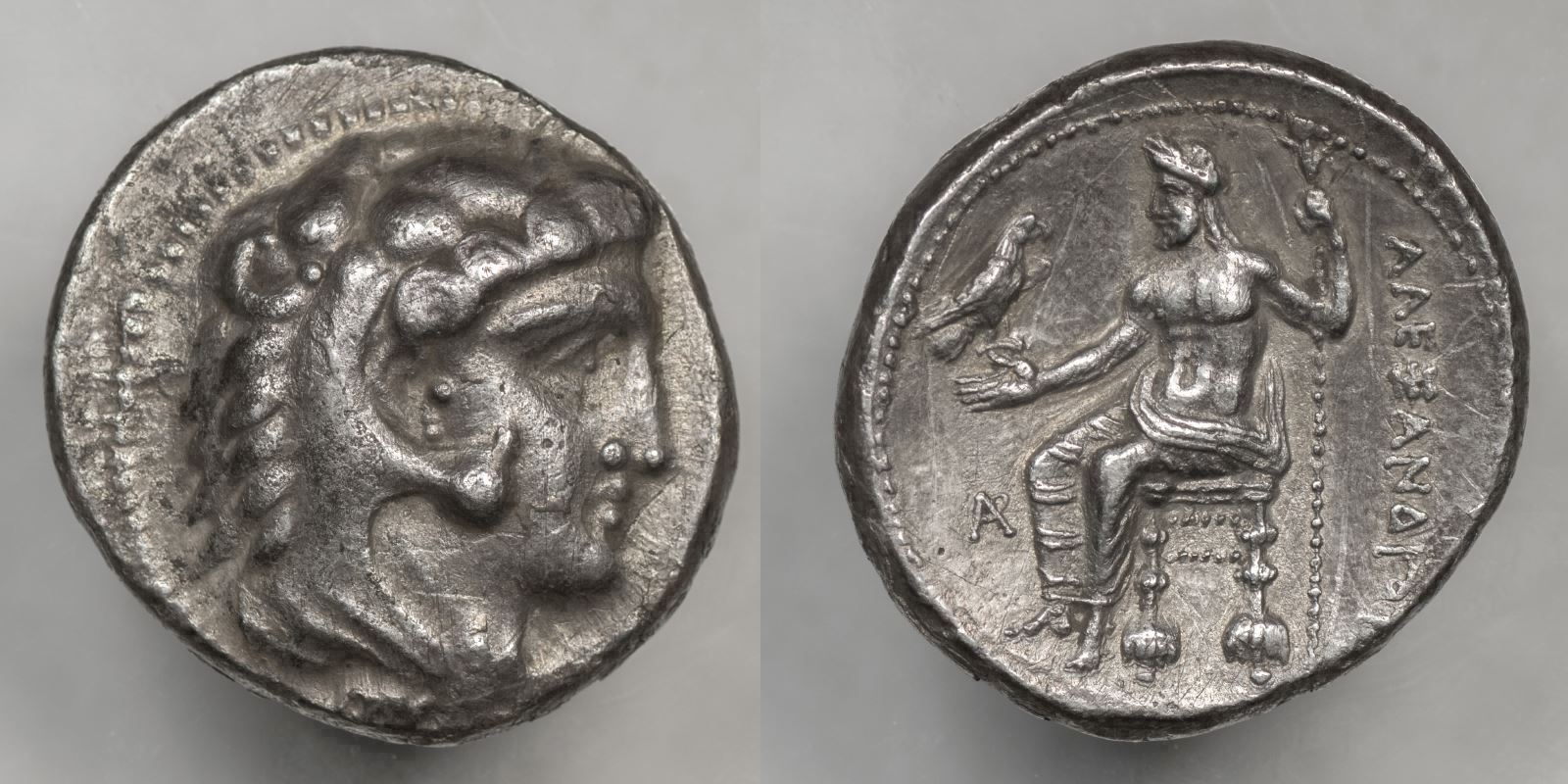
Reverse: ΑΛΕΞΑΝΔΡΟΥ, Zeus Aëtophoros seated on throne, facing left, eagle in right hand, scepter in left, legs uncrossed; AP monogram in left field
Die Orientation: 12 H
Weight: 16.26 g
The reverse inscription translates to: "of Alexander"
Price attributes this to the mint at Byblos and a time frame of 330-320 BC
Every CNG auction of this coin that I have found going back 10 years attributes the mint to Arados and the time frame to 325-323 BC making it a de facto lifetime issue, and says these were minted under authority of Menes who was Alexander's General and bodyguard. I assume this new info is attributed to a paper by Catharine Lorber but am not sure.
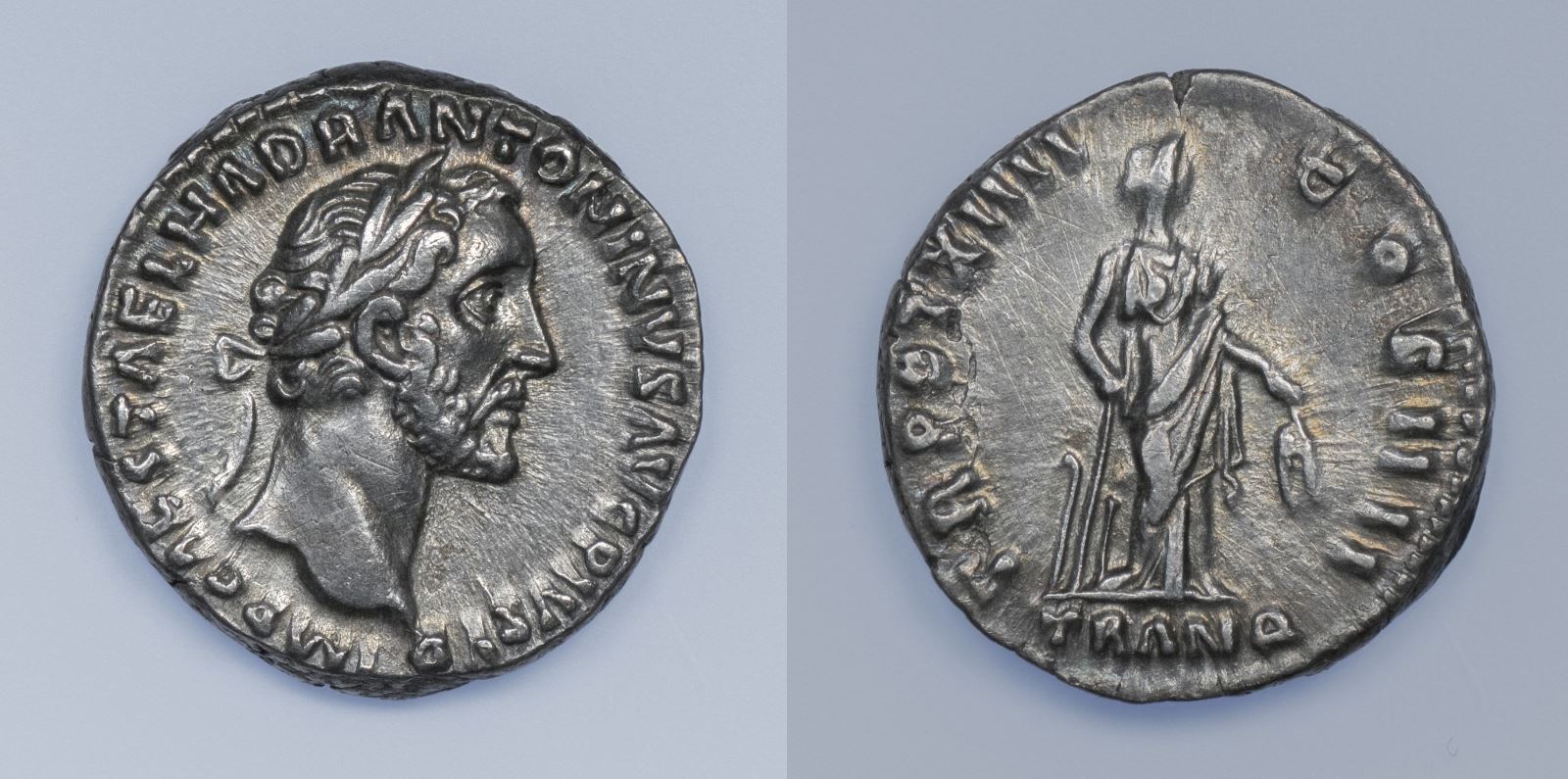
Reverse: TR POT XIIII COS IIII, Tranquilitas standing facing right, holding ship's rudder and corn ears; TRANQ in exergue
Die Orientation: 6 H
Weight: 3.65 g
Obverse: Commander-in-Chief Caesar Titus Aelius Hadrianus Antoninus Augustus the Pious, Father of the Fatherland
Reverse: Holding the power of the Tribune of the Plebs for the 14th time, Consul for the 4th time, TRANQ is just short for Tranquilitas
_hemiobol_(AE).jpg)
Reverse: Maharajasa Apaladatasa tratarasa (Tripod), monogram in field
Die Orientation: 0 H
Weight: 8.4 g
_drachm_(AR).jpg)
Reverse: Fire altar flanked by attendants, bust right in flames
Die Orientation: -
Weight: 4.04 g
_drachm_(AR).jpg)
Reverse: Maharajasa tratarasa Jhoilasa (Athena Promachos advancing left, hurling thunderbolt and holding shield), monograms in field
Die Orientation: 0 H
Weight: 2.28 g
_drachm_(AR).jpg)
Reverse: ΒΑΣΙΛΕΩΣ ΜΕΓΑΛΟΥ ΑΡΣΑΚΟΥ ΑΥΤΟΚΡΑΤΟΡΟΣ ΦΙΛΟΠΑΤΟΡΟΣ ΕΠΙΦΑΝΟΥΣ ΦΙΛΕΛΛΗΝΟΣ (Beardless archer wearing bashlyk and cloak seated right on throne, holding bow in right hand)
Die Orientation: -
Weight: 4.17 g
_tetradrachm_(AR).jpg)
Reverse: Maharajasa rajarajasa mahatasa Ayasa (Athena standing right, holding shield and spear, making benediction gesture), tamga and monogram in field
Die Orientation: 0 H
Weight: 9.81 g
_tetradrachm_(AE).jpg)
Reverse: MAO (Lunar deity Mao standing left, holding sword hilt and holding out hand in blessing, lunar crescents on shoulders), tamga in field
Die Orientation: -
Weight: 16.27 g
_obol_(AR).jpg)
Reverse: Diademed bust of king right Rev.: ΒΑΣΙΛΕΩΣ ΕΥΚΡΑΤΙΔΟΥ (Two pilei surmounted by stars and two palm branches), monogram in field
Die Orientation: -
Weight: 0.64 g
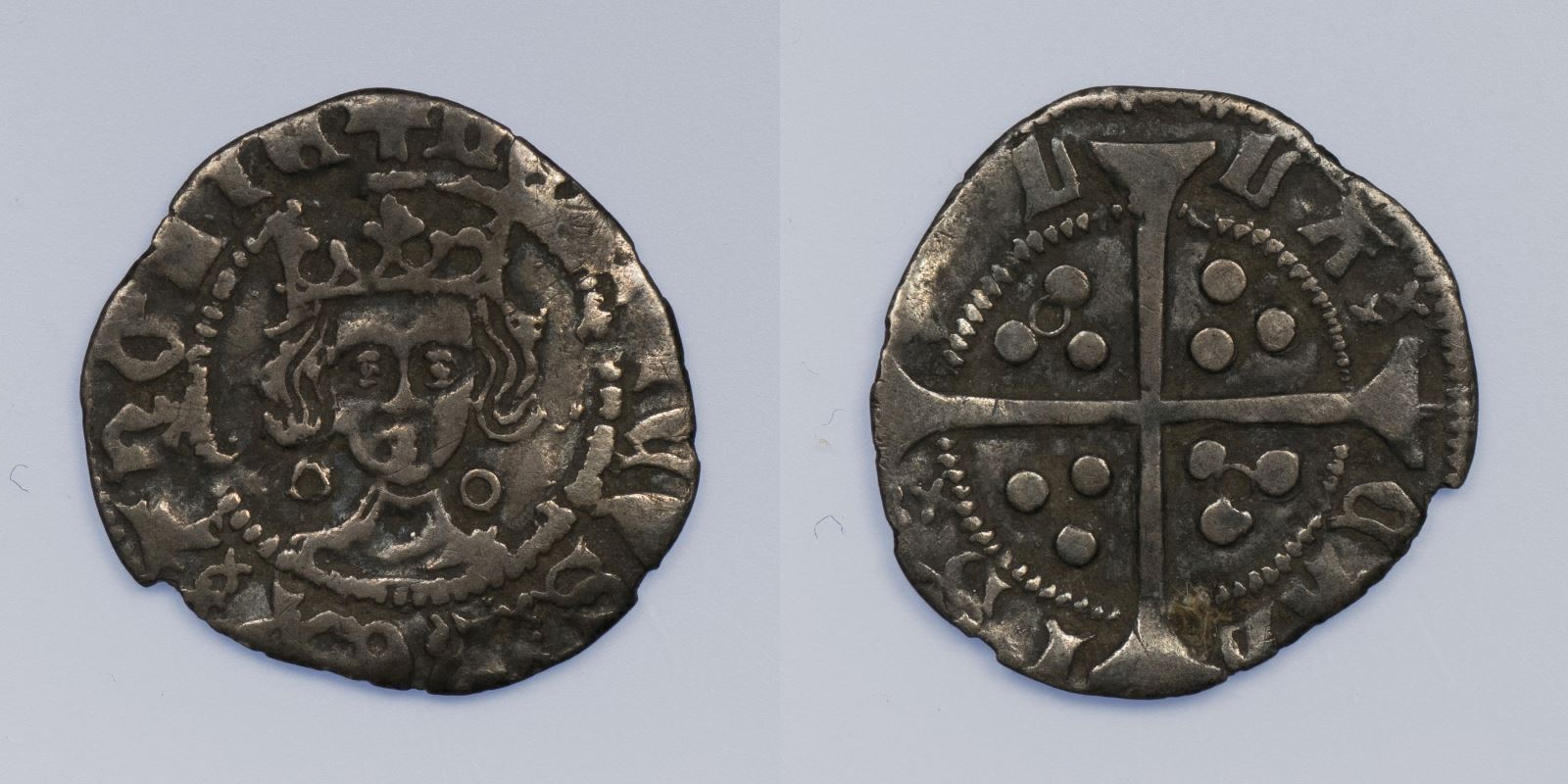
Reverse: VILLA CALIS, Long cross, three pellets in each quadrant, an anulet also in the 1st and 4th quadrants
Die Orientation: 12 H
Weight: 0.8 g
King of England and disputed King of France
AR Penny, Calais mint
_WHITE.jpg)
Reverse: Victory driving quadriga right, P•MAE ANT (ligate) below; ROMA in exergue
Die Orientation: 8 H
Weight: 3.91 g
.jpg)
Reverse: VICTORI - A AVGGG ? (officina 4) around, CONOB in exergue, Constantinipolis seated facing, head r., holding spear and cross on globe.
Die Orientation: -
Weight: 4.31 g
.jpg)
Reverse: ΕΤΟΥC ΚΑΙCΑΡΕΩΝ Γ, Head of Tyche facing right, wearing turret headdress and veil
Die Orientation: 12 H
Weight: 5.61 g
On the other hand Sydenham attributes it to Caesarea in Cappadocia.
ΚΛΑΥΔΙΟC ΚΑΙCΑΡ="Claudius Caesar"
ΕΤΟΥC ΚΑΙCΑΡΕΩΝ Γ="[object] of the People of Caesarea, Year 3"
.jpg)
Reverse: VICTORIA AVGGI, Angel standing facing, holding long P-headed cross, and cross on globe; CONOB in exergue
Die Orientation: 6 H
Weight: 4.24 g
The I at the end denotes the 10th officina.
Given that Theodosius was not raised as co-emperor until 590, it makes sense to date the coin to his reign in my opinion.
CONOB="Constantinople, 1/72 pound pure gold"
.jpg)
Reverse: GENIO POP ROM, Genius standing facing, head left, wearing tower headdress, holding patera and cornucopia; T F in fields; BTR in exergue
Die Orientation: 6 H
Weight: 3.04 g
BTR is a bit strange and I belive it is an engraving error as only PTR exists for this which follows perfect logic as in the west officina were "numbered" via the first letter in the Latin words for first, second (prima, secunda) etc., and in the east they did the same but with the Greek words (alpha, beta) etc.
There is also substantial die wear causing the first four letters of the obverse inscription to be almost entirely missing when striking the coin.
.jpg)
Reverse: MHTPOΠΟ ΚΑΙCΑΡΙ, Mt. Argaeus set upon altar inscribed ЄT Γ (year 3)
Die Orientation: 12 H
Weight: 11.37 g
.jpg)
Reverse: P M TR P COS III, Winged thunderbolt; SC below
Die Orientation: 6 H
Weight: 3.02 g
(0).jpg)
Reverse: Jupiter in quadriga right, holding reins, thunderbolt and sceptre; L•ANTES below, ROMA in exergue
Die Orientation: 10 H
Weight: 3.93 g
.jpg)
Reverse: VICTORIA AETERNA AVG N, Victory wearing drapery, advacing left, holding wreath and palm; MOSTP in exergue
Die Orientation: 5 H
Weight: 6.56 g
The fact that the flan is enormous and the coin has been struck perfectly centered with the full detail including the dotted border on both sides, leads me to believe it's a trial strike of some sort.
.jpg)
Reverse: VICTORIA GERMANICA, Victory standing facing, wearing drapery, head left, holding wreath and palm; bound captive at left; SC in fields
Die Orientation: 5 H
Weight: 23.15 g
.jpg)
Reverse: VΠ ΑΓΡΙΠΠΑ ΝΙΚΟΠΟΛΙΤΩΝ ΠΡΟC ICT, City-gate flanked by two towers and with a taller third tower rising from center (or from behind)
Die Orientation: 12 H
Weight: 13.72 g
Diadumenian as Caesar under his father Macrinus as Augustus
Marcus Claudius Agrippa as legatus consularis
.jpg)
Reverse: FORTVNAE AVGVSTI, Fortuna standing facing, head left, holding rudder and cornucopia; SC in fields
Die Orientation: 6 H
Weight: 8.77 g
(2).jpg)
Reverse: LAETITIA AVG, galley right, with mast and six oars; QC in exergue
Die Orientation: 6 H
Weight: 2.7 g
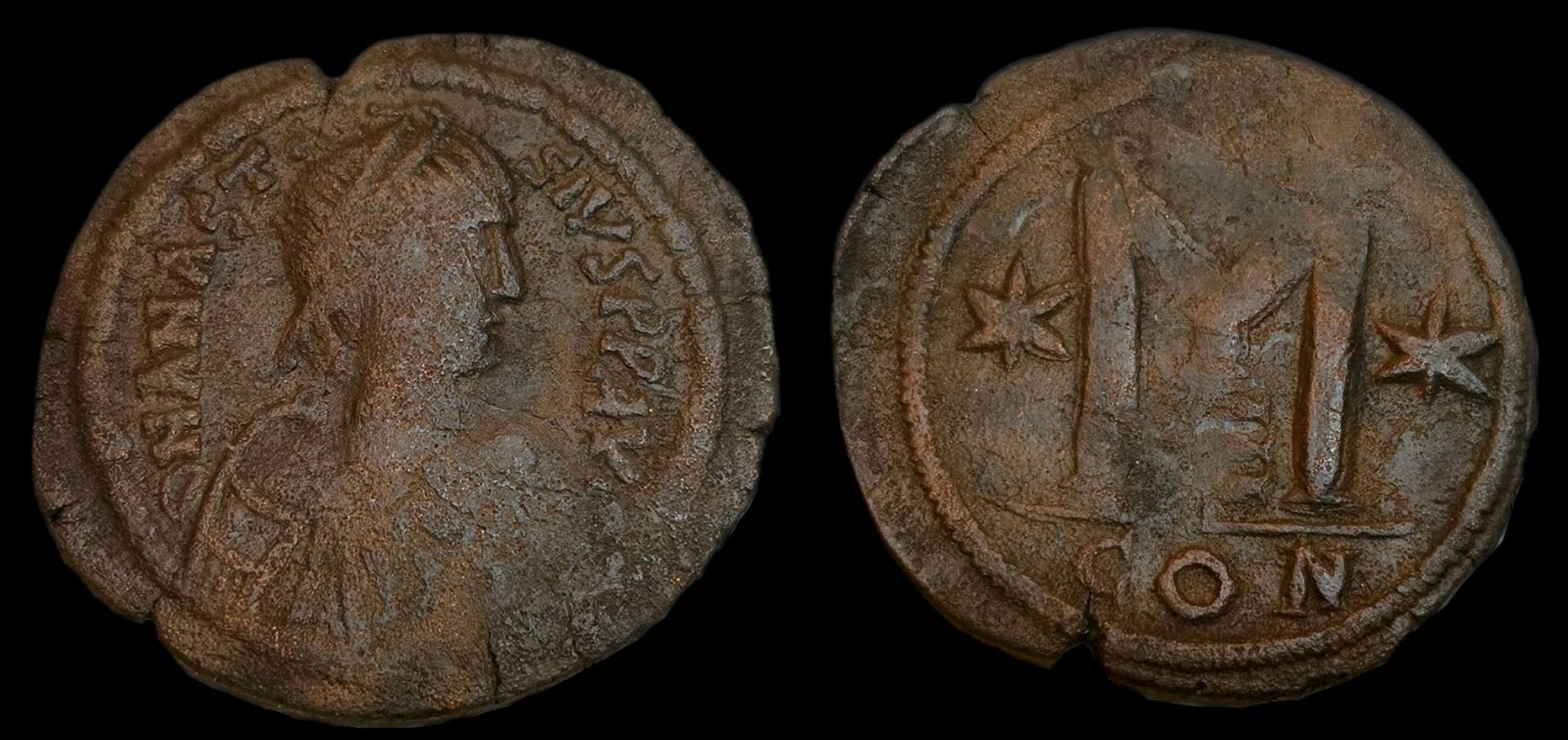
Reverse:
Die Orientation: -
Weight: 17.25 g
(1).jpg)
Reverse: SAECVLI FELICITAS, Felicitas standing left, sacrificing over lighted altar and holding long caduceus, star in right field
Die Orientation: 6 H
Weight: 3.05 g
.jpg)
Reverse: RESTITVT ORBIS, woman standing right, presenting wreath to Aurelian standing left, holding sceptre. Mintmark XXI. Officina VI
Die Orientation: -
Weight: -
(1).jpg)
Reverse: IMP XXII COS XVI CENS P P P, Minerva standing left, holding spear
Die Orientation: 6 H
Weight: 3.22 g
.jpg)
Reverse: CONCORDIA PR, Concordia seated left, holding patera and cornucopiae
Die Orientation: 5 H
Weight: 2.72 g
(2).jpg)
Reverse: PAX AVG, Pax standing left, holding olive branch and vertical sceptre; ML in exergue
Die Orientation: 6 H
Weight: 3.89 g
.jpg)
Reverse: PROVIDENTIAE AVG, Commodus as Hercules standing left with foot on prow, holding club set on tree trunk with left hand, receiving grain ears from Africa standing right, wearing elephant-skin headdress and holding sistrum in left hand, with lion at her feet
Die Orientation: -
Weight: 2.55 g
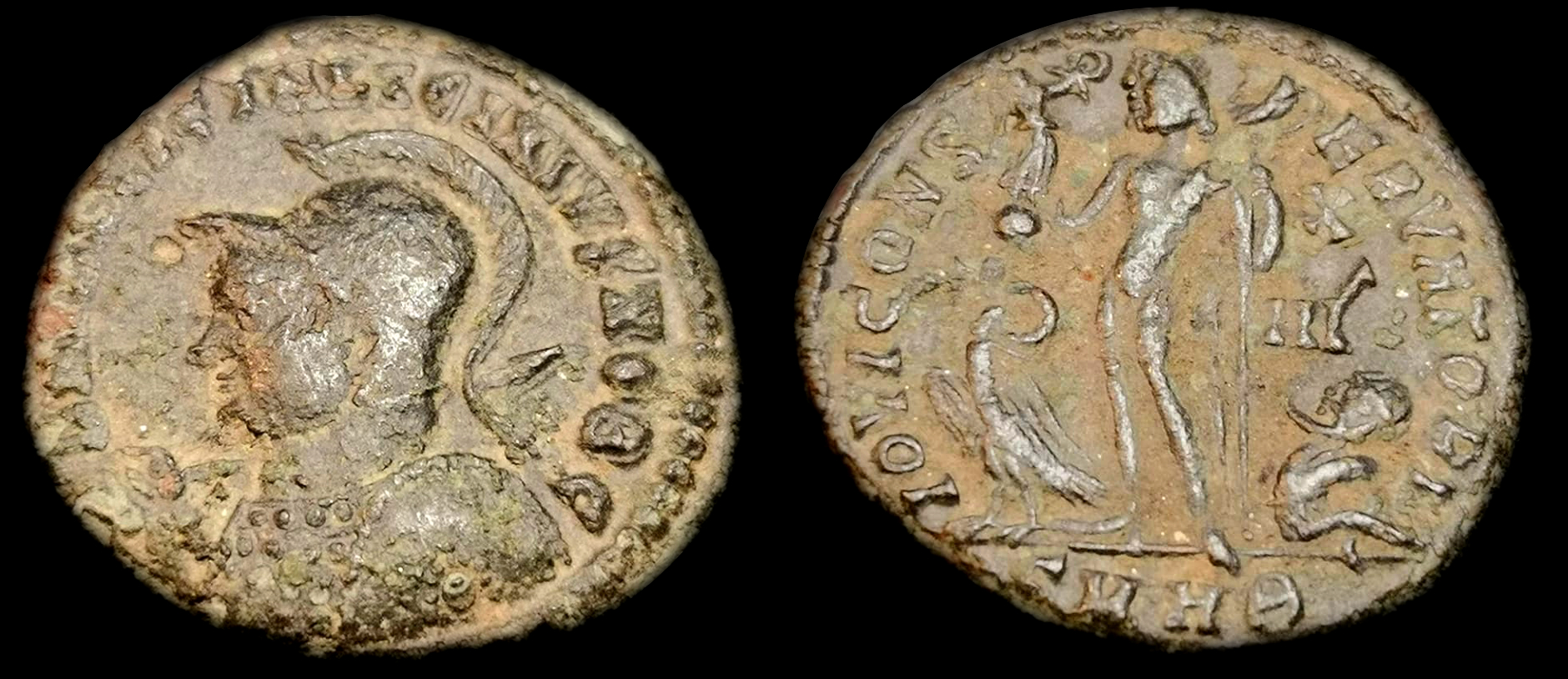
Reverse: IOVI CONSERVATORI, Jupiter standing left, holding Victory on globe and sceptre, eagle with wreath in beak at foot left, captive at foot right, X over II Mu in right field. Mintmark SMHB
Die Orientation: -
Weight: -
(3).jpg)
Reverse: PON MAX TR P COS V, winged caduceus
Die Orientation: 6 H
Weight: 3.04 g
.jpg)
Reverse: CONCORDIA AVGG, Concordia enthroned left, holding patera and cornucopiae
Die Orientation: 6 H
Weight: 2.23 g
.jpg)
Reverse: CONCORDIA MILITVM, Severus standing right, holding short sceptre and receiving Victory on globe from Jupiter standing left, holding sceptre; Δ in central field, ALE in exergue
Die Orientation: 11 H
Weight: 2.97 g
.jpg)
Reverse: BRVTVS, The consul L. Junius Brutus walking left between two lictors preceded by an accensus
Die Orientation: 6 H
Weight: 3.43 g
.png)
Reverse: PROV DEOR TR P COS II, Providentia standing facing, head left, holding globe and cornucopia
Die Orientation: 6 H
Weight: 3.37 g
.png)
Reverse: FIDES MILITVM, Fides seated on throne, facing left, holding military standards; dot in right field; TT in exergue
Die Orientation: 7 H
Weight: 8.05 g
.png)
Reverse: GLORIA REIPVBLICAE, Roma and Constantinople facing each other, each holding a scepter and together holding a shield inscribed VOT V MVLT X; SMNI in exergue
Die Orientation: 5 H
Weight: 4.06 g
.png)
Reverse: CONSERVATORES VRB SVAE, Roma seated facing left, holding globe and scepter, all within hexastyle temple; R*Q in exergue
Die Orientation: 12 H
Weight: 5.6 g
(0).jpg)
Reverse: TR P XXIX IMP VIII COS III, Felicitas standing left, holding caduceus and cornuopiae
Die Orientation: 5 H
Weight: 2.91 g
.jpg)
Reverse: AETERNAE MEMORIAE, Domed shrine with one door open, eagle standing facing right on roof; MOSTP in exergue
Die Orientation: 6 H
Weight: 3.82 g
.jpg)
Reverse: Neptune standing facing left, nude except for draped cloak, holding small dolphin in right hand and trident in left; SC in fields
Die Orientation: 6 H
Weight: 9.97 g
.jpg)
Reverse: PONTIF TRIBVN POTEST ITER. Large SC at center
Die Orientation: 6 H
Weight: 9 g
.jpg)
Reverse: C CAESAR DIVI AVG PRON AVG PM TR P IIII P P, Inscription around large SC
Die Orientation: 5 H
Weight: 10.72 g
.jpg)
Reverse: No inscription, Head of King Aspurgus facing right, wearing diadem; BAP monogram and IB in fields
Die Orientation: 12 H
Weight: 7.76 g
.jpg)
Reverse: AEQVITAS AVGVST, Aequitas standing facing, head left, holding scales and scepter; SC in fields
Die Orientation: 6 H
Weight: 10.28 g
.jpg)
Reverse: No inscription, Domitian standing in military attire, head left, holding thunderbolt and spear, being crowned by Victory at right standing with head left; SC in exergue
Die Orientation: 6 H
Weight: 24.9 g
.jpg)
Reverse: Fiscus, sella quaestoria, and hasta; Q below
Die Orientation: 12 H
Weight: 21.13 g
CNG has this to say:
This issue has previously been attributed to a Macedonian mint with the portrait identified either as Brutus (Friedlander), Caesar (Grant), or to the governor of of Syria, Gaius Sosius (in the trade). RPC presents a case for a Cilician or Syrian origin, supported by find data, with a suggestion that the portrait is Octavian. Issues of similar portrait style, very likely by the same engraver, include the "Princeps Felix" coinage from Cilicia (RPC 4082-3)
.jpg)
Reverse: CONCORDIA EXERCITVVM, Clasped Hands
Die Orientation: 6 H
Weight: 2.96 g
.jpg)
Reverse: ΔPOVΣOΣ KAIΣAP, Bare head of Drusus facing right
Die Orientation: 11 H
Weight: 2.92 g
.jpg)
Reverse: SIGNIS RECEPT DEVICTIS GERM S C, Germanicus bare-headed and cuirassed, right, with tunic standing, left, right hand raised and left holding aquila
Die Orientation: 6 H
Weight: 14.19 g
.jpg)
Reverse: TI CLAVDIVS CAESAR AVG P M TR P IMP S C, Claudius, togate, seated left on curule chair, holding branch in right hand; various arms around
Die Orientation: 6 H
Weight: 23.46 g
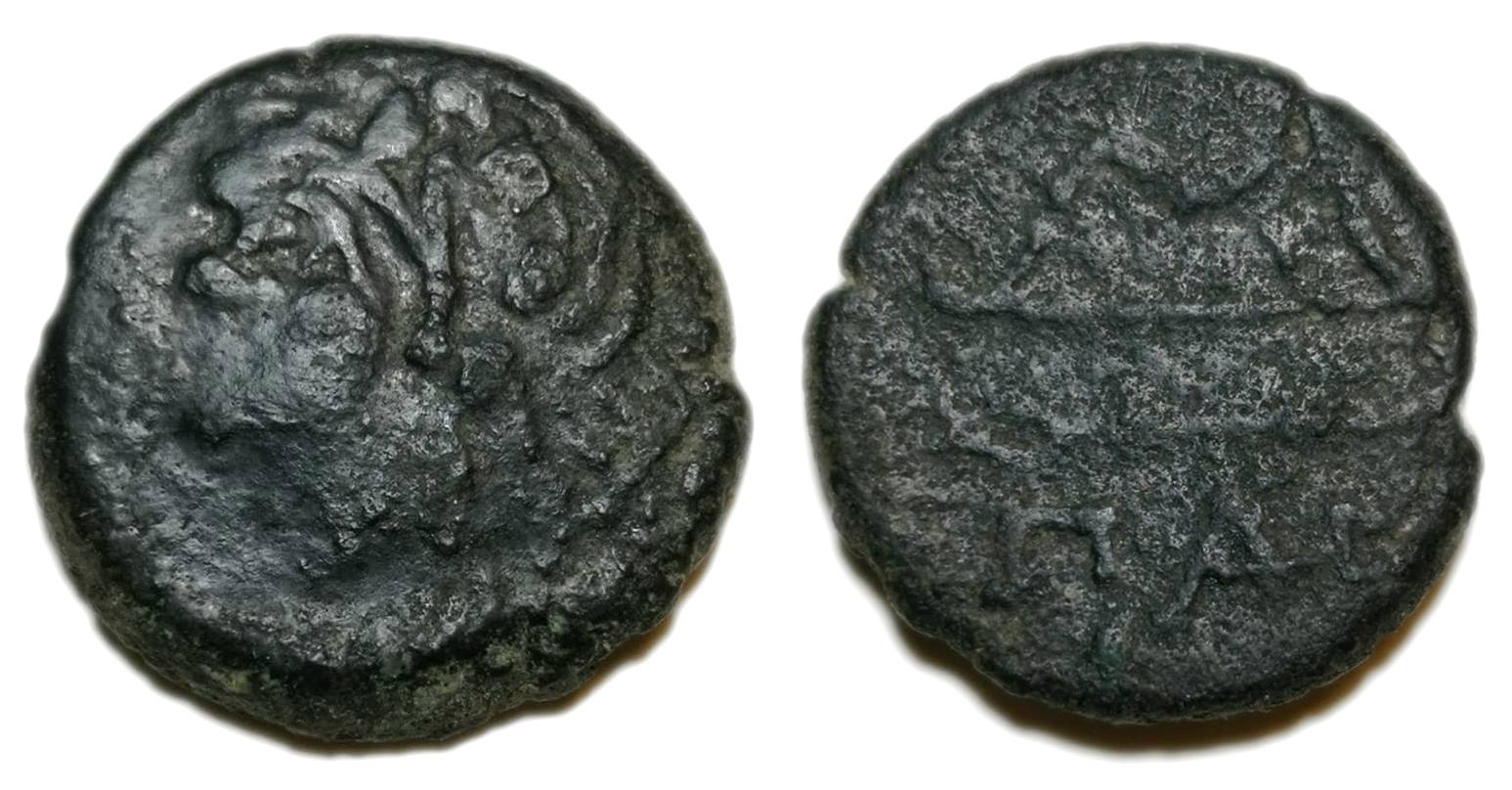
Reverse: Bow above arrow right
Die Orientation: -
Weight: -
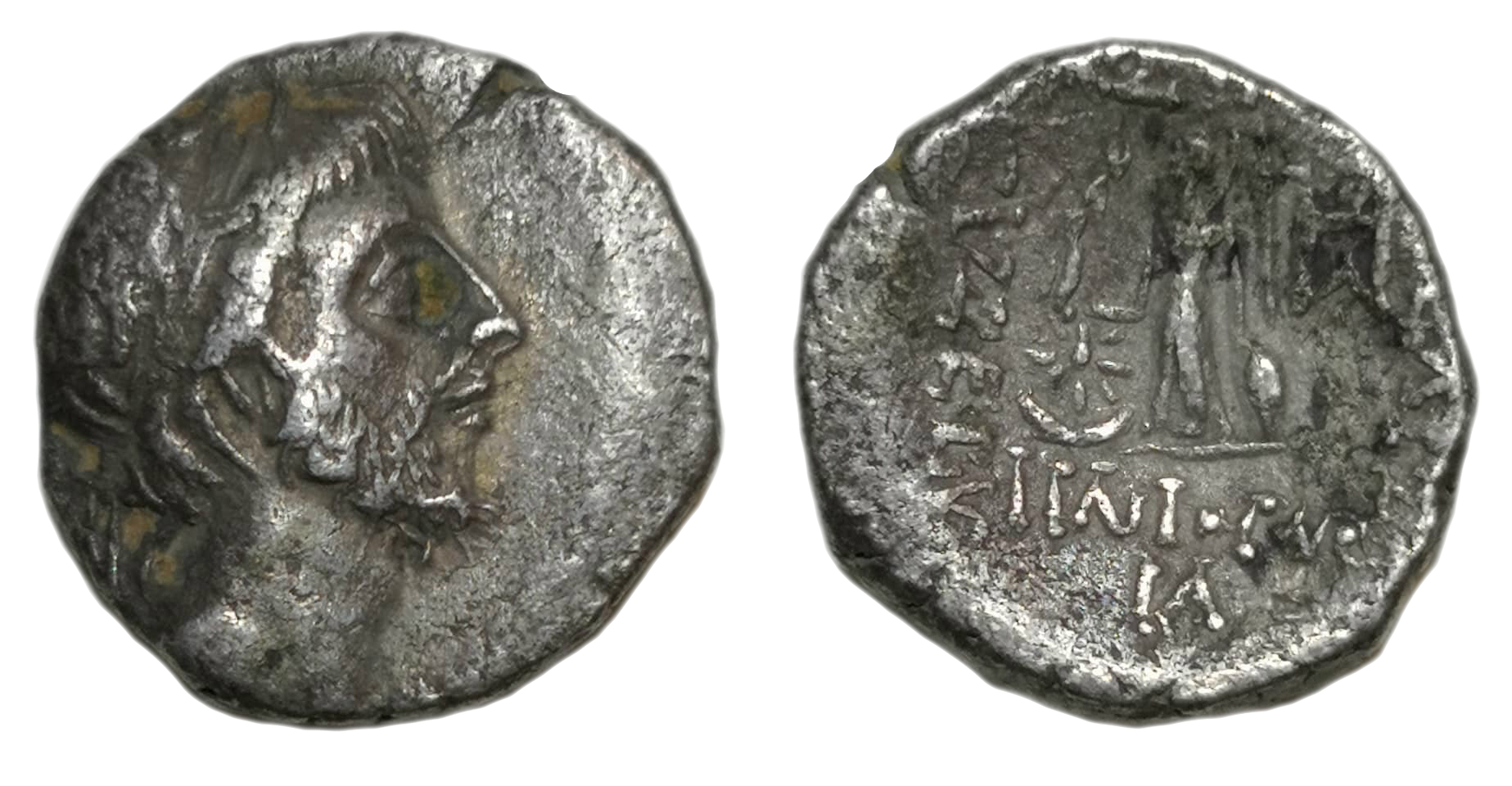
Reverse: ΒΑΣΙΛΕΩΣ ΑΡΙΟΒΑΡΖΑΝΟΥ ΕΥΣΕΒΟΥΣ ΚΑΙ ΦΙΛΟΡΩΜΑΙΟΥ / Athena standing left, holding Nike, spear, and shield; star and crescent to left, monogram to right, IA (date) in exergue.
Die Orientation: -
Weight: 3.54 g
.jpg)
Reverse: LEG V; Legionary eagle between two standards
Die Orientation: 6 H
Weight: 3.7 g
(1).jpg)
Reverse: CONSECRATIO, eagle standing right, head left, upon altar
Die Orientation: 12 H
Weight: 3.05 g
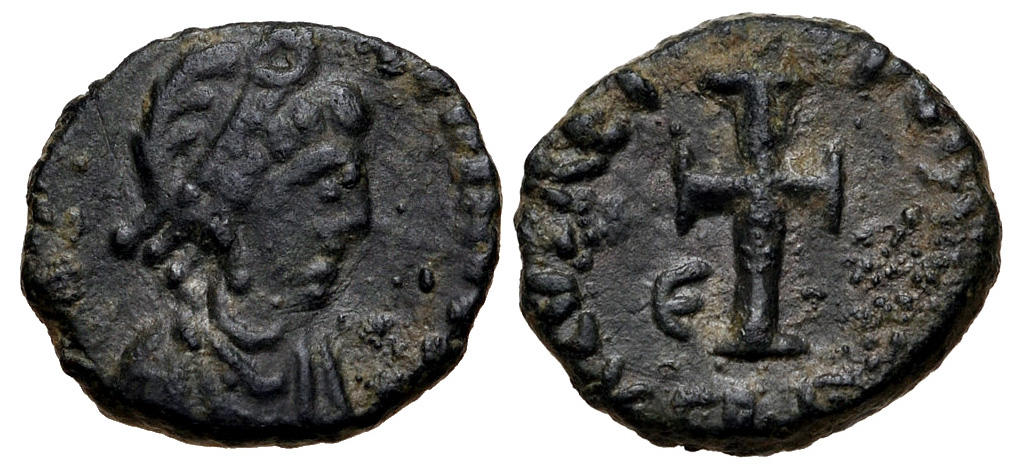
Reverse: SALVS REI P[VBLICE] / RM Cross; in field to left, Є
Die Orientation: 12 H
Weight: 1.7 g
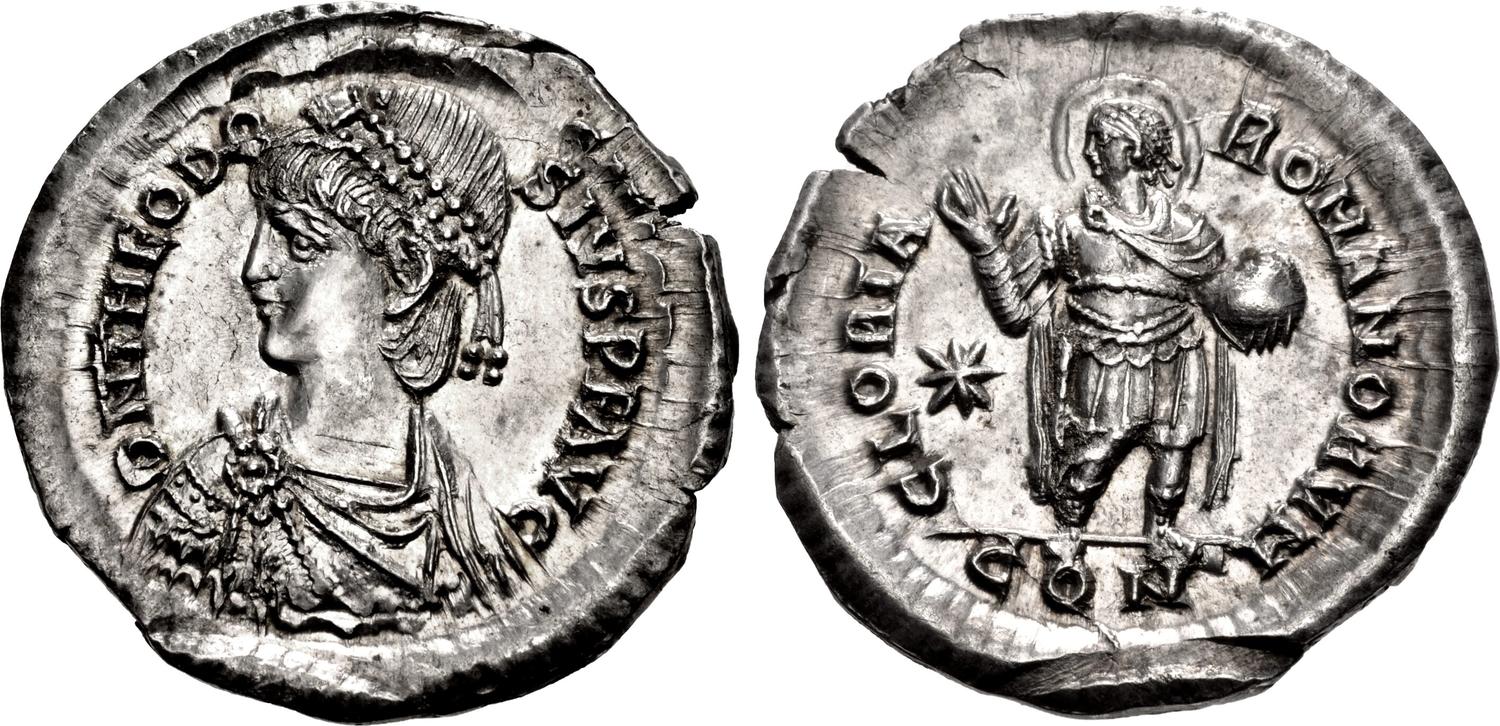
Reverse: GLORIA ROMANORVM / CON Theodosius II, nimbate and in military attire, standing front, head to left, raising his right hand in salute and holding globe in his left; in field to left, star
Die Orientation: 12 H
Weight: 4.26 g
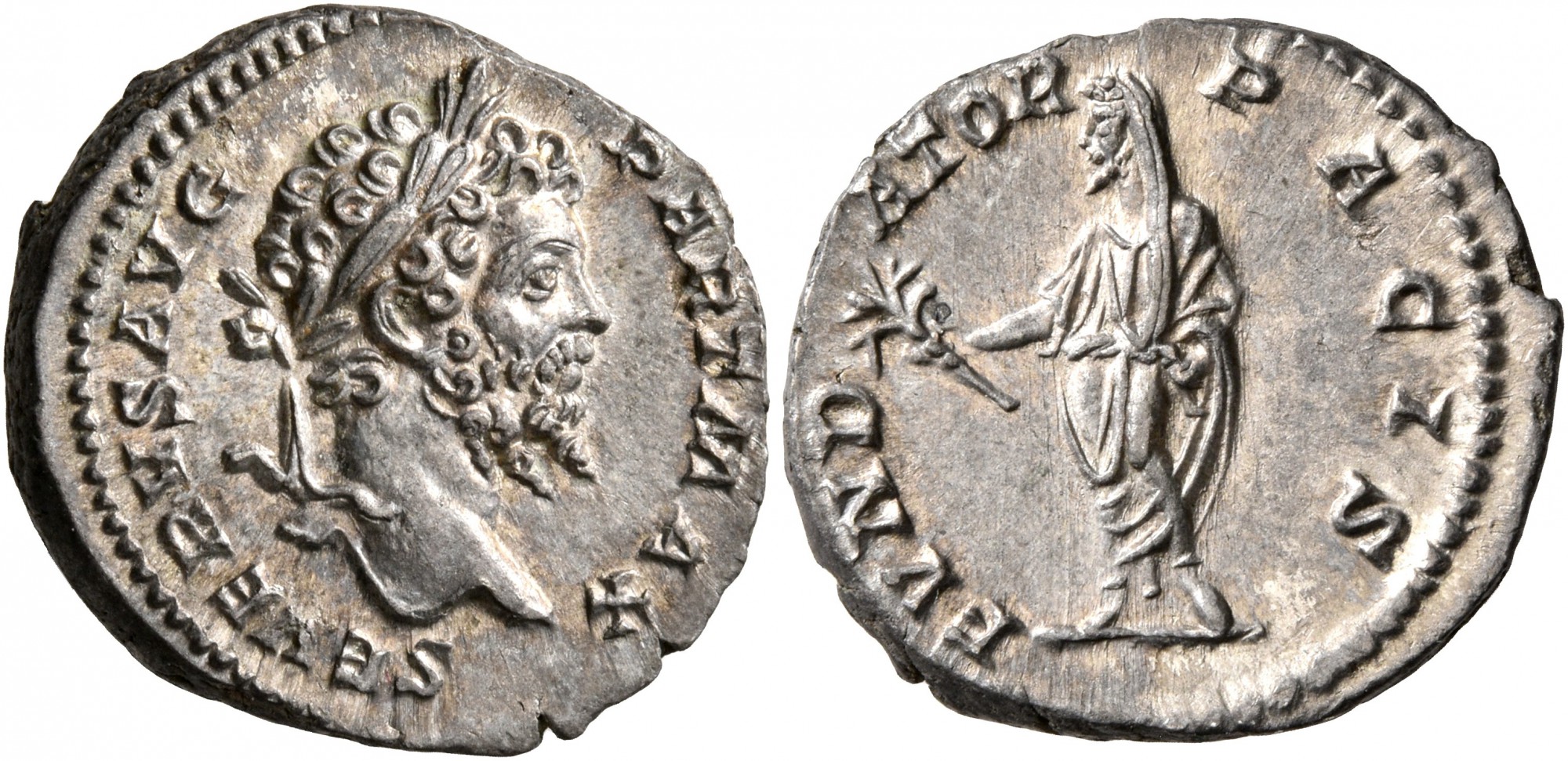
Reverse: FVNDATOR PACIS Septimius Severus, veiled, standing front, head to left, holding branch in his right hand and roll in his left
Die Orientation: 11 H
Weight: 3.2 g
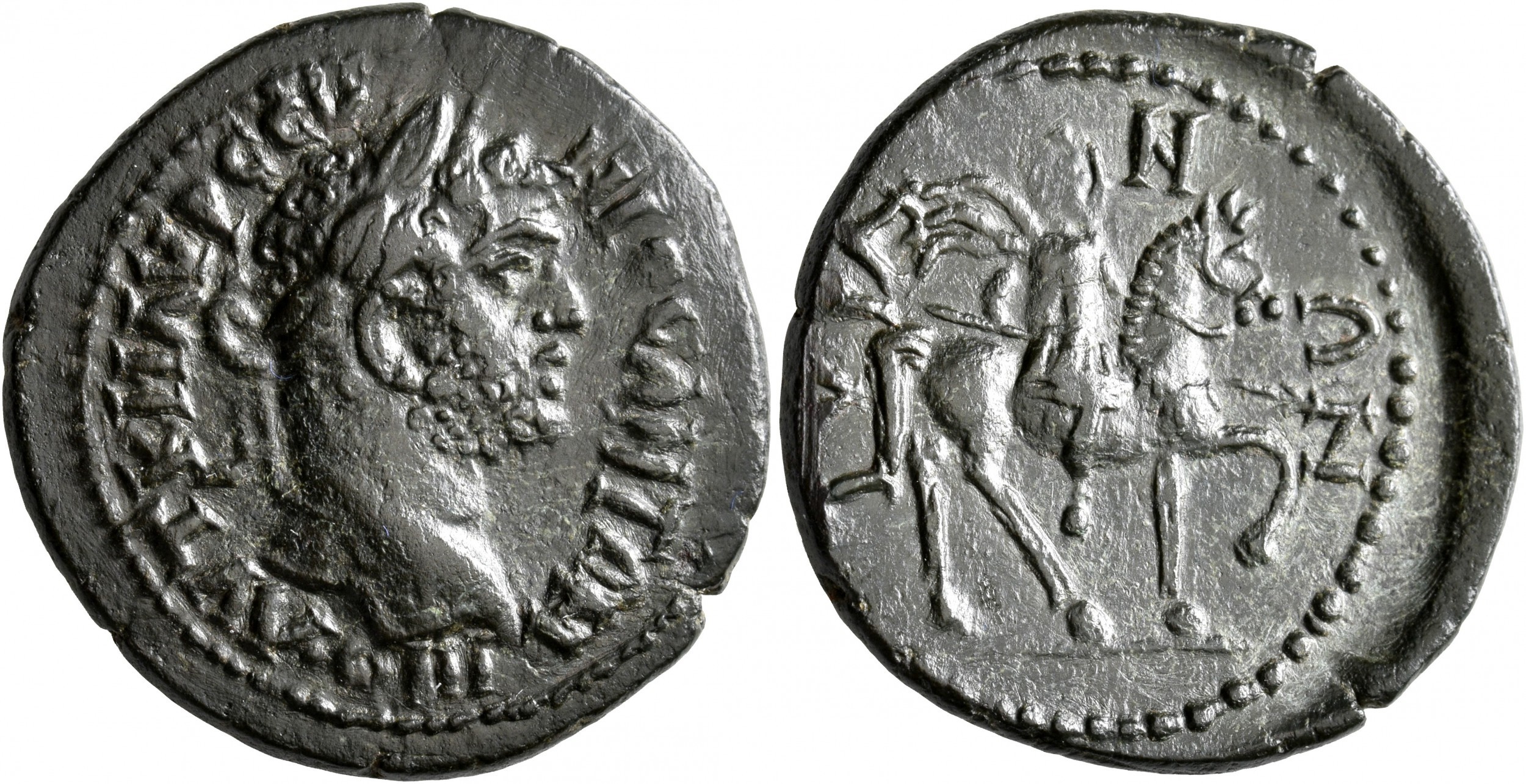
Reverse: ΤΥΡΑΝΩΝ Caracalla, holding spear in his right hand, riding to right
Die Orientation: 7 H
Weight: 9.38 g
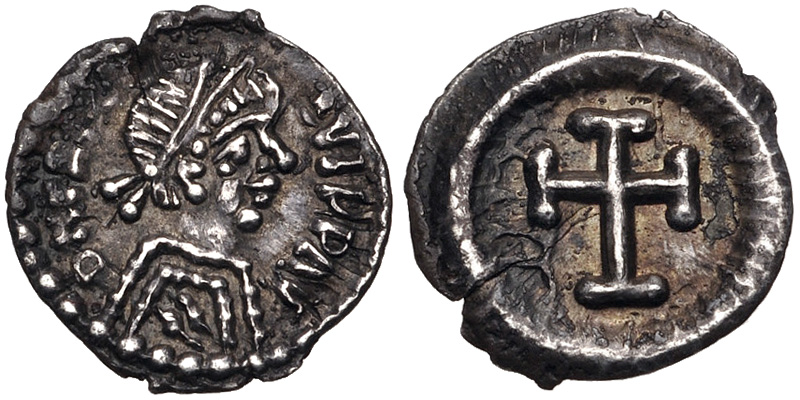
Reverse: Cross potent within wreath
Die Orientation: 6 H
Weight: 0.4 g
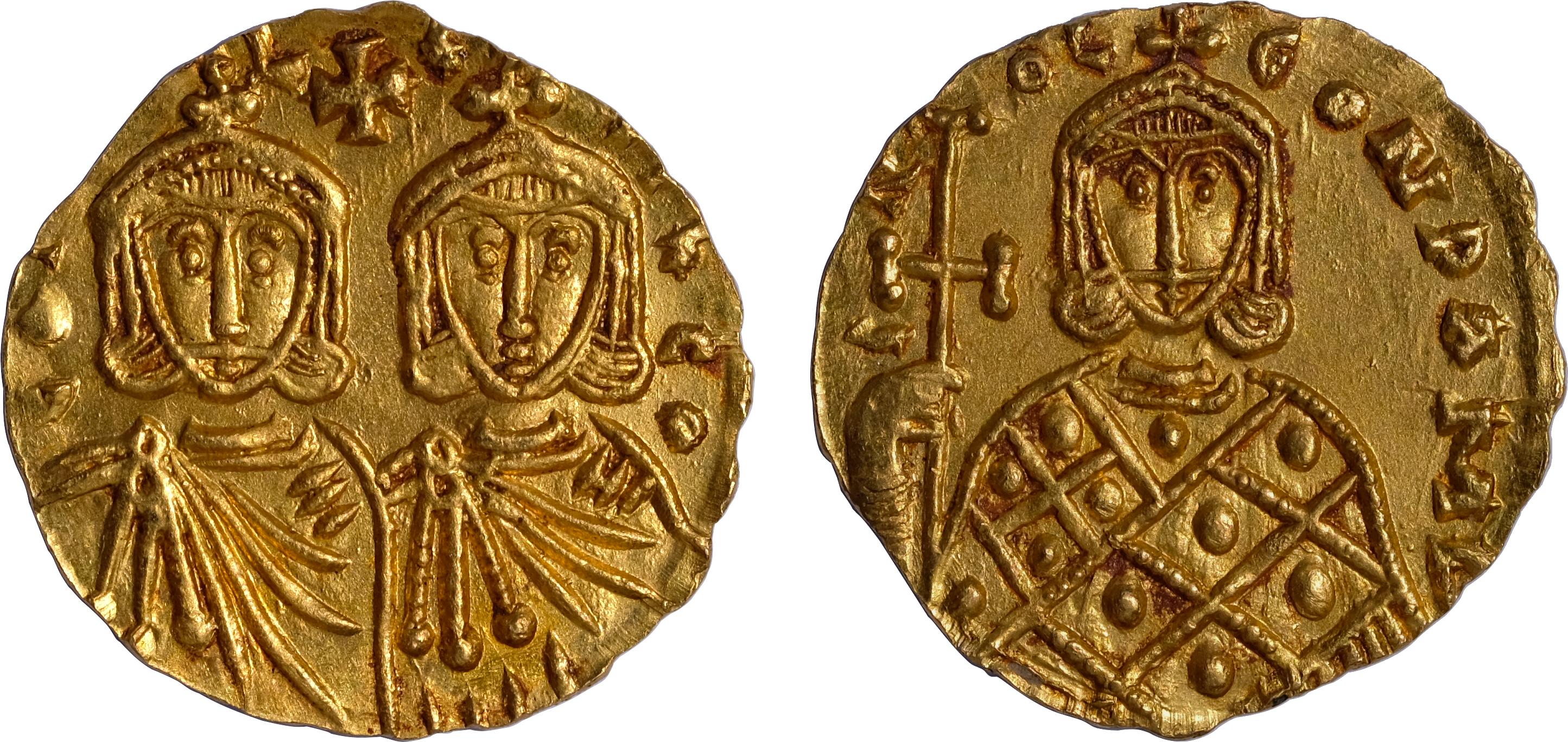
Reverse: GNO LЄON PAMЧ Crowned facing bust of Leo III, wearing loros and holding cross in his right hand
Die Orientation: 6 H
Weight: 3.8 g
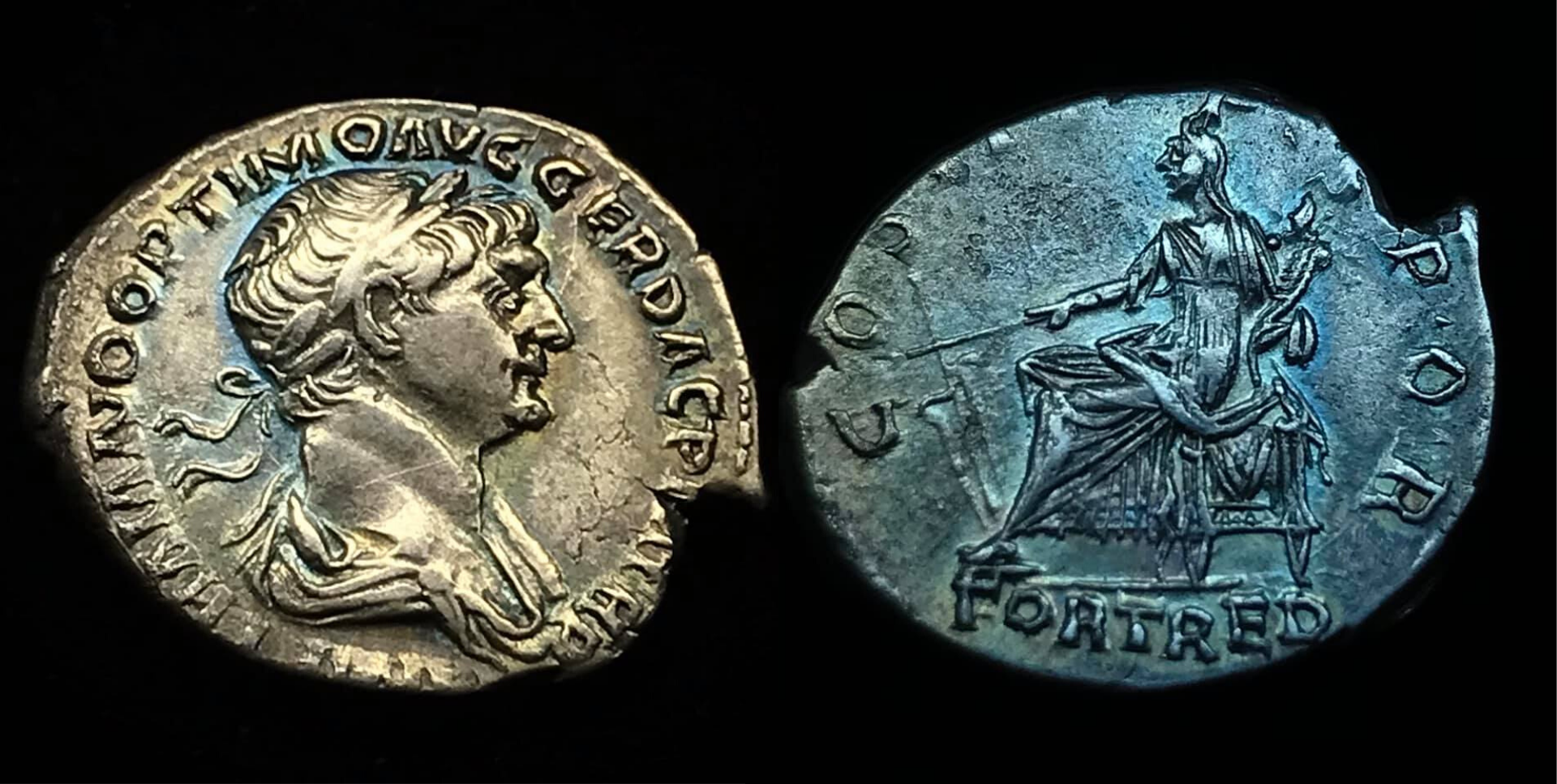
Reverse: COS VI S P Q R, Fortuna seated left, holding rudder and cornucopiae; FORT RED in exergue
Die Orientation: -
Weight: 3.19 g
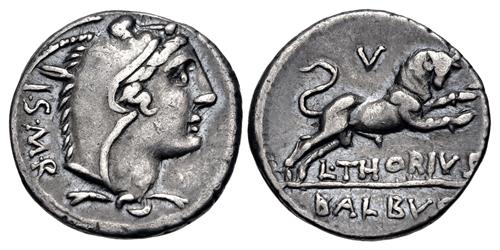
Reverse: Bull charging right; V above
Die Orientation: 7 H
Weight: 3.84 g
Excellent style, with attractive toning. Came with a 1930's hand-written envelope.
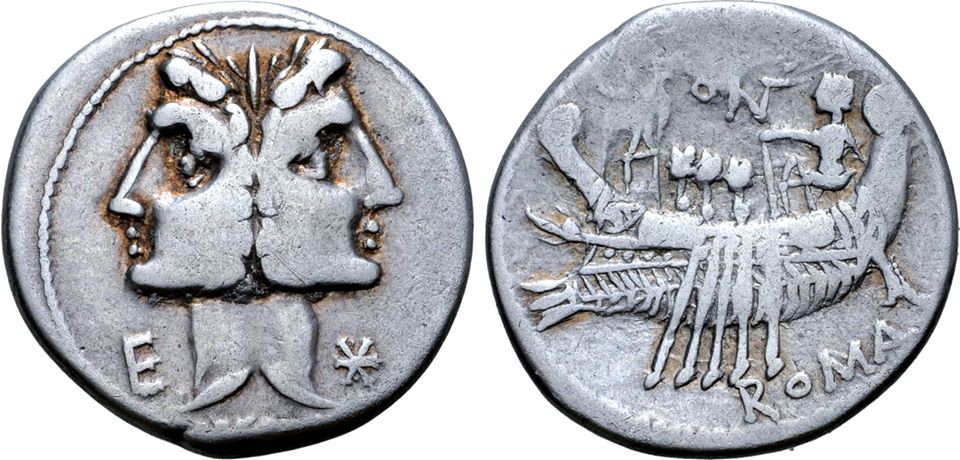
Reverse: Galley left with three rowers, gubernator at stern; C•FONT above, ROMA below.
Die Orientation: 7 H
Weight: 3.7 g
Ex Paul James Collection
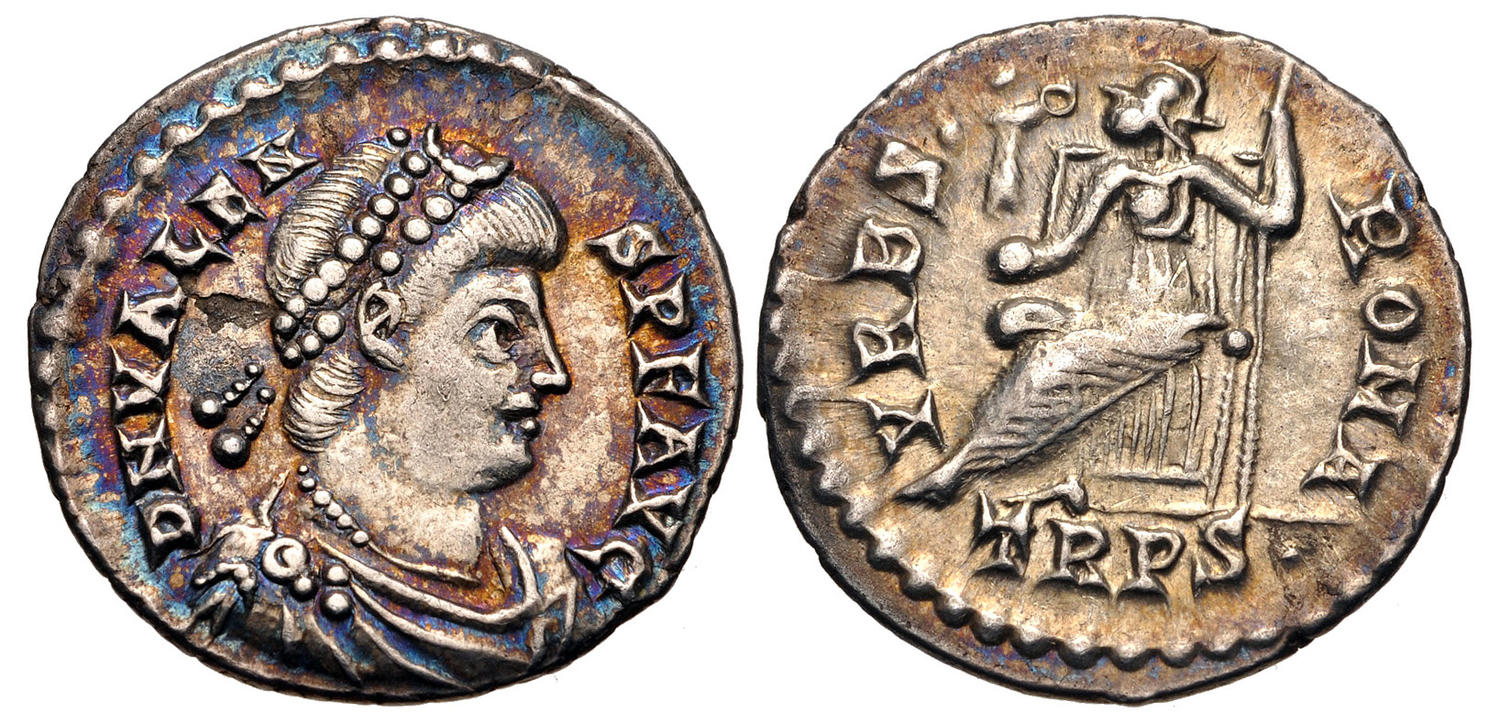
Reverse: Roma seated left on throne, holding Victory on globe and scepter; TRPS•
Die Orientation: 6 H
Weight: 2.15 g
Iridescent toning, small obverse lamintion missing. Good VF.
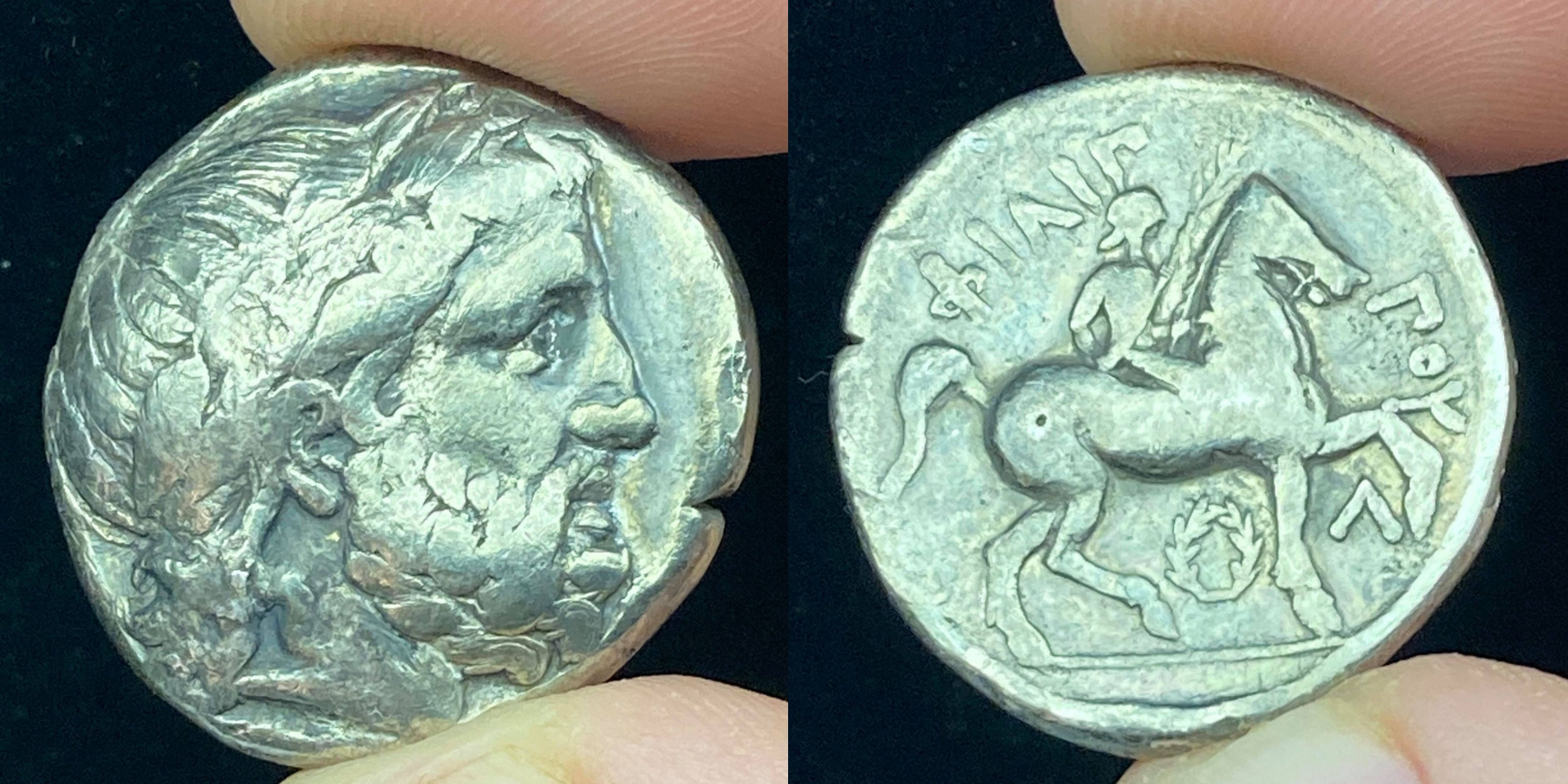
Reverse: Youth, holding palm and reins, on horseback right; wreath below, Λ below raised foreleg
Die Orientation: 0 H
Weight: 13.84 g
Struck under Antipater, Polyperchon, or Kassander
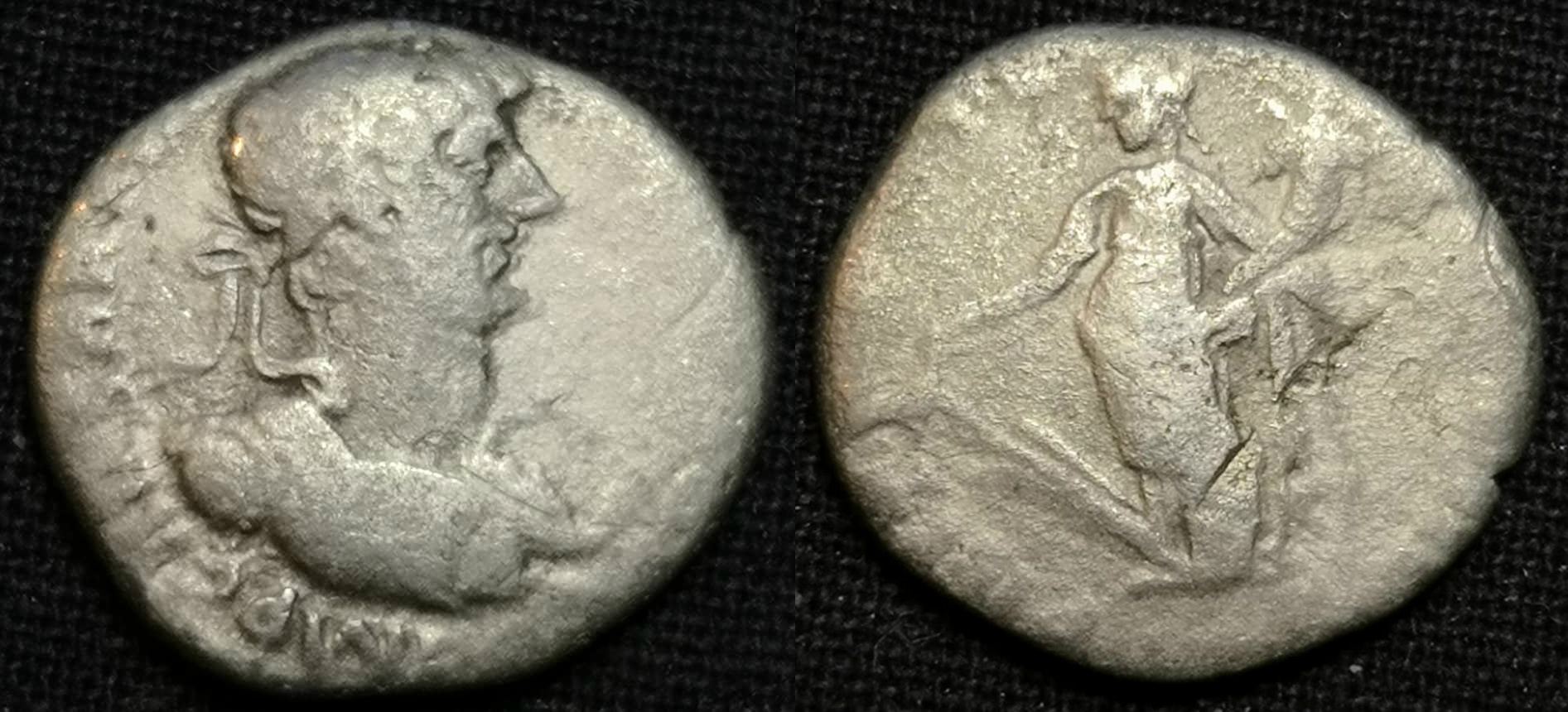
Reverse: P M TR P COS III
Die Orientation: -
Weight: 2.05 g
.jpg)
Reverse: ΒΑΣΙΛΕΩΣ ΑΡΙΟΒΑΡΖΑΝΟΥ ΕΥΣΕΒΟΥΣ ΚΑΙ ΦΙΛΟΡΩΜΑΙΟΥ Athena standing left, holding Nike on outstretched right hand and shield and spear in left hand; in upper right field, monogram; in lower left field, crescent and star; in exergue, [Θ].
Die Orientation: 0 H
Weight: 0 g
